1950
ACCVI executive:
Chairman – Mark Mitchell
Secretary – Nora Piggott
Events:
January 19 – Through the kindness of Mr. Ernest Belton of the National Film Board, the Club saw Len Chatwin’s film on climbing. This film is a composite one, comprising Len’s best shots, taken at several recent camps including some very exposed climbing on Pigeon Spire.
February – Club meeting at the home of the Muriel and Aileen Aylard. Bill Heybroek and Mark Mitchell showed slides of their trips to Switzerland and Tyrol last summer.
April 2- Sections annual banquet at the Union Club on Gordon Street. About thirty members attended. Major Kenneth Hadow, the grandnephew of Douglas Hadow who died on the Matterhorn in 1865, gave an illustrated account of his expedition to Nanga Parbat (Pakistan) in 1932.
February – Club ski trip to Deer Park in the Olympic Mountains.
February – Club ski trip to Mt. Baker.
April (St. George’s Day) – A club hike to Eagle Heights. This involved an ascent of more than 2,500 feet vertical.
April 29 – Rex and Ethne Gibson were the Section’s representatives at a special meeting of the western members of the American Alpine Club.
May 24 – A club trip to Sansum Narrows for a day of rock-climbing and roping-off practice. Fourteen attended.
June 10/11/12 – Club trip to Mt. Landalt and El Capitan Mountain.
July 1/2/3 – A party of nine, including a Vancouver Section member, made a successful ascent of Mt. Shuksan.
August – A club trip to Mt. Maxwell on Saltspring Island.
September – Mark Mitchell led the Labour Day trip to the Olympics Mountains. A further trip is being planned to this range for the Thanksgiving weekend with Mt. Angeles as the objective.
Section members who attended the ACC’s winter ski camp at Mount Robson: Mark Mitchell, Rex Gibson, Ethne Gibson.
Section members who attended the ACC general summer camp at Maligne Lake July 17 to 29: Aileen Aylard, Muriel Aylard, Connie Bonner, Judy Craven (graduated on Mount Henry MacLeod), Mabel Duggan, Nancy Grant (graduated on Mount Henry MacLeod), Rex Gibson, Ethne Gibson, Bill Heybroek, Irene Hudson, Peter Lowes, Bill Lash, Dorothy Lash, Sylvia Lash, Mallory Lash, Jean Merritt (graduated on Mount Charlton and Mount Unwin), Mark Mitchell, Gertrude Snider, Margery Thomas (graduated on Mount Charlton and Mount Unwin)
The oldest member of the Alpine Club of Canada is John B. Kay of Victoria. He joined the club in 1909 and is now 93 years of age.
Ski Spot for Southern Vancouver Island
Outdoor Club of Victoria Seeking Aid for New Area
Reported in The Daily Colonist Sunday January 15, 1950. p.9.
Most people are of the opinion that the only worthwhile skiing grounds on Vancouver Island are located north of Courtenay. The Outdoor Club of Victoria whose members have tried out a new area believe the Mount Brenton slopes are equal to any novice or expert and only a little over an hour’s drive from the capital city. For five months during the winter of 1948-49, members of this club enjoyed excellent skiing each week-end at Mount Brenton, a few miles west of Chemainus. Again this winter members are making the short drive from Victoria to the area, skiing to their heart’s content and returning to Victoria the same day.
Use Logging Roads
Early in November, 1948, the club obtained permission to use private logging roads giving access to the mountainous area west of Ladysmith and Chemainus. Here the height above sea level rises to almost 4,000 feet. This altitude is sufficient, members assert, to guarantee ideal snow conditions in any year, however mild. Due to the depth of snow, the roads would have been impassable if they had not been kept open for the logging company’s operations. Thanks to the co-operation of the company, club members, in parties of twenty to thirty-five, were able to enjoy skiing until late in April. This winter they are hoping for the same experience and have already made a number of trips to the area. The first heavy snow fell this winter on November 30.
Informal Group
The Outdoor Club of Victoria is an informal group of about 100 members participating in the outdoor activities of hiking, camping and skiing. The club has been active since 1940 and has introduced to many residents of Vitoria the pleasure of the great outdoors. Each summer camping trips are organized in such diverse areas as the Forbidden Plateau, Della Falls, Garibaldi Park and the Olympic National Park in the state of Washington. Day hikes are also conducted throughout the year in areas near Victoria, getting to know Southern Vancouver Island, the best parts of which, members say, cannot be seen from the highways.
Lessen Cost
In previous years members were able to ski only in such areas as the Forbidden Plateau and the American and Canadian resorts on the mainland, all of which require a full week-end and considerable expense for travel and accommodation. They believe that Mount Brenton is the answer to their search for convenient ski grounds. In order to make it available to all, the club has approached the Provincial Government with the proposal that the area be taken over as a park. Club president Gordon Bowes says: “Our Island, so richly endowed in all other respects, lacks only an easily-accessible winter recreation area. The sport of skiing has attained a tremendous popularity elsewhere in Canada. Here is our opportunity to include skiing in the varied attractions offered by Southern Vancouver Island. The Mount Brenton area provides perfect skiing conditions for at least four months even in the mildest winter. It could be made accessible at little cost merely by grading the existing privately-owned logging roads in the area and keeping them clear of snow. The present owners could be offered Crown lands elsewhere in exchange. The creation of a Provincial Park, to include the northern and western slopes of Mount Brenton and the Brenton, Holyoak and Silver Lakes, is imperative while some of the beautiful stands of timber remain. Such a park would at last provide ideal conditions for both winter and summer recreation for the 140,000 residents of Southern Vancouver Island, from Victoria to Nanaimo. With its open, subalpine plateau and its magnificent views of the gulf and the mountains beyond, Mount Brenton could be developed at minimal expense to serve our Island communities as Mount Seymour Park now serves Vancouver.
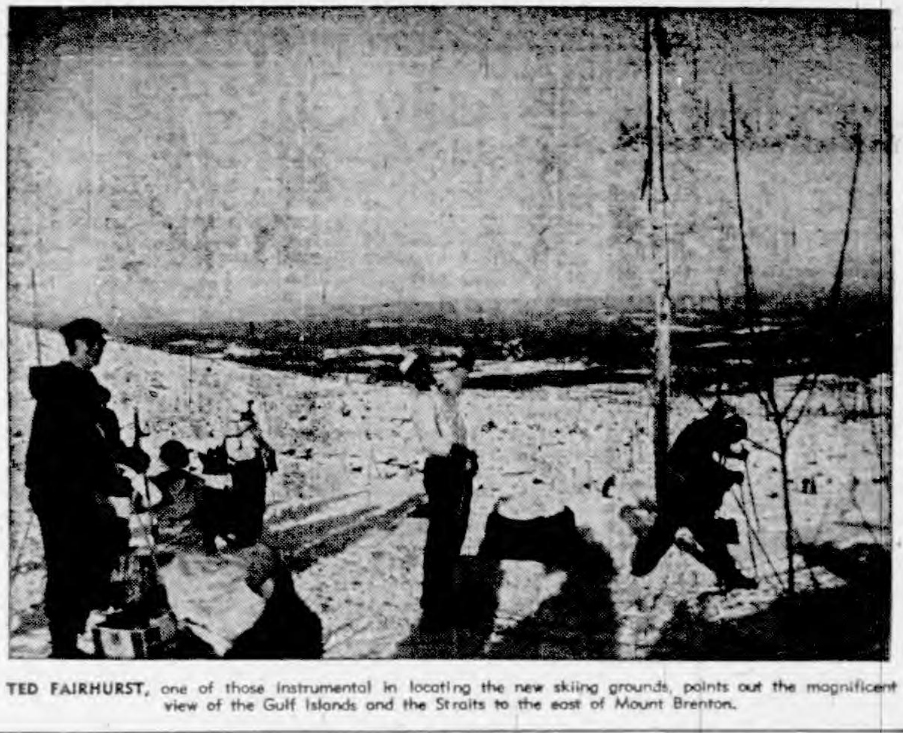
TED FAIRHURST, one of those Instrumental in locating the new skiing grounds, points out the magnificent view of the Gulf Islands and the Straits to the east of Mount Brenton.
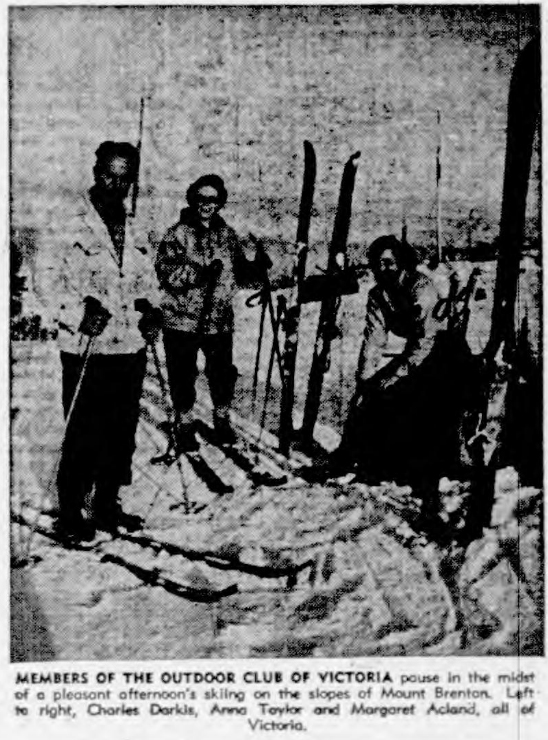
MEMBERS OF THE OUTDOOR CLUB OF VICTORIA pause in the midst of a pleasant afternoon’s skiing on the slopes of Mount Brenton. Left to right, Charles Darkis, Anna Taylor and Margaret Acland, all of Victoria.
Ski Tourney at Smith’s Hill
Good Sport on Sunday in Courtenay
Reported in the Comox Argus Wednesday January 18, 1950. p.1.
Under the director of Mr. Herb Bradley, a ski tournament was held on Smith’s Hill on the Back Road on Sunday under excellent conditions. Results were: Junior Girl’s; Marilyn Pimm 23 1.5, Margaret Morrison 26, Linda Williams 27. Junior Boy’s; Gerald Fitzgerald 21, Ted Carlson 23 1.5, Philip Bickle 29 1.5. Senior Girl’s; Gladys Andrews 32 1.5, Betty Natfield 33 4.5, Ruth Masters 34 1.5. Men’s; Stan Rushton 17 2.5, George Hobson, Alan Simpson both 18 4.5
Courtenay to Stage Several Ski Tournaments at Plateau
Reported in The Daily Colonist Saturday February 18, 1950. p.24.
Four major ski tournaments will be held on the slopes of Forbidden Platea ski field, according to announcements made by Herbert Bradley of the Courtenay recreation Association, and Mrs. Irene Chambers of Forbidden Plateau Lodge. They are: Courtenay Recreation Association’s Kandahar race for the Kandahar Trophy March 12; Forbidden Plateau Ski Club’s downhill for men, women, novices and juniors for The Daily Colonist Trophy, The Victoria Daily Times Trophy, and the Vancouver Island Coach Lines Trophy, March 26; Fanny Dunkers Junior Ski Club combined slalom and downhill closed contest for the Wells Gray Trophy and the E.W. Bickle Trophy, and Vancouver Island Open Championships, staged by the Comox District Mountaineering Club. The last named event will be a two-day tournament, with slalom races scheduled for April 9, and downhill races on April 10. The Kandahar race will begin at the forest service lookout and run through a bush trail that includes some near-vertical drops, to Forbidden Plateau Lodge. Present holder of the trophy is Stanley Rushton of Courtenay. Forbidden Plateau Ski Club’s downhill event will follow a much easier course to the lodge. Fanny Dunker’s tourney will be held on Timberline Hill, above the lodge, and will feature downhill and slalom races over a tricky course. Island ski championships will be held atop Mount Becher.
Mt. Brenton Area Said to Offer Excellent Skiing
Reported in The Daily Colonist Saturday March 11, 1950. p.14.
Excellent skiing in the Brenton area, near Chemainus, is reported by Gordon Bowes, president of the Outdoor Club of Victoria whose members hope to make another excursion Up-Island this week-end. The club president reports increasing support in the campaign for preservation of the Mount Brenton area as a provincial park. Club members have found the district ideally suited for a winter and summer recreational area, and it is their hope that such a zone could be developed for the southern part of the Island. At present, skiing members of the club use a logging trail to get into the fine hills.
Fine Resort Site Seen in Mt. Brenton Area
Reported in The Daily Colonist Wednesday March 15, 1950. p.13.
An informal organization of 100 members, the Outdoor Club of Victoria, is in the midst of a campaign to have Mount Brenton area, which lies a few miles west of Chemainus, established as a Provincial parl. Last Sunday, 35 skiers made the trip to the mountain’s slope and again returned with enthusiastic reports of the section’s possibilities as a year-round resort.
Variety Of Slopes
Rising to almost 4,000 feet, the skiing area includes slopes to suit both the beginner and expert. In a normal Winter, snow of a suitable depth for the barrel-stave pastime is said to remain for about four months. This year, however, the heavier-than-average snowfall is expected to provide a suitable surface until the end of April. Not only does the area offer great potentialities for Winter sports, sys the outdoorsmen, but the sub-Alpine, with its beauty and fish-stocked lakes, is ideal for anglers and campers in the Summer-time. With the southern end of Vancouver Island lacking in a good Winter sports resort, the designation of the section as a park, and its eventual development, would provide excellent skiing within easy reach of South Island communities.
Not Seeking grants
Officials of the Outdoor Club emphasized that they would not seek any money grant. They desire only to have Mount Brenton area set aside as park land an occasional assistance in keeping the roads clear of snow in Winter. While the snow lasts, members of the organization will drive to the area each week-end for their downhill sport.
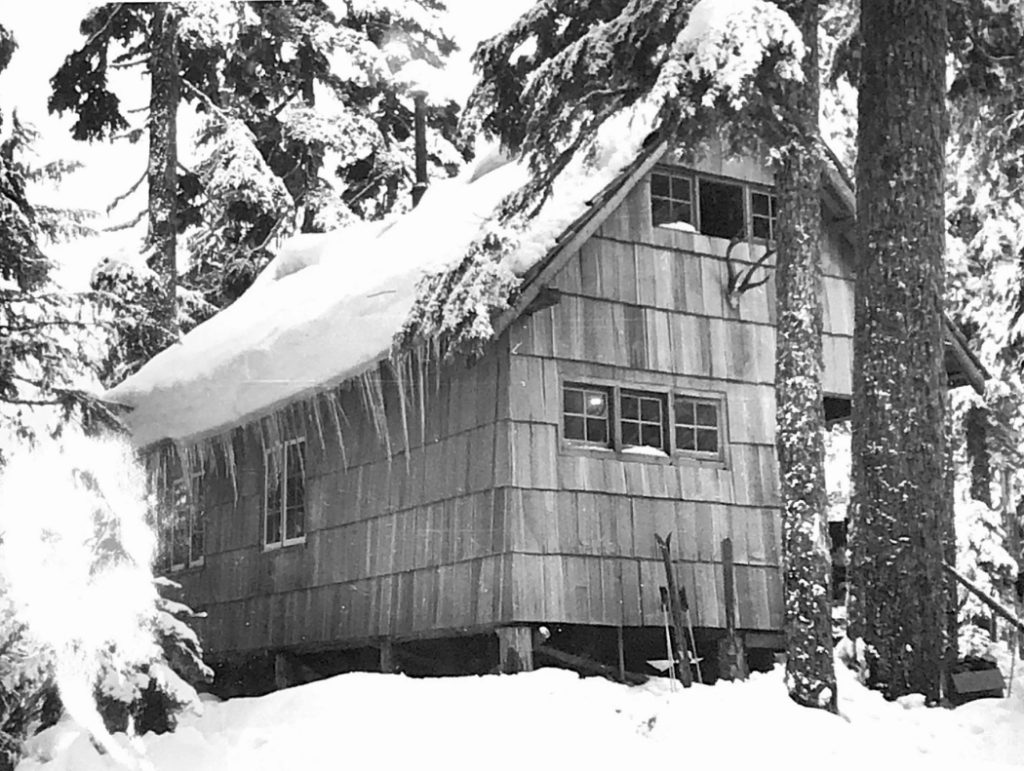
Mt. Brenton Cabin
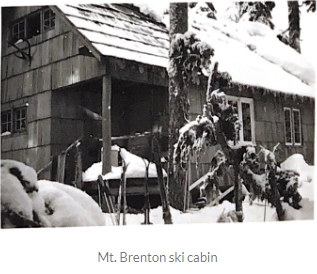
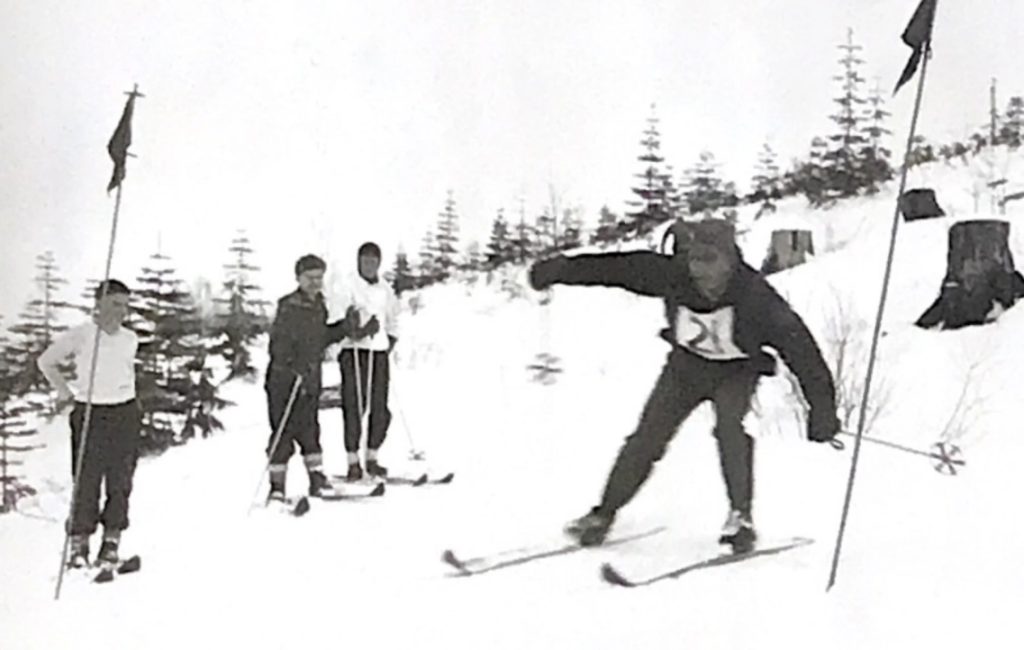
Mt. Brenton Skiing
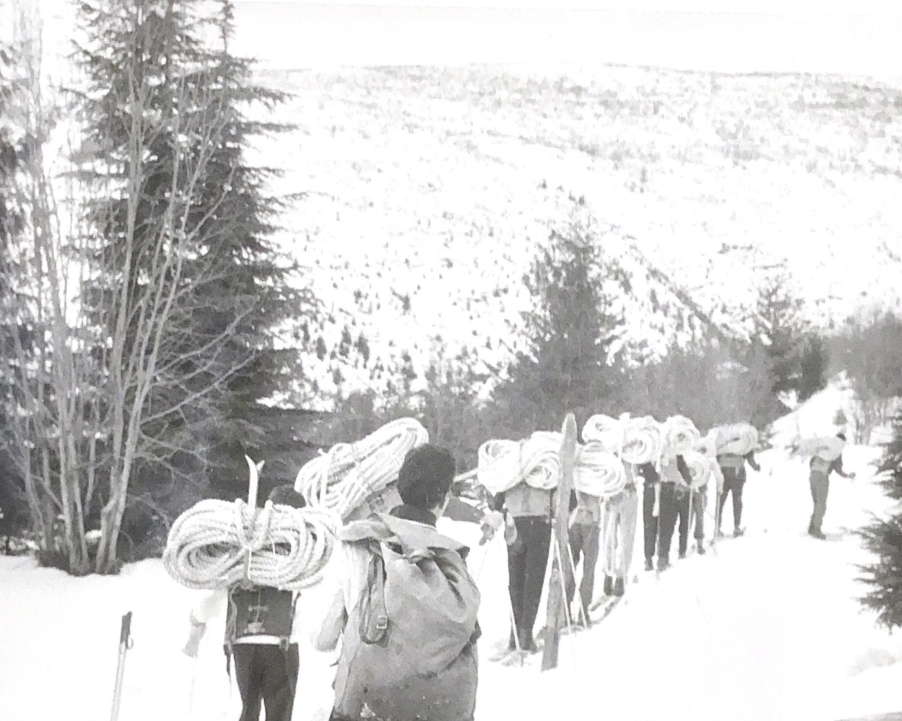
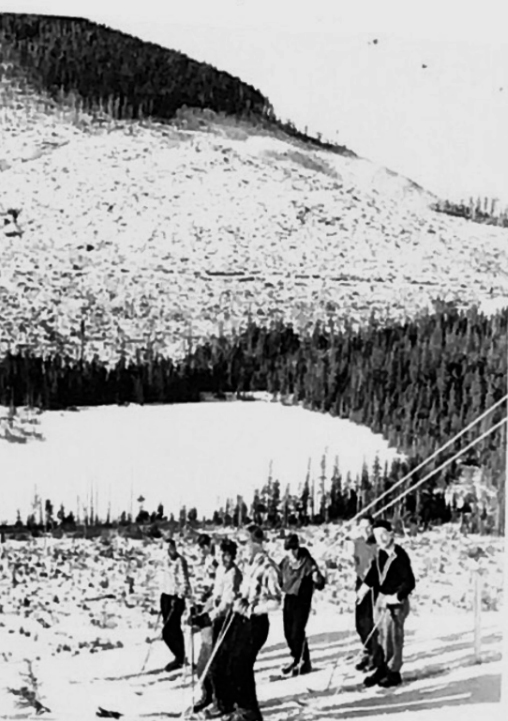
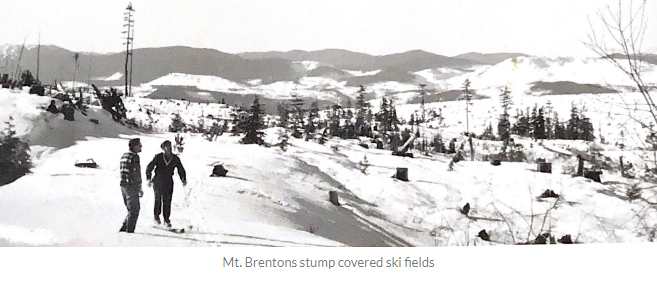
Mt. Brenton’s stump-covered ski fields
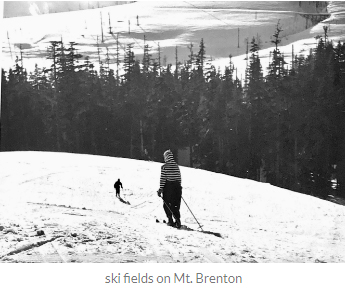
Ski fields on Mt. Brenton
Tourist Group to Study Possibilities of Mount Brenton Area
Reported in The Daily Colonist Thursday March 16, 1950. p.13.
Kelly Porter has been named chairman of a special Chamber of Commerce tourist trade group committee which will make a study of the Mount Brenton area—near Chemainus—as a result of a suggestion from the Outdoor Club of Victoria that the area be developed into a Provincial Park. At its meeting the tourist trade group went on record as being in favor of the proposal. It was noted the area in question was ideal for skiing in Winter months and a sportsman’s paradise in Summer. The Outdoor Club of Victoria has already brought the matter to the attention of the Provincial Government, and is now seeking support from various organizations of the Island. At a previous discussion on the Mount Brenton area, held by directors of the Chamber of Commerce, it was reported the land was privately owned. One of the directors, however, suggested an exchange might be made in which the owning interests would receive a grant of Crown land. Members of the tourist trade group also discussed resorts of Vancouver Island and their cleanliness. Discussions were based on a letter from E.C. Postgate, 900 Park Boulevard, in which complaints were leveled at several resorts which reportedly could do with some cleaning up. Several members were definitely agreed that “some of the Island resorts do need improvement along the lines of cleanliness.”
Strathcona As National Park
Mr. Geo. Warren Speaks To “River” Chamber of Commerce
Reported in the Comox Argus Wednesday March 22, 1950. p.13.
CAMPBELL RIVER, March 21—About 40 people attended a meeting of the Campbell River and District Chamber of Commerce, held in the Willows Hotel last Monday evening, March 20th, and heard an interesting address by George I. Warren of Victoria. Mr. Warren, who is secretary of the Associated Chambers of Commerce of Vancouver Island, and a member of the Victoria and Island Publicity Bureau, spoke on promotion of tourist trade and his desire to see Strathcona park developed. In describing the beauties and merits of Strathcona Park that speaker said that this was a subject near and dear to his heart. He made periodic visits to Ottawa during the past 20 years asking the Federal Government to make Strathcona a national park. He pointed out there are no national parks west of the Rocky Mountains. The idea for the development of a public park on Vancouver Island originated with the Victoria Board of Trade. In March 1905 a committee met with premier McBride, laid the plans appropriation for a survey before him, and had asked for the building of roads into the area. In 1910 the committee again waited upon the Premier and reminded him of his expressions of sympathy with the idea made five years earlier, and in 1911 a special act of the Provincial Parliament was passed setting aside the area as a provincial park, the first in the province. Strathcona park contains 529,920 acres and it covers an area of 800 square miles. It is located in the centre of Vancouver Island 120 miles from Victoria, 100 miles from Vancouver and 20 miles from Alberni. According to a folder produced by the provincial government in 1921, the area contains some of the finest and most diversified scenery in the world. It boasts a profusion of nature’s wonders and is ideal for hunting and fishing.
Buttle Lake
One of the main attractions described is Buttle Lake, named after John Buttle, who explored the area in 1865. Located approximately 25 miles from Campbell River, the re-opening of the trail leading to this lake is one of the projects being sought by both the Local Chamber and the Fish and Game Association. In concluding, Mr. Warren suggested that the tourist committee, as a major development, try to get some action on the park, and that all Chambers on Vancouver Island should get together and press for its development. The business portion of the meeting dealt with the question of repairs and improvements to the road through the Indian Reserve which leads to the Spit. William Roberts, speaking for the Indians, asked that the Chamber assist in obtaining repairs, because the road is used so much by tourists going to the Spit at the river mouth, to fish for the famous Tyee. President Len Rossiter said that a committee is already working on the matter, which hopes to give a report, possibly at the next meeting.
Ideal Recreation Area Seen in Mount Brenton
Reported in The Daily Colonist Thursday March 23, 1950. p.31.
Mount Brenton near Chemainus, is the answer to the year-round recreation needs of southern Vancouver Island, declared Gordon Bowes, president of the Outdoor Club of Victoria, at a meeting last night at St Mary’s Hall. “Other than a few picnic grounds, there are at present no accessible parks on the lower Island,” Mr. Bowes said. “This is in spite of the Provincial Government’s stated policy of providing outdoor recreational centres in locations where they can be enjoyed by the greatest number of people.” He added that it was true that British Columbia possessed large areas of park lands, but the greater part wee inaccessible to persons of average means.
Claimed Forgotten
“Compared to Vancouver and the lower Mainland, Vancouver Island has been forgotten,” the speaker claimed. “I don’t mean to imply that the Government has deliberately neglected us, for the small and efficient Parks Devision staff has done its best with very limited funds.” He declared that the recreational areas now being developed on the Mainland were of little direct benefit to Vancouver Island. Mount Brenton, according to Mr. Bowes, has already been investigated by Government experts and they admit the area possesses valuable park possibilities. “We have pointed out that the region could be obtained by an exchange of Crown lands, and the only necessary cost would be the maintenance of one already-established road, and occasional snow clearing in the Winter,” he said. Mr. Bowes added that the club would welcome the operation of a ski tow by private interests. “Our proposal has been strongly supported by the city councils of Nanaimo, Duncan and Ladysmith, and many other organizations and individuals,” the speaker declared. He warned that it was imperative that Mount Brenton be preserved now, even if only for future development. “If the present owners complete the logging of the area this Summer, its major attraction would be lost,” Mr. Bowes concluded.
Describes Trip
Pat Guilbride, a member of the Alpine Club who lives in Chemainus, described to members a recent two-day snowshoe trip he made to Mount Brenton Lakes. He spoke in glowing terms of the region and stated that his community was solidly behind the Outdoor Club’s proposal. Miss Margaret Ackland concluded the evening with a discussion of skiing and ski development. She also showed two special films on skiing in the Canadian Rockies.
Ski Club Dance
Reported in the Comox Argus Wednesday March 29, 1950. p.8.

The 5th Annual Ski Club Dance Native Sons’ Hall, Saturday, April I 10 p.m. Prizes, Novelties, Laughs
Winter Playground Near Chemainus Pictured
Reported in The Daily Colonist Sunday April 2, 1950. p.3.
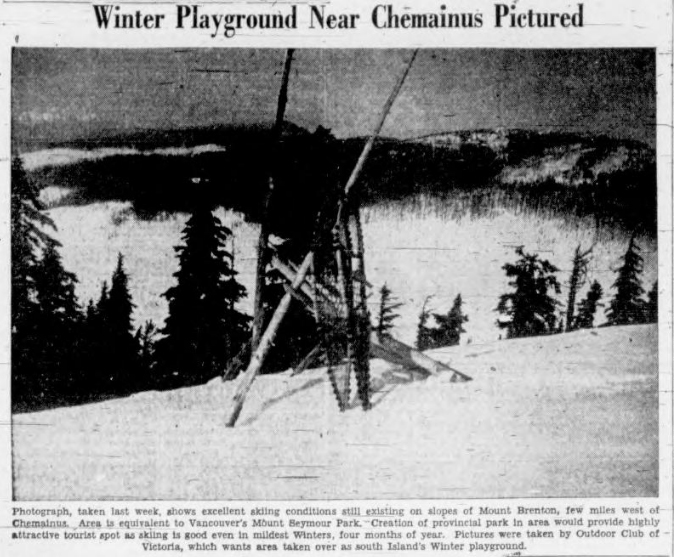
Photograph, taken last week, shows excellent siding conditions still existing on slopes of Mount Brenton, few miles west of Chemainus. Area Is equivalent to Vancouver’s Mount Beymour Park. “Creation of provincial park in area would provide highly attractive tourist spot as skiing is good even in mildest Winters, four months of year. Pictures were taken by Outdoor Club of Victoria, which wants ares taken over as south Island’s Winter playground.
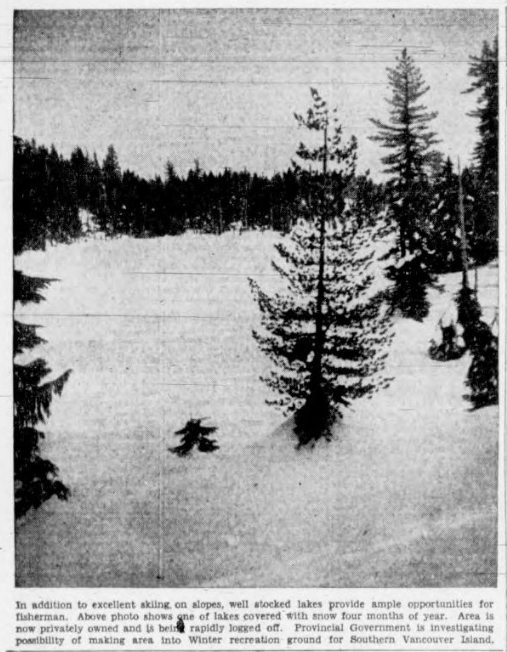
In addition to excellent skiing, on slopes, well stocked lakes provide ample opportunities for fisherman. Above photo shows one of lakes covered with snow four months of year. Area is now privately owned and is being rapidly logged off. Provincial Government is investigating possibility of making area into Winter recreation ground for Southern Vancouver Island.
Gladys Andrews and Stan Rushton Win Ski Crowns
C.D.M.C. Championships On Mt. Becher Easter
Reported in the Comox Argus Wednesday April 12, 1950. p.11.
The C.D.M.C. Vancouver Island Ski Championships were held om the top of Mt. Becher, on Easter Sunday and Monday. The slalom was run on Sunday under perfect weather conditions. A tricky 32-gate slalom was set to test the contestants in both the men’s and women’s races. Each competitor was required to make two runs over the slalom the total time of both the runs to be added together to decide the winner.
Women’s
Gladys Andrews
Ruth Masters
Irene Andrews
Men’s
Stan Rushton
Frank Stapley
Robert Gordon
The Downhill was run on Easter Monday in a blinding snow storm. A very steep, fast course was set for the men and one a little more gentle for the women. Results.
Women’s Downhill
Linda Williams
Gladys Andrews
Irene Andrews
Men’s Downhill
Sid Williams
Stan Rushton
Frank Stapley
For the C.D.M.C. trophy for the combined events the total times for both races were added together. Results.
Women’s
Gladys Andrews
Linda Williams
Irene Andrews
Men’s
Stan Rushton
Frank Stapley
Robert Gordon
Skiers Attend Mount Becher Event
Reported in The Daily Colonist Wednesday April 12, 1950. p.24.
Stan Rushton and Miss Gladys Andrews captured the men’s and women’s titles during Vancouver Island ski championships staged at Mount Becher by the Comox District Mountaineering Club. Results were: Men’s slalom, Stan Rushton; Men’s downhill, Sid Williams; Combined events, Stan Rushton; Women’s slalom, Gladys Andrews; Women’s downhill, Linda Williams; Combined event, Gladys Andrews. Strong winds and driving snow hampered contestants during the races.
It’s Still Winter on Island Playground
Reported in The Daily Colonist Wednesday April 26, 1950. p.10.
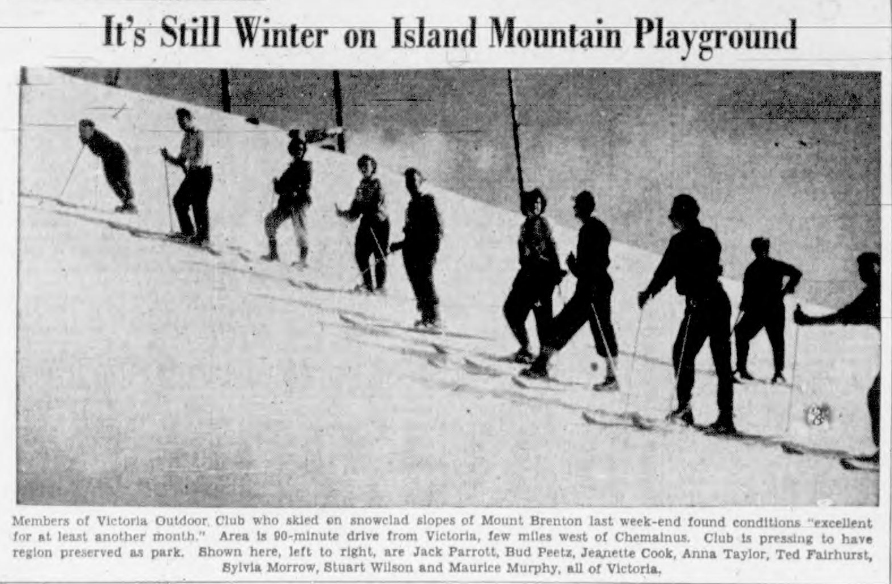
Members of Victoria Outdoor Club who skied on snowclad slopes of Mount Brenton last week-end found conditions “excellent for at least another month.” Area is 90-minute drive from Victoria, few miles west of Chemainus. Club is pressing to have region preserved as park. Shown here, left to right, are Jack Parrott, Bud Peetz, Jeanette Cook, Anna Taylor, Ted Fairhurst, Sylvia Morrow, Stuart Wilson and Maurice Murphy, all of Victoria.
Off To Alpine Club Camp
Reported in The Victoria Daily Times Saturday July 15, 1950, p.12.
Dr. Irene Bastow Hudson has gone to Jasper for 10 days and will be at Maligne Lake with the Alpine Club of Canada.
Ski Club Meet Set Tomorrow
Reported in The Daily Colonist Sunday October 29, 1950. p.22.
Organization meeting of the proposed Victoria Ski Club is scheduled for the Newstead Hall, 734 Fort Street, at 8 p.m. Monday. This is the first such club to be started in Victoria and plans are to take over Mt. Benton as skiing grounds. Jack Lindsay, originator of the idea, has already acquired the services of a ski school teacher for beginners. Anyone interested in convenient and inexpensive skiing this winter is asked to attend this meeting.
Marooned On Buttle Lake
Two Courtenay Hikers Held Up There Last Week
Reported in the Comox Argus Wednesday August 23, 1950. p.1.
After being marooned on Buttle Lake with nothing left but half a loaf of bread and two biscuits Messrs. Geoffrey Capes and Ted Grieg got back to Courtenay last week. They flew from Comox Harbor to Buttle Lake and landed on a beach at Phillips Creek. Mr. Capes had already climbed Vancouver Islands highest mountain, the Golden Hinde, and while not going to the top again, they intended to climb and explore the country between Buttle Lake and the peak. They found the going very hard. There is more snow in the hills this year than they have ever seen before at this time of year. At the four-thousand-foot level the lakes were frozen over every night: there must have been ten degrees of frost they thought. They saw plenty of game. Bucks larger than down on the coast line, were playing round in the snow. In addition to the snow, conditions they ran into are where there were miles of windfalls and slide alder and their progress was maddeningly slow. They came out to Buttle Lake on Saturday, reduced to half a loaf of bread and two biscuits, and waited for the plane to come and pick them up on Sunday. It did not arrive and “we would have starved to death,” said Mr. Capes, but for the kindness of Victoria couple, who were camping on the beach. They fed them bounteously. The next day was a south-easter on the outside but dead calm at Buttle Lake. However, the clouds hung over the mountain lake and the two hikers did not expect it. When it did not come early on Tuesday they became disgruntled. It finally appeared Wednesday and they got out alright. The view coming out of the lake is nothing but a criss-cross of logging roads and an abomination of desolation such as modern logging leaves behind it. Flying is the only way to get in and out, and quite a number are using their own small planes or hiring them to get into this beautiful country. Now that the big mill is going in at Duncan Bay conservationists and beauty lovers are very much afraid that the BC Power Company will want to raise the level of the lake ten or twelve feet. This would drown out all the beaches and destroy the lake completely as a beauty spot. Mr. R.L. Haig-Brown and others are already marshalling the rod and gun clubs and other nature lovers to try and prevent it. They point out that if the beaches were drowned out logging round Buttle lake would inevitably follow as the loggers would then point out that the lake would be useless to anyone from a recreational standpoint.
Threat to Buttle Lake
Cancellation of License to B.C. Power Is Urged
Reported in the Comox Argus Wednesday August 30, 1950. p.5.
At a meeting of the associated fish and game associations at Nanaimo this week, Mr. Haig-Brown, from Campbell River, Mr. G.B. Capes and others brought up the threat to Buttle Lake by the application of the B.C. Power Commission to dam it and use power from it. The application is to raise the lake twelve feet. They pointed out that no doubt the lake will be logged as far as the water level. As beaches would then be drowned out and timber would come to the water line the value of this park from a recreational point of view would be small and logging companies would probably so argue and suggest that the timber on the upper slopes might as well be logged. The resolution also points out that there is no present or immediately foreseen need for such power, and if the time ever came when it was needed, it could be obtained from other sources. The cancellation of the license to the B.C. Power was therefore urged.
Preservation Of Mount Brenton as Provincial Park Urged In Brief
Reported in The Daily Colonist Wednesday November 15, 1950. p.23.
Immediate action for the preservation of the area surrounding Mount Brenton as a Provincial Park is urged by the Outdoor Club of Victoria in a brief to be presented to the Provincial Government. The fact that logging operations are already under way lends urgency to the need for an early move on the part of the Government to open up this district for year-round recreation of Vancouver Island communities states the brief. The Outdoor Club congratulates the Government of British Columbia on its far-sighted policy in setting aside and developing park areas throughout the province. However, the brief reminds Lands and Forest Minister Edward T. Kenney of his statement earlier this year that “this area has park possibilities.”
Facilities Lacking
The Government is also reminded that while Mount Seymour and Manning Parks have provided Mainland centres with large and easily accessible recreational areas, Vancouver Island is without such facilities. For the 150,000 residents of southern Vancouver Island there are o comparable park areas within reach of their communities. Island picnic grounds and points of interest such as John Dean Park and Little Qualicum Falls, attractive as they are, cannot compare with the “multi-use” park areas on the Mainland. Furthermore, the brief continues, while Strathcona Park and the adjoining Forbidden Plateau are potentially great tourist attractions, large sums would have to be spent on roads to make them accessible. Even then, these two areas are too remote from Nanaimo, Ladysmith, Duncan and Victoria to serve these cities as Mount Seymour now serves Vancouver and New Westminster. Therefore, the brief states, the outstanding recreational need of Vancouver Island is an accessible Winter and Summer park close to the bulk of the population.
Exchange Possible
In reply of Mr. Kenney’s statement that the Mount Brenton area is privately owned, the Outdoor Club points out that Mount Brenton could, at no cost to the tax-payer, be obtained in an exchange for Crown Land. “It is hard to believe,” the brief goes on, “that private ownership of the small amount of land involved would represent any real obstacle once sustained public interest has been shown. The enormous area of unalienated Crown lands throughout British Columbia should afford an easy choice in exchange for the 2,500 acres of Mount Brenton, some of which is already logged off. Similar exchanges have been made in the past.” Little expenditure of public funds is called for, the Outdoor Club asserts. Improvement of a road already leading there and some snow clearing in Winter would be chief, if any, immediate expense. “The only urgent consideration is the preservation of the remaining stands of timber from the logger’s axe. Development is of secondary importance.”
Stresses Location
The brief stresses Mount Brenton’s convenient location. Between Nanaimo and Victoria, the area can be reached quickly from either city. The 1½-hour drive from Victoria brings it within easy reach of thousands who would seldom be able to spend a week-end to reach more distant parks. Skiing on the slopes of Mount Brenton in the Winter and swimming in Holyoak Lake, hiking and camping are only a few of the pleasures that would be opened up to southern Vancouver Island residents.
Supporters Named
Included in the list of southern and central Vancouver Island organizations supporting the immediate preservation of Mount Brenton as a provincial park are:
Victoria City Council
Victoria Chamber of Commerce
Recreational Council of Greater Victoria
Victoria YMCA
Victoria Fish and Game Association
Victoria natural History Society
Victoria Section Alpine Club of Canada
Victoria Ski Club
Saanich Municipal Council
Duncan City Council
Duncan Chamber of Commerce
North Cowichan Municipal Council
Chemainus Chamber of Commerce
Ladysmith City Council
Ladysmith Chamber of Commerce
Ladysmith Fish and Game Club
Mid-Island Auto Court and Resort Association
Nanaimo City Council
Nanaimo Chamber of Commerce
Nanaimo Ski Club
Mount Brenton Would Be a Sound Investment
Reported in The Daily Colonist Thursday November 16, 1950. p.3.
If, as has been represented, the Mount Brenton area near Chemainus could be acquired by the province by the simple expedient of exchanging Crown land for it, such a transaction would make a valuable addition to existing parks open to Vancouver Island people. Working against time, because logging of a forest fastness eminently suitable as a Summer and Winter park already has begun, the Outdoor Club of Victoria has petitioned the Provincial Government to take the area over before it is too late. In March last, The Colonist heartily commended these efforts to have Mount Brenton saved for the people; and it does so again. The rustic appearance of Vancouver Island is deceptive. In actual fact the populous regions of its southern half have relatively few areas of any size to which the people have undisputed right of access and which are within easy reach by road. Acquisition of Mount Brenton now would be timely, and certainly would be in keeping with the Provincial Government’s oft-stated policy of setting aside suitable tracts of land throughout British Columbia for public recreation and enjoyment in perpetuity. It is true that areas so reserved against destruction are Crown-owned already, but it should be possible for governmental policy to be adapted to meet a situation such as this. Such limited development as might be considered desirable for Mount Brenton could wait, for years if necessary. As the club points out, the urgent consideration is preservation of the remaining stands of timber from the axe. The province has good cause to know that forests such as those of Mount Brenton, once felled, cannot be restored in a hundred years. Acquisition of the area would be a sound investment. Nor can the province afford to ignore the numerous public and semi-public organizations on the Island which are supporting this proposal.
Alpinist to Talk to Outdoor Club
Reported in The Victoria Daily Times Monday November 20, 1950, p.11.
William [Bill] J. Heybroek, widely-traveled member of the Alpine Club of Canada and the French Alpine Society, will deliver an illustrated lecture “Kodachrome of Present Day Europe” at a meeting of the Outdoor Club of Victoria in Oak Bay Fire Hall Wednesday evening. Mr. Heybroek, now a resident of Victoria, recently spent six months in Europe engaged in color photography and mountain climbing. Club president Gordon Bowes will report on the progress of the campaign for the preservation of Mount Brenton as a provincial park.
Endorse More for Big Park
Reported in The Daily Colonist Wednesday November 22, 1950. p.24.
DUNCAN—North Cowichan Council endorsed a proposal by the Outdoor Club of Victoria that Mount Brenton, near Chemainus, be declared a national park. The club has been active in developing the area as a skiing ground.
Kenney Agrees to Start Investigation on Creation Of Mount Brenton Park
Reported in The Daily Colonist Wednesday November 29, 1950. p.1.
Lands and Forest Minister Edward T. Kenney yesterday promised investigation into the possibilities of making a 2,600-acre park in the Mount Brenton area. He made the statement after hearing a large delegation from the southern part of the Island. Mr. Kenney said he was satisfied it would make a good park area. The principal obstacle, he said, would be to determine whether the Government could take Crown land for private property which the delegation wants included in the park. Chairman of the delegation, which presented a brief to the minister, was Geoffrey Edgelow, head of the tourist development group of the Victoria Chamber of Commerce.
Outlines Need
In a six-page brief, the delegation outlined the importance of a park accessible to the large population centres of the Island. It was pointed out that the mainland was served by several such areas. The brief stressed that Mount Brenton represents an ideal year-round recreation spot, with ample natural facilities for all-Summer recreations and a skiing area for the Winter. The brief concluded: “The need for the Government action is imperative now. Already logging operations are under way of the lower eastern bluffs of Mount Brenton. If action is not taken now, the whole area may be denuded of trees by next Summer, and any possibility of a park would be lost.”
Last Chance
“This, we believe, is the last opportunity left to the Government to carry out its parks policy and provide Vancouver Island with a readily-accessible Summer and Winter park close to the centres of population. If Mount Brenton is not the answer, what is?” The delegation included representatives from: The Sidney and North Saanich Chamber of Commerce, the Duncan Chamber of Commerce, Victoria Ski Club, Outdoor Club of Victoria, Chemainus Chamber of Commerce, Ladysmith Chamber of Commerce, Victoria and Island Publicity Bureau and the Victoria Chamber of Commerce.
Buttle Lake Battle Still Goes On
Sports Magazine Says No Real Protection for Any Park
Reported in the Comox Argus Wednesday November 29, 1950. p.2.
The Northwest Sportsman of Vancouver is still fighting the inclusion of Buttle Lake in the hydro-electric plans of the B.C. Power Commission. In a recent editorial it said: “British Columbians may think they have Provincial Parks protected by law and tradition. THEY HAVEN’T. They are deluding themselves, and cheating their children, in so believing. In actual fact, today there is but one park, Garibaldi, which can claim the protection of legislative enactment. The rest is the creation of the government in order in council, and the breath that made them can unmake them. Little more than a whim of the provincial cabinet is needed to erase almost all the parklands from the face of this province. If you believe that such whims will never be, then we suggest you look to your news reports that tell each passing year of more and more “parkland” of British Columbia that is passing into the control of the government or private industrial development. Tweedsmuir Park is apparently to be opened to the Aluminum Industry. In the last month’s issue of the Northwest Sportsman noted sadly the dreary tale of decay and destruction on Lower Campbell Lake where B.C. Power Commission has backed its reservoir over thousands of acres of timber, rotted it, and threatened the surrounding stands of fine forestland with its wild animal and bird inhabitants.
The Campaign Wilted
That was a subject close to our hearts, because this magazine led the fight to prevent this disgraceful mess and, when sportsmen’s clubs all over B.C. joined the fray, it looked as though the needs of today’s sportsmen and tomorrow’s children would be met. But the campaign wilted. And today a large slice of that nearby parkland is threatened with destruction . . . Beautiful Strathcona Park on Vancouver Island, it is mooted, is to be despoiled in part by B.C. Power Commission. The Power Commission plans to build a “holding basin” there, of Buttle Lake, that is dam the mouth and increase the height by 45 feet. This is to form there a second reservoir for the Lower Campbell energy reserve—to serve needs which are not yet present in the Island’s hydro electric system. There are at present plans being made for a logging company to clear the flatlands at the lake’s edge which this rise in lake level will cover. This will at least avoid the dismal spectacle of thousands of dead, slimy snags forming a lake shore. But it does not answer to the fact that the provincial government many years ago paid private logging companies several hundred thousand dollars to vacate their timber rights in these same areas. And it indicates a very likely possibility of future destruction of this park area. For we suggest that when the flatlands are covered by the higher level of Buttle Lake there will be little left on its shores but steep cliffs. We further suggest that then logging companies will have a clear case to present for logging ALL of Buttle’s shores. When this vicious cycle is complete the region that was once one of the last unspoiled large lakes of Vancouver Island will be just another reservoir surrounded by white snags and rocks.
The Ruin of Buttle Lake
To quote the Courtenay-Comox Argus ‘There is no present reason for the ruin of Buttle Lake. The B.C. Power Commission is at present using about 37,000 horse power of its development capacity. Undoubtedly demand is growing and will grow, but in this area the B.C. Power Commission could utilize other potentials without spoiling Buttle—Canadian Collieries, for instance, at Puntledge. Why isn’t Puntledge used, or considered? BECAUSE EXCEPT FOR THE ODD NEWSPAPER AND THIS MAGAZINE AND A FEW SPORTSMEN, THERE IS NO ORGANIZED VOICE TO SPEAK ON BEHALF OF THE UNSPOILED WILDERNESS. If a move were made to establish a sawmill in Vancouver’s Stanley Park, it could never succeed over the violent opposition of that city’s Park Board. That board was created to care for the needs of the people parkwise, and it hollers on their behalf. But there is no board to speak for Strathcona or Tweedsmuir parks. They were created, as were almost all others by an Order of Council which “reserved rights” within certain areas, and another Order in Council can just as easily give back those lands to government or industrial development. The crying need in this province today is for a park board for each of our so-called provincial parks, and the passage of special acts in the Legislature of British Columbia establishing that these areas shall be free of encroachment by industry—whether logging, mineral or power development. We need the sanctity of our park areas to be proclaimed by the whole governing body of the province. And we need the establishment of bodies of public-spirted citizens to make sure the parklands are protected—citizens who are not employees of Victoria but who can stand up on their hind legs and shout if they feel that the peoples’ parks are being whittled away.
Ski Club to Meet: Mount Brenton Peak Covered by Snow
Reported in The Daily Colonist Thursday November 30, 1950. p.17.
Ski instructional films will be shown at a meeting of the Victoria Ski Club in the Newstead Hall tonight when by-laws and plans for the coming season will be discussed. Anyone interested in skiing is invited to attend. Club President Jack Lindsay reports a foot and a half of snow already on the upper slopes of Mount Brenton, promising several months of good skiing if the road can be kept open. He also stated that the delegation requesting preservation of Mount Brenton as a provincial park met with an encouraging reception from Edward T. Kenney, Minister of Lands and Forests.
Good Skiing on Plateau
Reported in the Comox Argus Wednesday December 6, 1950. p.3.
The Comox District Mountaineering Club is planning to have a grand opening of the season in about a weeks’ time. In the meantime, a few are going up at the week-end breaking the trail and having good sport. There is now plenty of snow and excellent snow conditions and when the season opens it should be with a bang.
Surveyors End Field Work on New Park Area
Reported in The Daily Colonist Thursday December 14, 1950. p.7.
Parks division surveyors have finished work in their survey of Mount Brenton area on Vancouver Island, where various Island groups want the Provincial Government to establish a year-round recreation park. Results of field work have still to be compiled and the amount of timber on private lands must be estimated. The Forestry Department have promised to give consideration to trading some public land for private land to be included in the proposed park. Parks division officials hinted yesterday, however, that it was unlikely much money would be spent for development of ski trails. Reports indicate that snow suitable for skiing only comes in cycles and there are many other areas more suitable year after year.
1951
ACCVI executive:
Chair – Mark Mitchell
Secretary – Nora Piggott
Events:
January – Rex Gibson gave a public showing of pictures taken by himself and Miss Aylard at the Maligne Lake Camp.
February – Skiing trips were made to the Olympic Mountains in Washington and to Mt. Brenton near Ladysmith.
March – Club meeting at the home of Muriel and Aileen Aylard. Dr. Irene Hudson gave a talk on her study of native medicinal and food plants. Miss Aylard then showed some pictures of her trip out east.
March 23 to April 1 – Several section members attended the ski camp in Little Yoho Valley. This camp was marred by an unfortunate accident to Mark Mitchell who had a bad fall and sustained a fracture of the left femur. Rescue operations took three days.
April – Club trip to Mt. Tuam on Saltspring Island included a boat trip and a pleasant traverse along the summit ridge. Twelve attended.
April 13 – Club’s annual banquet dinner was at the Pacific Club. Colonel and Mrs. Gerald Andrews spoke of his work in making three-dimensional aerial maps of British Columbia and showed examples of his photography.
May 24 – Club expedition by boat to some cliffs near Piers Island. These provided some good short pitches with excellent roping-off sites.
May 27 – Club trip to the upper cliffs on Mt. Prevost near Duncan.
June (early) – Club trip to Cameron Lake where a party of eighteen spent the weekend, with ascents of Mts. Cokely and Arrowsmith.
June 30/July 1 – A party of ten club members arrived at the western end of Taylor Arm on Sproat Lake and were told by the boatman that the forests had just been closed and that while they could have the boat they could not land anywhere or set up a camp.
August – Fire hazards forced a last-minute alteration in club plans of Waterloo Mountain to Sansum Narrows. A successful first ascent of the main diagonal crack on the big cliff was made by one rope of four and several other routes were worked out up pitches of varying difficulty.
September (Labour Day Weekend) – A club trip to the Olympic Mountains in Washington.
September – Club meeting at the home of Dr. Irene Hudson to discuss camp and to see slides presentation of Lake O’Hara by Miss Aylard and Miss Edith Valens of Edmonton.
December 7 – Club annual meeting held at the home of Mark Mitchell where reports were presented and officers elected for 1952.
Section members who attended the ACC annual summer camp at Lake O’Hara Meadows July 16 to 29: Aileen Aylard, Muriel Aylard, Gerald Andrews, Viscount Mark Colville (graduated on Mt. Odaray) Helen Dewar (graduated on Mt. Odaray), Mabel Duggan, Joan Forbes (graduated on Mt. Odaray), Rex Gibson, Ethne Gibson, Frederick Longstaff, Edith Maurice, Dudley Godfrey (graduated on Mt. Odaray), Mary McCulloch (graduated on Mt. Odaray), Gertrude Snider.
Section members who passed away in 1951: Jean Mollison.
Skiers Request Hillcrest Road Be Kept Open
Reported in The Daily Colonist Thursday January 25, 1951. p.15.
Victoria skiers, who need snow to carry on their operations, have found that too much snow is just as bad as not enough. Nearly 100 members of the Victoria Ski Club found last Sunday that all roads leading to Mount Brenton ski fields had been blocked by fourteen inches of snow. It appears now that the roads will not be open for several weeks until the loggers go back to the woods and bring their bulldozers. Jack Lindsay, president of the Ski Club said recently that there would be 300 skiers on the slopes of Mount Brenton each week-end if the Hillcrest Road could be kept open. “If there was any chance of the Government acting now to clear the Hillcrest Road to within two or three miles of Mount Brenton, it would permit skiers to reach some slopes,” Lindsay said. He added that two or three clearings by a bulldozer would probably be enough for the winter as the road has southern exposure. “Elsewhere throughout the Province, the Government maintains roads leading to winter sports grounds, and in view of the great interest in skiing now evident in Victoria, we feel we are not asking for too much,” he stated.
Alpine Club Talk
Reported in The Daily Colonist Thursday January 25, 1951. p.26.
Alpine Club of Canada, showing colored slides of Maligne Lake Camp, taken last July, will be given by Major Rex Gibson, on Friday, January 26, at 8:30 pm., in hall above Newstead Reality, 734 Fort Street. Dr. W.E. Mark Mitchell, M.C. in the chair. Collection for expenses.
Alpine Club Sees Slides
Reported in The Daily Colonist Saturday January 27, 1951. p.21.
The Victoria branch of the Alpine Club of Canada had its first showing of slides this season at a meeting held at Newstead Hall. The slides were shown by Major Rex Gibson. The subject dealt with different Alpine Club expeditions from Maligne Lake near Jasper. Pictures showed approaches to the club camp where 150 members were bivouacked last July, and many scenes of climbers near summits of various mountains. Chairman was Major Frederick Longstaff taking the place of Dr. Mark Mitchell, president of the club, who was unable to attend.
Mapping B.C.
Reported in The Daily Colonist Saturday February 3, 1951. p.4.
By Frank Kelly
Reaching the inevitable age of retirement, Norman C. Stewart, recently Surveyor General of British Columbia and for some time Director of Surveys, tells me he has had a very satisfying life, albeit not always on the smooth side. At that, a man would have to have something akin to a love for the surveyor’s life, or he could not enthuse over it in retrospect. True, that would be the general summing up of any well-fashioned surveyor who had been in the habit of putting in long years, at one time anyway, in far parts of the province; and I was not surprised to hear it from him after knowing a few of the older knights of the transit long ago like Jack Gray, Herrick McGregor and Harry Browne, for instance. Evidently, although Norman Stewart’s later years have been devoted to the modern way of surveying great vasts of terrain by photo-topographic methods – leaving the more meticulous transit practices for the town lot and determining farm plot boundaries – he has not forgotten a distant day when he saw a young man peering through a transit on the Bonington Falls project, and straight-with determined to become a surveyor. That was easier mind-planned than accomplished. A civil engineer’s diploma means some college training, and while he had about all public and high schools of Nelson could teach him, it was not enough. It was then his dad staked a square mile of timber (good old days!), sold it and raised the wind for the all-important trip East. For three years he studied hard, devoting his summer holidays to stints with surveys in the field. Graduating with a C.E. diploma, he went back to the same fountain of learning for another drink, the timber licence money still on tap. A B.Sc. degree was the result; and a year later he passed examinations to qualify for both Dominion and British Columbia land surveyor status. From then on, 35 years on the ground and up in the air, Norman Stewart has seen a lot of British Columbia as a member of a fraternity which undoubtedly has a greater knowledge, individuality, than any single member of any other group at large in the province. They may be the “brief chronicles of their time” with verbal descriptions of what they behold from a triangulation station high on a mountain peak or from the observation post in a plane flying a photo-taking compass course; but their records filed away in the various departments of government represent a great wealth of revealing information. A native Canadian, Norman Stewart came to British Columbia in 1888, with his parents. They travelled to Vancouver where they found Hastings Street adorned with divers [sic] structures and stump-garnished lots (I remember them myself); and there were logging camps as close to town as False Creek and Grandview, where his dad found employment. This mining excitement in the Kootenays had attracted them to Nelson by 1896. Stewart’s first British Columbia work after he finished with acquiring degrees, etc., was in the railway belt; and together with Alan J. Campbell he was on the topographic survey of the Great Divide, directed by Arthur O Wheeler. He was later associated with Campbell, who was in charge of British Columbia topographic surveys, Robert D. McCaw being another member of that pioneer trio. Becoming interested in the mapping technique from the air, Stewart studied methods at Ottawa and covered a lot of the province, eventually becoming surveyor-general. Casting the harness of that position, he has been persuaded to fill the role of British Columbia-Alberta Boundary Commissioner. When that is finished, he will attempt a different kind of survey in the Caribou, which he appears to like very much.
Talk For Outdoor Club of Victoria
Reported in The Victoria Daily Times Friday February 23, 1951, p.22.
After elections at the annual dinner of the Outdoor Club of Victoria, Major Rex Gibson of the Victoria section of the Alpine Club of Canada gave an illustrated lecture entitled “Mountaineering on the Moon.”
Courtenay Man Star Skier in Becher Races
Stan Rushton First in Tournament on Easter Monday
Reported in the Comox Argus Wednesday March 28, 1951. p11.
Vancouver Island Ski Championships were held at Mount Becher on Easter Monday under perfect conditions and in brilliant sunshine. Skiers came from Victoria, Quathiaski Cove, Campbell River and other nearby points to compete in the C.D.M.C. event. First place in all men’s events was taken by Courtenay star skier, Stan Rushton, who competed against 20 entries in the slalom and 18 in the downhill. For the first time Gladys Andrews did not lead in the women’s entries, her place being taken by Paddy Hooper and Marilyn Pimm. George Hobson and Oscar Peterson were official starters, course was set by Herb Bradley and he was assisted by Alan Knappett as timekeeper. The women’s run was mush more difficult this year, shorter than the men’s, but steeper.
Winners were as follows:
Men’s Slalom – 1. Stan Rushton, Courtenay; 2. Terry Gower, Victoria; 3. Frank Stapley, Campbell River.
Men’s Downhill – 1. Stan Rushton; 2. Frank Stapley; 3. Robert Gordon.
Men’s Combined – 1. Stan Rushton, 60 points; 2. Frank Stapley, 58.75 points; 3. Sid Williams, 55.30 points.
Ladies’ Slalom – 1. Paddy Hooper; 2. Glady’s Andrews; 3. Marilyn Pimm, all of Courtenay.
Ladies’ Downhill – 1. Marilyn Pimm; 2. Paddy Hooper; 3. Glady’s Andrews.
Ladies’ Combined – 1. Paddy Hooper; 2. Glady’s Andrews; 3. Marilyn Pimm.
Speaks To Alpine Club
Reported in The Daily Colonist Friday April 13, 1951. p.5.
Colonel Gerald Andrews will be guest speaker tonight at the 40th anniversary dinner of the Vancouver Island section of the Alpine Club of Canada to be held at the Pacific Club.
Colored Slides
Reported in The Daily Colonist Friday April 20, 1951. p.31.
Colored slides of Banff, Lake Louise and Yoho Valley photographed and shown by Mr. Edward Goodall, at St. Mary’s Hall, Yale Street, Friday April 20, at 8 p.m. Silver collection.
Local Mountain Climbers Will Attend Yoho Camp
Reported in The Daily Colonist Friday May 11, 1951 p.17.
Local mountain climbers will have a chance to put their sporting skills to test at the annual camp of the Alpine Club of Canada at Yoho National Park from July 16 to 20. Dr. Mark Mitchell, chairman of the Victoria branch of the Canadian Alpine Club, stated yesterday that from six to twelve local members are expected to make the trip. Four peaks more than 11,000 feet high and two nearly that height can be climbed from the main camp of the club in the Lake O’Hara region. This will be the 46th annual camp of the Alpine Club and members of the international organization from many foreign countries are expected to attend. Active members of the club must have ascended a truly alpine, glacial-hung peak at least 2,500 feet above the timber line.
Where Buttle Lake Would Be Dammed
Reported in The Daily Colonist Wednesday June 13, 1951 p.12.
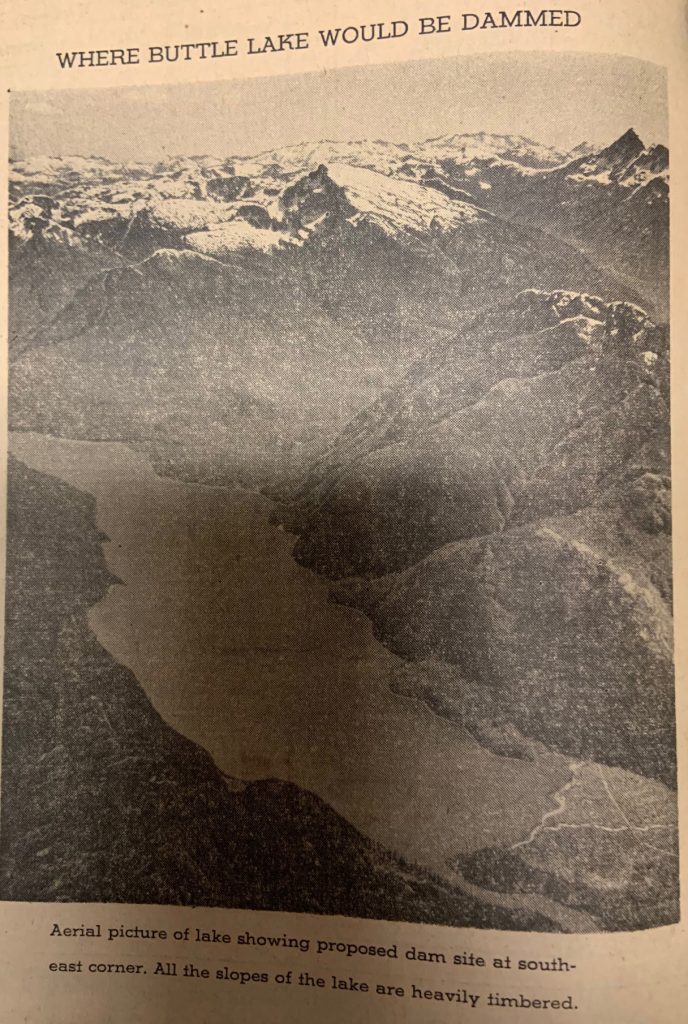
Aerial picture of lake showing proposed dam site at southeast corner. All the slopes of the lake are heavily timbered.
Keith Morton Heads C.D.M.C. This Season
Officers Elected at Annual Meeting on Monday
Reported in the Comox Argus Wednesday September 12, 1951. p.13.
The annual meeting and election of officers of the Comox District Mountaineering Club was held in the CRA Hall with 22 members present. Stan Rushton was in the chair. Officers elected for the 1951-52 season were as follows: president, Keith Morton; vice-president, Oscar Peterson; secretary, Ruth Masters; treasurer, Irene Andrews; ski captain, Stan Rushton. The following committees were formed with the chairman as follows: transportation, Rose Muir; ski tow, Brian Bayly; new cabin, Angus Strachan; Becher cabin, Herb Bradley; entertainment and ways and means, Iola Knight; membership, Ruth Masters; publicity, Rose Muir; ski patrol, Herb Bradley. Plans were made for the addition of a new wing on the first cabin – to be used as a kitchen – work to commence immediately. The Club is now sporting a new ski badge, which can be purchased by members only and which we think looks very sharp. Judging by the enthusiasm shown at our first meeting, 1951-52 season should be bigger and better than the last year.
RCAF Forms Mount Hkusam Search Party
Reported in The Victoria Daily Times Tuesday September 18, 1951, p.11.
A search party left Vancouver shortly before noon today with hopes of solving the mystery of the disappearance of a U.S. Neptune bomber two years ago on the east coast of Vancouver Island in the vicinity of Hkusam Mountain. RCAF spokesperson said the party flew to Campbell River in a Canso and was to proceed up the east coast to the mountain area in RCMP vehicles. The new search for the remains of the bomber was started after Flight Lieutenant Hugh Campbell, commanding the Victoria RCAF recruiting office, flew over the mountain Sunday to check a U.S. pilot’s report that plane wreckage seemed to be strewn about the 3,000-foot level of the mountain, which overlooks Johnstone Straits. Lieutenant Campbell flew over the area seven hours in a helicopter. He spotted what may have been the remains of a “survival tent” apparently made with parachute silk, and a small fireplace and cairn. He said he saw no trace of the missing bomber, however.
Ground Party to Investigate Air Find
Reported in The Daily Colonist Tuesday September 18, 1951. p.11.
By Trevor Collins
A ground search party are expected to leave Patricia Bay airport at daybreak today to search for what might turn out to be the remains of an American bomber lost about two years ago. The search was sparked by Flight-Lieutenant Hugh Campbell, commanding officer who returned Sunday night from a grueling seven-hour helicopter flight to the Kelsey Bay district. He was investigating an American pilot’s report of what appeared to be a crashed aircraft on the 3,000-foot level of Mount Hkusam [Mt. Kitchener, Prince of Wales Range] on the east coast of Vancouver Island. Campbell flew over the area in a helicopter Sunday and discovered the remains of a tent, which he described as a “survival tent” made of what appeared to be parachute silk. He also noticed a small fire-place similar to that built by hunters and trappers.
Looks Like Cairn
Beside the remains of the tent he spotted a pile of stones which he described as “like a cairn.” The tent was located on a bluff on the 5,461-foot mountain overlooking Johnstone Strait. Campbell thinks the tent might have been constructed by surviving crew members of an American Neptune bomber lost without a trace on a trip from Alaska. The mountain is close to the course the plane would have taken on its southern journey. The U.S. Air Force asked the R.C.A.F. to report the search for the lost Neptune about four months after it disappeared in 1949. Campbell was ordered out in a helicopter in July 1949, and for three months he searched in the densely-wooded Nitinat Lake district near Barcley Sound on the west coast of the Island.
Old Wreckage
He discovered three old airplane wrecks that were already known by air force officials. There was no trace of the Neptune. Dwindling gasoline supply and approaching darkness prevented a close search for the crashed plane on Mount Hkusam. Campbell said he spotted some logging equipment on the opposite side of the mountain from the tent which he believes might be what the American pilot thought was a wrecked plane.
Search Party Climbs Hkusam to Wreckage
Reported in The Victoria Daily Times Wednesday September 19, 1951, p.1.
An RCAF ground party from Vancouver today struggled up a steep Vancouver Island mountain toward the wreckage of a plane spotted earlier from the air. The wreckage is believed that of a U.S. Navy Neptune patrol bomber. One plane of this type vanished over the northern end of the island in November 1948. Another disappeared last December on a flight from northern Washington base. The first carried nine men, the latter eleven. A small tent apparently made of fabric ripped from the crashed plane’s fuselage, indicated at least one man survived the crash. No bodies could be seen from the air. The ground party said it expected to reach the scene late this afternoon on the northeast coast of the island. The wreckage was spotted Saturday on the 4,000-foot level of 5,642-foot Hkusam Mountain overlooking Johnstone Straits. Other planes sent out to investigate at first reported it was abandoned logging machinery. Another check established that the wreckage was that of a plane. The tail assembly was still intact. There was no indication as yet as to what became of any survivors. Apparently they perished in the forest. The country is mountainous and uninhabited.
Wreck of Big Plane on Rock Bay Mountain
R.C.A.F. Ground Crews Have Not Reported Back Yet
Reported in the Comox Argus Wednesday September 19, 1951. p.1.
A special staff correspondent of the Campbell River Argus this morning reported that rescue parties of the R.C.A.F. have not yet reported back from the arduous task of climbing to the top of rugged Mt. McCreight [Mt. Kitchener, Prince of Wales Range] at the north side of Rock Bay, where a Pan American Airlines pilot sighted wreckage of a plane last Friday [September 14]. So far there has been no definite identification of the plane and will not be until the party returns and makes a report. A pilot, who has been over the plane says from the air it looks as if the plane has been there some time. It might have struck the top of the mountain in the winter and caused a gasoline fire, which was prevented from spreading by the snow. Snow has hidden the wreckage since until now it has been bared by the heat of this summer. Speculation ranges from the loss of a T.C.A. [Trans Canada Airlines] plane, which disappeared during the war years with all on board to an R.C.A.F. plane from Comox Airport. The R.C.A.F. rescue crews have been working from the air and from the ground since Friday. They are going in from Rock Bay or the Kelsey Bay Road. The ground to be covered is very rough which would account for the long time made before they could get in and come back. On Saturday an R.C.A.F. helicopter was over the area but failed to locate the wreckage.
Wreckage of Plane Identified
Reported in The Daily Colonist Saturday September 22, 1951. p.1.
CAMPBELL RIVER, September 21—Wreckage of a U.S. bomber found high atop Mount Creighton [Mt. Kitchener, Prince of Wales Range] has been identified as one that carried an 11-man crew. It was a U.S. Neptune plane which disappear last December—two days before Christmas—on a training flight over Vancouver Island. The identity was established tonight when an R.C.A.F. search party returned here after four hazardous days in the mountains. With them, the searchers brought out the remains of the 11 men who died when the plane crashed into the mountain. “There was no evidence that anyone had survived the crash,” said Bert Hughes, a Vancouver reporter who accompanied the search party. “We found nothing but wreckage and bones. There were no personal effects—not even dog tags—found by the searchers.” The remains of the men were found strewn over a 400-yard area at the 4,000-foot level on the steep mountain. “Apparently the plane hit the mountain head-on, cutting trees. It was bent like tinfoil, except the tail section, which was still intact,” reported Hughes.
Party Out from Plane Crash
R.C.A.F. Party Still Reticent About Disaster on Mt. Hkusam
Reported in the Comox Argus Wednesday September 26, 1951. p.3.
CAMPBELL RIVER, September 25th—A group of weary men arrived in Campbell River about 9 o’clock last Friday evening, September 21st, after ascending and descending Mt. Hkusam [Mt. Kitchener, Prince of Wales Range] on the expedition to locate the remains of what is believed to be a U.S. navy plane. “Pretty rugged”, is the only comment made by Sergeant John “Red” Jameson, R.C.A.F., leader of the expedition, when asked the nature of the terrain they travelled over for three days. The men were on the timbered and rock covered slopes of the mountain from Tuesday afternoon, after they arrived at Campbell River by plane and had been taken to McCreight Lake, about 25 miles northwest of Campbell River in taxis driven by Gordon Motion and Ralph Smith. Included in the group were seven R.C.A.F. personnel, one member of the local R.C.M.P. detachment, and Lieutenant-Commander O.B. Grey of the U.S. Navy. The men were not permitted to disclose and information about the results of their expedition until a full report has been made to headquarters.
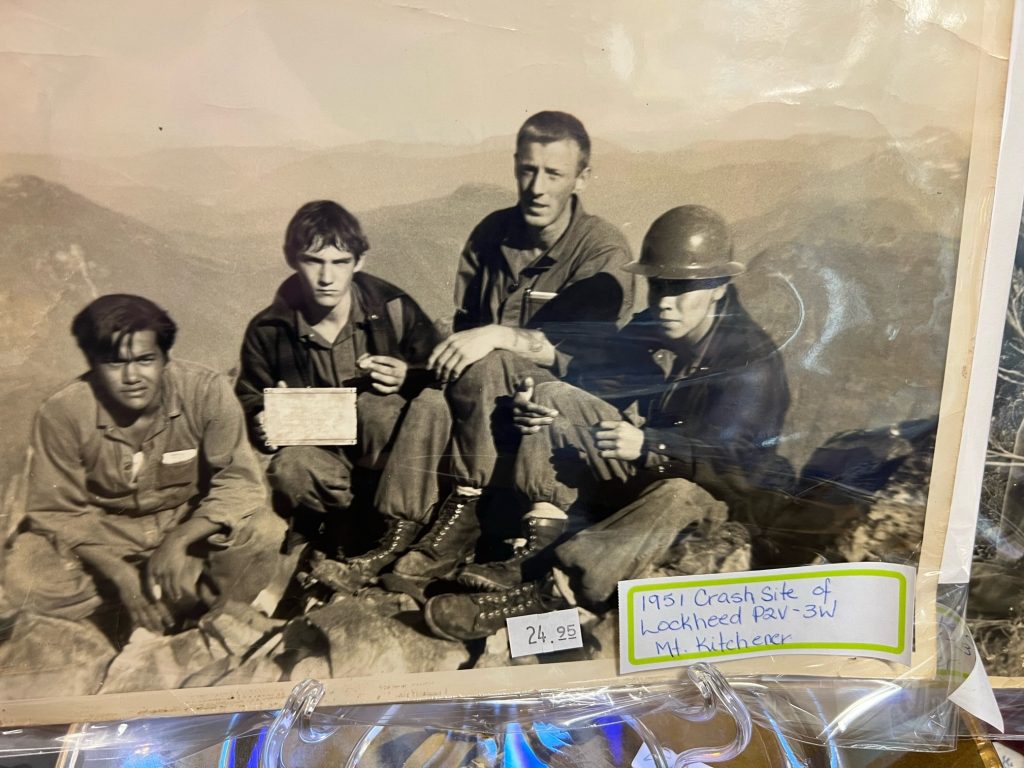
1951 Crash Site of Lockheed P2V-3W Mt. Kitchener
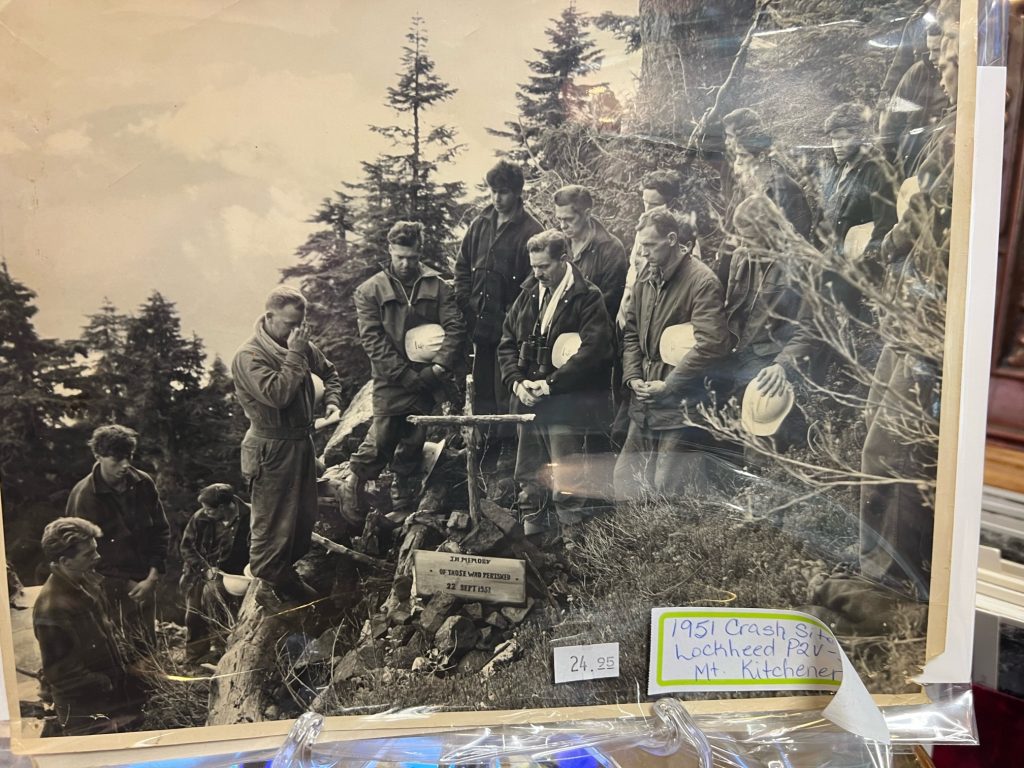
1951 Crash Site of Lockheed P2V-3W Mt. Kitchener
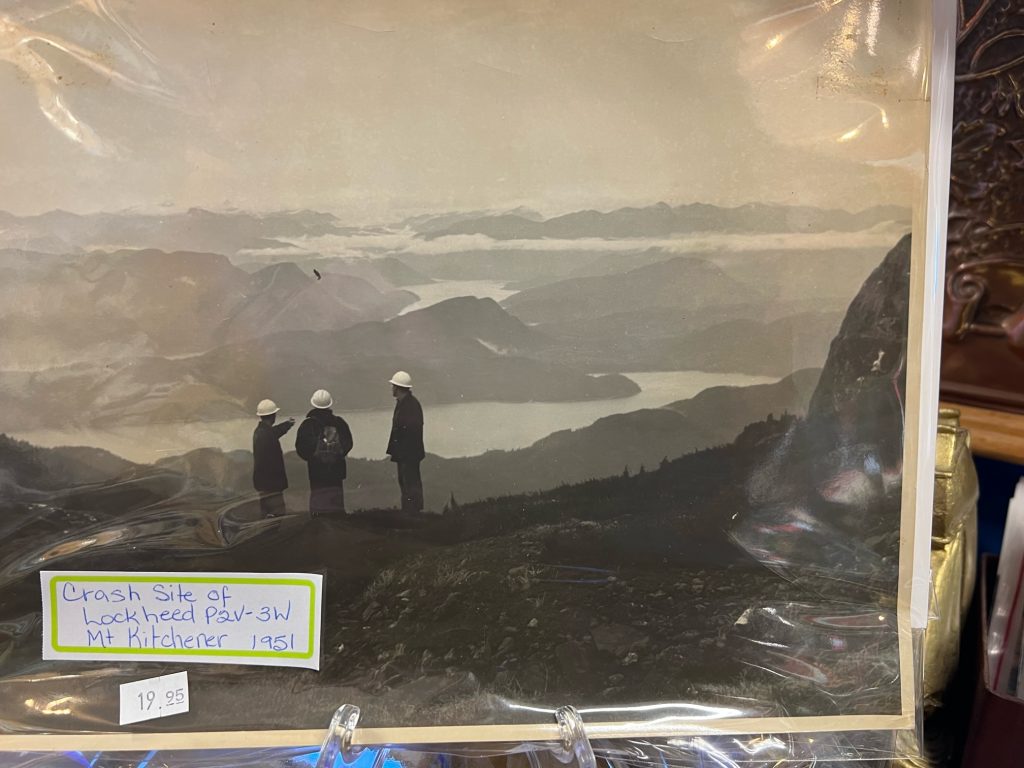
1951 Crash Site of Lockheed P2V-3W Mt. Kitchener
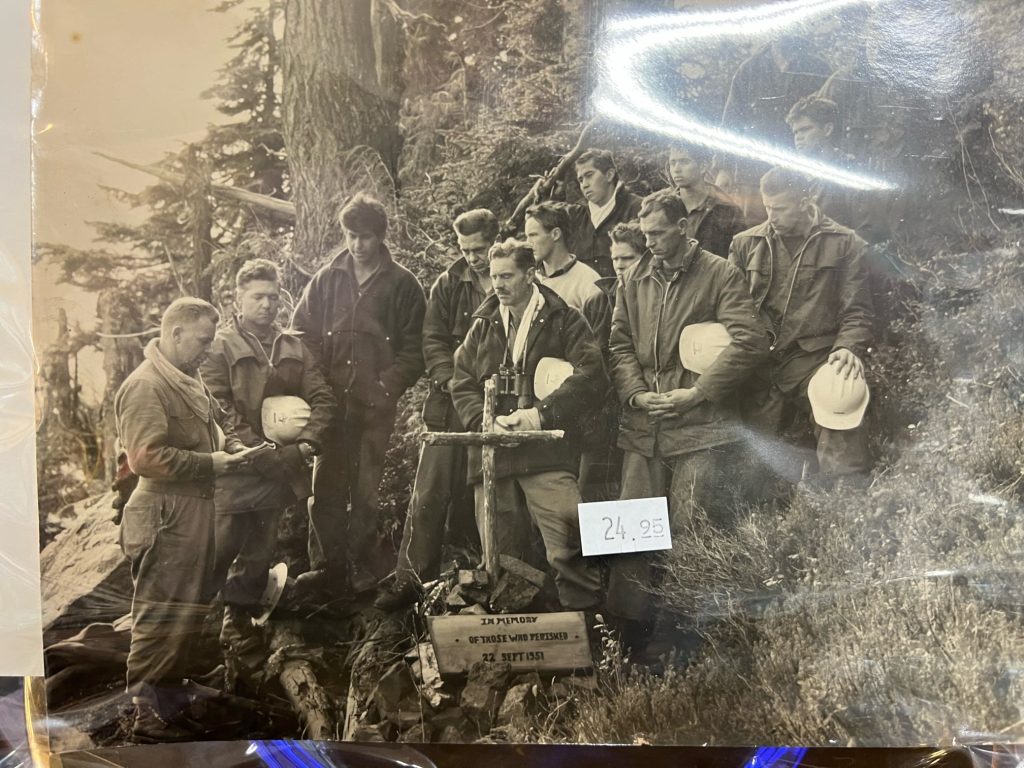
1951 Crash Site of Lockheed P2V-3W Mt. Kitchener
1952
ACCVI executive:
Chairman – Mark Mitchell
Secretary – Jean McDonald
Events:
January 25 – A public meeting was held at the Newstead Hall and a lecture illustrated with slides was given by Rex Gibson. The subject dealt with were rescue work, Ski Camp 1951, The Lake O’Hara Camp and the recce up the Chaba Valley.
February 29 – Club meeting at the home of Margery Thomas. The speaker for the evening was Dr. Bill Matthews, who gave an instructive talk on the subject of “Glaciers.”
February 3-8 – A party of eight from the section spent five days at the Mazama’s Cabin on Mt. Hood in Oregon. Pat Guilbride and Alfie Dick made a successful ski ascent of Mt. Hood in five and one quarter hours.
February 24 – A local ski trip.
March – Section members represented at the Club’s Ski Camp at Mount Assiniboine.
April 7 – Section annual banquet. The guest speaker was Major-General William Foster and a film entitled “Aerial Mountaineering” was shown. This dealt with the recent first ascents of Mt. Wood and Mt. Walsh in the Yukon Territory.
April 11 – Good Friday hike was to Empress Mountain above Crabapple Lake.
May 25 – Club trip to Mt. Whymper in bright sunshine. Twelve of the thirteen made the summit.
June – A club trip saw twelve members climb Klitsa Mountain.
July 1 – A club trip to Galiano Island where eight members climbed the highest point Mt. Sutil.
July 31 to August 3 – Members joined with CDMC on a trip to the Comox Glacier.
August 17 – Owing to forest closures an alternate club trip was made to the cliffs near Genoa Bay.
August 30/31-September 1 (Labour Day) – A small party of club members climbed Mt. Appleton in the Olympic Mountains.
October 13 (Thanksgiving Day) – A club trip to Mt. Moriarty saw a party of fifteen under the leadership of Mark Mitchell summit.
November 19 – Club annual meeting at the home of Frederick Longstaff. Mark Mitchell was again elected as chairman of the section. Rex Gibson showed slides of the Whirlpool-Scott Glacier area where he and his party carried out a recce in July 1952.
Section members who attended the ACC general summer camp at Mt. Assiniboine July 21 to August 3: Geoffrey Capes, Rex Gibson, Ethne Gibson, Edward Goodall, Cyril Jones (graduated on Mt. Sturdee), Bill Lash, Dorothy Lash, Mallory Lash, Mark Mitchell, Ronald Mooney, Dorothy and Ray Pillman, Margery Thomas.
Section members who passed away in 1952: Frederick Helm
Alpinist To See Rope Climb Show
Reported in The Victoria Daily Times Tuesday January 22, 1952, p.12.
Demonstration of rope climbing will be given at a meeting of the Victoria section of the Alpine Club of Canada, Friday night at 8:15 p.m. in Newstead Hall. Major Rex Gibson will display technique now being used in mountaineering and in rescue work elsewhere. The meeting will see slides taken by Major Gibson last summer during a reconnaissance trip into Fortress Lake area, which is over the Alberta and B.C. divide, 26 miles northwest of Sunwapta Pass on the Jasper Louise Highway.
Kenney and Norris in Buttle Lake Battle
Heated Clashes Between Minister and Council
Reported in the Comox Argus Wednesday January 23, 1952. p.12.
The battle of Buttle Lake has opened with full vigor in Victoria with argument before Lands Minister E.T. Kenney. The session Friday after noon lasted two and a half hours and was held in the government members’ room of the Parliament Buildings. Land Minister E.T. Kenney preside as a one-man board of appeal, sitting to hear arguments against a ruling by water comptroller E.H. Tredcroft that B.C. Power Commission be allowed use of the lake for power development. Both Thomas G. Norris and Colonel Eric Pepler appeared on behalf of appellants opposed to damming of the lake. Pepler represents the government games commission. Norris retained by three conservation groups and one individual argued that Tredcroft did not have jurisdiction to rule on the case in the first place, and that Kenney did not have jurisdiction to sit to hear the appeal. His principal argument was that Tredcroft, as an employee of the government, and Kenney, as a minister of the crown were not impartial parties, and, therefore could not be expected to bring in a finding that would be contrary to government policy. Pepler took exception to Norris’ submission and attempted to pull his argument to pieces. Explaining he represented the Government’s Game Commission, Pepler said he was not objecting to jurisdiction. “All proceedings have been perfectly in order and are valid,” the deputy attorney-general claimed.
Norris Surprised
His statement came as a surprise to Norris, whose arguments were given full support by another appellant counsel, H.J. Sedgewick, appearing on behalf of the B.C. Fish and Game Council. Norris, in submitting a 25 page brief, argued that apart from the jurisdictional question, his clients were at a disadvantage since reasons for the water comptroller’s decision had not been made available to them, although copies had been made available to Premier Johnson and Lands Minister Kenney.
Prejudiced In Law
“My clients are prejudiced in law on the present appeal,” he contended; “prejudiced to the extent that without thee reasons they are left groping in the dark.” Norris clashed with Kenney on this point. Kenney termed Norris’ claim “a bald statement.”
NORRIS: “If you have the reasons, you should make them known.”
KENNEY: “I’m not here to be cross-questioned.”
NORRIS: “If you or the premier have the reasons, it’s your duty to bring them forward.”
KENNEY: “I’m not here to be cross-questioned.”
NORRIS: “If you have the reasons and are concealing them, you’re defaulting in your duty.”
Kenney Takes Exception
The minister took exception to this remark. “I’m not doing this for pleasure,” he replied.
Commission counsel H.W. Davey upheld the right of both Tredcroft and Kenney to consider and rule on arguments concerning Buttle Lake. Davey told Kenney: “You and the comptroller are the sole persons authorized by statute to exercise jurisdiction.” With respect to the water comptroller not making public reasons, Davey contended in many cases as judges just give “a line or two” in reasons for judgement. He said sometimes judges gave no reason at all. Davey observed that Tredcroft had explained his decision was “in the public interest.” Davey said: “The reason was simple and to the point—quite adequate.”
No Reason at All
Norris countered: “This is not a reason at all, but is a conclusion. Why is it in the public interest? The cry of public interest has long been the excuse of the bureaucrat when he tries to justify that which is indefensible.” At the conclusion he would consider the jurisdictional question first and that his decision on that would determine of further arguments would be heard by him. “If there was no jurisdiction on the part of the comptroller, then, it naturally follows there is no appeal to myself. This matter of jurisdiction is the first thing to be determined. If there is no jurisdiction, there is no point in going on.” William Haldane appeared as law clerk at the hearing. Kenney explained he had retained Haldane to act as his adviser when he learned he would sit to consider the appeal. “I naturally felt it would be a source of embarrassment to ask the department of the attorney-general. It would have seemed unethical for the department to have been appealing on one hand and advising me on the other,” he said.
Buttle Lake Battle Over
Norris Has Thrown in The Sponge
Reported in the Comox Argus Wednesday April 23, 1952. p.1.
The last stage in the battle against damming Buttle Lake is likely to go by default to the industrialists. Counsel T.G. Norris, for the conservationists stayed away from the hearing before Land Minister E.T. Kenney on Wednesday. Reason for the short session was that three of the four lawyers expected to argue against authorization of the British Columbia Power Commission to dam the Up-Island lake stayed away altogether. Only appellant heard today was Deputy Attorney-General Eric Pepler, representing the Provincial Game Commission, who made only two minor points in his 20 minute submission. Counsel who stayed away from the last hearing were Thomas G. Norris, Q.C., who from the start of the Buttle battle has represented British Columbia Natural Resources Conservation League, the Strathcona Park Association and Virginia Moore; H.G. Sedgewick, retained by the British Columbia Fish and Game Association, and Alec B. MacQuarrie and Resort Association of British Columbia.
Explains Absence
Norris, prominent Vancouver attorney who is in Victoria at the moment, explained his absence at today’s hearing in a letter to Lands Minister E.T. Kenney, presiding at the appeal. Norris declared further arguments before the minister would be “a sheer waste of time.” He wrote Kenney: “You have made it clear that it is not possible for my clients and, for that matter, the public generally to obtain justice before you. My clients still maintain that particularly on the ground of bias you are entirely without jurisdiction to deal with the matter.” Mr. MacQuarrie did not provide reason for failing to appear today, so it was presumed they held similar views.
Not Game Fish
Only arguments raised by Colonel Eric Pepler at the morning hearing was that artificially-spawned fish that would be used to restock the lake after the Power Commission completed its project, would not be as good for sport purposes as those which would spawn naturally if the lake was left alone, and that wildlife would be adversely affected because present feeding grounds near the shore would be obliterated. H.W. Davey, principle counsel for B.C. Power Commission attacked both arguments. He contended artificial restocking of lakes would not be such a widespread practice if results were not reasonably satisfactory. With regard to wildlife, he submitted that greater damage would be done to feeding grounds by flooding Upper Campbell Lake, suggesting as an alternate site for the power commission’s project. Lands Minister E.T. Kenney, at the end of the hearing, served notice that he would require time before bringing down judgment on the case. Decision, he said, would be given “in due course.”
Alpine Rescue Work Subject of Lecture
Reported in The Victoria Daily Times Saturday January 26, 1952, p.19.
Rescue work in alpine country and colored slides of Yoho, one of the main mountain climbing centres in the Rockies, featured a lecture given by Major Rex Gibson, at a public meeting of the Victoria section of the Alpine Club of Canada, at the Newstead Hall. About 60 persons attended the meeting. Dr. W.E. Mark Mitchell was the chair.
Photographic Competition
Reported in The Victoria Daily Times Thursday August 21, 1952, p.7.
DUNCAN, Aug. 21—Connie Bonner of Cobble Hill, has been awarded four prizes for her colored slides at a photographic competition held in Ottawa by the Alpine Club of Canada. A slide of Maligne Lake was awarded first prize in the mountain scene division and was selected as the second best slide of all those entered in the show. She won first prize in another called “Forest Mirror” and was given third place with another depicting Iceland peoples. Edward Goodall, Victoria, won honorable mention with a slide of Mt. Burgess at Emerald Lake, and Rex Gibson, Saanichton, took a first prize with a mountain climbing picture.
Snowbirds Plan First Class Ski Site
Hope For Cabin, Tow, Slide on Mt. Brenton
Reported in The Victoria Daily Times Tuesday September 23, 1952, p.8.
By Roy Thorsen
A skiing ground that may become Vancouver Island’s best and most accessible is in an advanced stage of development on the northern slopes of Mount Brenton, near Ladysmith and Nanaimo. Sores of the 200-member Victoria Sno Bird Ski Club are lending their help each Sunday in the development of the skiing site—and they have far-reaching plans when the dollars are available to follow through. At present volunteer workers of the fast-growing club—20 to as many as 55 a Sunday—are building a headquarters cabin at the base of the mountain’s north slopes at the end of Silver Lake. Finished it will be 30×18 feet with log base, shiplapped sides and the roof and sides sheathed with cedar shakes. “It will be a place where the boys and girls will be able to rest in comfort and enjoy refreshments we will lug in by pack-sack,” said Frank Porter, president. He said that most of the members enrolled could ski, some of them in the polished class. There were quite a number in the “snow bunny” class—beginners. “Since we started this thing rolling there has been a marked increase in skiing interest in this area and we expect to have a large membership before long,” said the president, one of a few who pioneered the plan. “Sure, when we find the finances, we’ll establish a ski tow to carry the skiers back up the slopes,” he said. Mount Brenton is 4,000 feet high and the slopes on the north offer the finest skiing one could ask for. The spring skiing is exceptionally good. The slopes are logged off and heavy snow falls to provide a good clear covering, often a lie as deep as 14-15 feet,” the plexy continued. Asked if a ski jump had been considered in the area, he said “definitely yes; and we have several good spots already picked out that would make admirable jump sites.” This ambition would probably be more in the future picture when the club was in a healthier financial shape. Club members expect good skiing snow around December. A ski patrol composed of members who have passed St. John Ambulance Society first aid courses (all wear flags on their skis) police the mountain slopes to keep skiers from “overdoing it” and thus endanger their lives. Porter said it was likely the Mount Brenton cup, competed for last year at Forbidden Plateau ski grounds, will be up for competition on the Brenton slopes this year. It was donated by a U.S. visitor to the lower Island skiing grounds. Up-Island towns would be invited to compete, he said. Instructing club members last year was Norsman Ernie Niedier, who qualified in the eastern schools of the fine arts of skiing. Porter said the club was planning to negotiate with the new government to have the ski grounds et aside as a park to provide both Summer and Winter recreation. They made first overtures last year and are preparing a campaign to further this plan. For the Brenton Cup competition club members are planning a downhill Kandahar course—combination of a straight downhill run, weaving between trees and tricky corners.
Mountain Vacation
Reported in The Daily Colonist Saturday June 28, 1952. p.15.
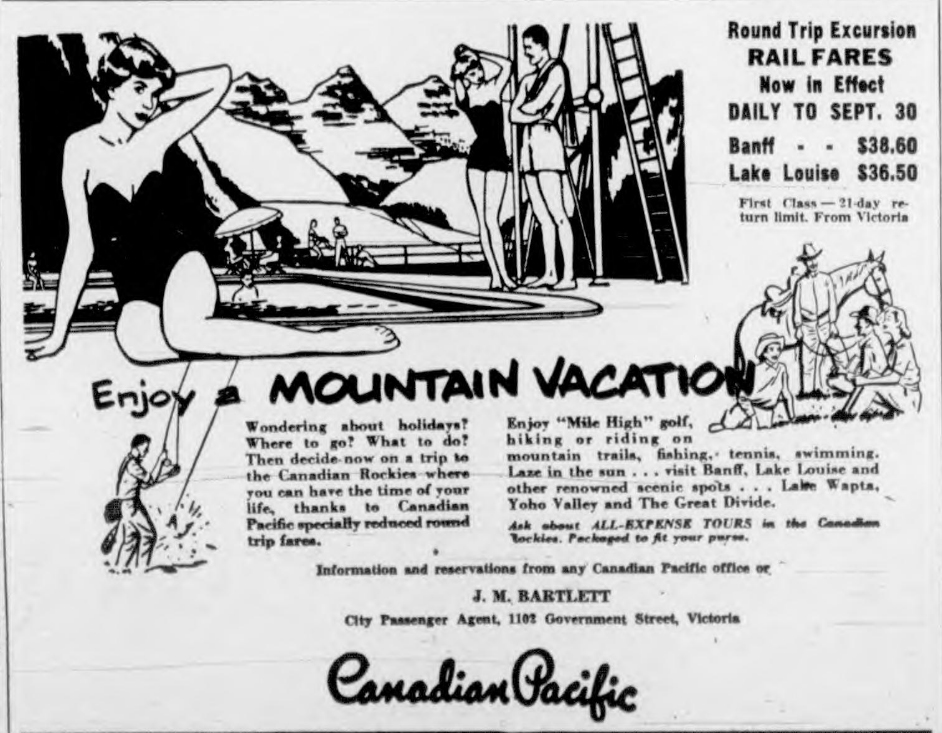
Enjoy a Mountain Vacation – ad for Canadian Pacific.
Mountaineers Were Burnt to Frazzle
Reported in the Comox Argus Wednesday August 6, 1952. p.1.
Twelve hikers from Courtenay, Cumberland, Cobble Hill and Switzerland were burnt to a frazzle when they climbed the Comox Glacier at the week-end. They left on Thursday [July 31] with veteran climber Sid Williams to show them the way. The party consisted of Sid Williams, Connie Bonner from Cobble Hill, Syd Watts from Duncan, Ruth Masters, Herb Bradley Heather Hooper, Dick McClure, Keith Morton, Doug Hemsworth, Mr. White from Banff, Cliff Garner of Cumberland, Louis Hopstetter from Switzerland, Morse Hatt and Bob Nikolaisen. The last two with two other Cumberland men left the party on the Glacier to climb across the rugged terrain to Moat Lake. The party went up by Comox Logging boat to the South Fork and climbed the Glacier that way. The first night they camped near the Black Cat Ridge and then coming back, on the edge of the Glacier. They came out on Sunday [August 3], camping at Cougar Lake. It was good, cloudless weather, all the way, but very hot. There is a lot of snow on the Glacier, more than Sid has seen ever at this time of year, but it is going very fast now. There was no danger from crevasses on the Glacier; they are still under feet of snow. On Mt. Becher, it is reported from the Forbidden Plateau Lodge that the first pack train has now gone in. Before this there was too much snow. It is estimated that eight feet of snow went in one week. There were very few windfalls to cut out this year on the trail beyond McKenzie Lake. About the trip Sid gave a much-appreciated talk to the Courtneay Rotary Club on Tuesday [August 5]. He said that one of the party, who climbed in the Rockies, said that in the Vancouver Island mountains there was all mountaineers had in the Rockies but on a smaller scale.
Picked ACC Camp Site
Reported in The Daily Colonist Saturday August 9, 1952. p.9.
Three Victorians, Ethne Gibson, Major Rex. Gibson and Cyril Jones, were on the reconnaissance party that selected the 1953 camp site of the Alpine Club of Canada on Scott Glacier. The seven-member party spent two weeks in the Scott Glacier area, about thirty-five miles from Jasper Park, exploring the terrain that will be used by 200 mountaineers from Canada, Australia, Great Britain and the United States next July. One of the features of the region is the Committee’s Punch Bowl, a lake at the summit of Athabasca Pass, named after the governing committee of the Hudson’s Bay Co. in the early days of fur traders. It was the meeting place of brigades travelling east and west.
Mayor Harrison Island Champion
He Says He Will Get Roads Even if He Has to Run as Member
Reported in the Comox Argus Wednesday August 13, 1952. p.8.
With the Forbidden Plateau as a background Mayor Claude Harrison spoke in glowing terms of the future of Vancouver Island if the provincial and dominion governments could be induced to build roads to develop its resources. He came up in his yacht to Comox on Friday [August 8] night with some Victoria guests, including General and Mrs. Pearkes. He showed some pictures of the Forbidden Plateau at a dinner in his honor on Friday night. This was when he had been the leader of the expedition into a sub-alpine paradise very largely unknown to the outside world. He expressed pleasure that one of the members of the expedition was present to see the pictures, namely Ben Hughes. He said that Vancouver Island had been very good to him and he was going to see that something was done about its development through roads, even if he had to run as a provincial candidate to push its claims in the Provincial Legislature. He did not see why the whole program of Island development could not be undertaken at once. There was a great deal coming to the island in the way of roads. For many years it had been neglected in favor of the mainland. The ports of the Island where much nearer the Orient than any others on the Pacific Coast and trade would certainly come to them in the course of years. Therefore the Island must be ready for the development when it came and it could only come through more roads. He was going to see that it did come. They did not require great highways but ordinary paved roads and they were entitled to get them. These roads should be taken into places where development would open up scenic and industrial possibilities. The dominion government had spent twenty-one million dollars on the development of B.C. and the island had not got one cent of it because the Island had no dominion park on it.
The Forbidden Plateau
Speaking of the forbidden Plateau Mr. Harrison said that it had all the scenic advantages of the mountain resorts of the mainland in a condensed form. If a road were put into it it would be possible to get into it and make of it a playground, winter and summer, very easily. It was certainly entitled to a road. Speaking on behalf of the Courtenay-Comox Chamber of Commerce, Mr. Lyall Barrie said they were more interested in a road to the northern end of the Island than they were to any loop road that might be built. Mr. Ben Hughes thanked Mayor Harrison for his talk. He said that most of the wealth of Vancouver Island had gone to make millionaires in Vancouver and very little of this wealth had come back to the Island in the way of development of its resources.
Victorians Help Set Up Camp in Rockies
Reported in The Daily Colonist Thursday August 14, 1952. p.3.
Seven officers of the Alpine Club of Canada are shown atop 10,000-foot Mount Brown, in the Scott Glacier area of Jasper National Park, during a recent reconnaissance trip. The area, about 35 miles from Jasper Park Lodge, has been established as the club’s summer camp site for 1953, when some 200 mountain climbing enthusiasts from Canada, United States, Great Britain and Australia will spend about two weeks climbing the towering peaks in the area. Rear left to right, are: Mrs. Ethne Gibson and Major Rex Gibson, Victoria: Henry Hall Cambridge, Mass.: Cyril Jones, Victoria: and Polly Prescott, Cleveland, Ohio. Front: Joe Cato, Edmonton, and Bradley Gilman, Worcester, Mass.
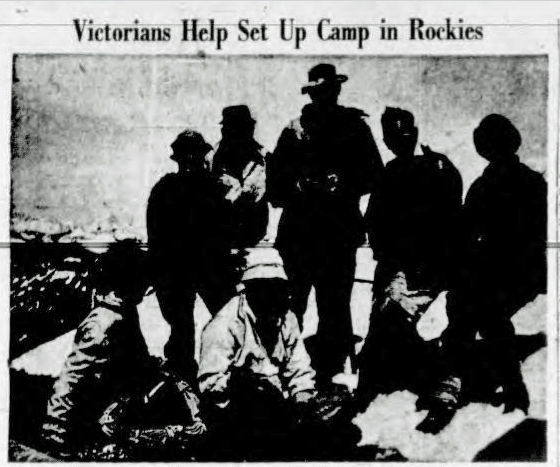
Victorians Help Set Up Camp in Rockies
Stuart Keate And Buttle Lake
Publisher of Victoria Times Thinks Damming Would Betray a Trust
Reported in the Comox Argus Wednesday August 20, 1952. p.6.
Writing in Maclean’s Magazine, Mr. Stuart Keate, publisher of the Victoria Times, describes what he was from the air of Buttle Lake and what he thought should be done about its conservation: “Mile upon mile of slash and burnt-over stumpage, mute testimony to man’s march up-Island.” Of Forbes Landing at the foot of Lower Campbell Lake, which has suffered the fate proposed for Buttle Lake, he writes: “giant grey trees poke withered limbs through the waters, drowned by the back-up of nearby John Hart dam construction.” Buttle Lake lies in an area an early government had the foresight to reserve as Strathcona park, a region to remain green and unspoiled whatever man chose to do to the surroundings. Mr. Keate implies there was no other way of seeing it than by air. This was not always so, as a trail of about nine miles, from the head of Upper Campbell Lake, wound round the foot of Mt. Elkhorn, and finally emerged at the foot of the beautiful unspoiled Buttle Lake
Old Survey Trail
This was an old survey trail, in good condition before the war, with no bad hills, and a pleasant day’s hike. It was possible to get transportation from the road-end at Upper Campbell to the lakehead, in a boat belonging to the Sutherland brothers, famed cougar hunters and trappers who lived there. There are patches of cleared land by the shores, and a few people live by Buttle lake all year, besides the summer homes that are annually visited by seaplane. And there is the view from the Forbidden Plateau. Having climbed to the top of Mount Albert Edward, the highest peak, a vast expanse of mountains and green forest meets the eye, and away down to the left a long, green gem of water, Buttle Lake. Before the road was extended up the coast from Campbell River, the No. 1 highway ran to the foot of Upper Campbell, and it was supposed one day it would be improved and provide access to Strathcona Park, even to Buttle Lake.
Drains Several Lakes
The Campbell River draining this area, runs through several lakes before reaching the John Hart dam, surely it is not necessary to ruin all the country—one of the wider stretches of fairly low land on Vancouver Island—where the mountains are close to the sea. The consideration of increasing the existing dam, or at least making one lower, would seem possible, as the water drains down to the sea from all these lakes anyway, without despoiling all this country which conservationists chose as the part to keep green. If Strathcona park was reserved by act of parliament, the present lawmakers hardly inspire confidence in the law by casting aside so lightly the decision of their predecessors.
Cyril Jones: A Man Always on The Level
Man of the Week
Reported in The Daily Colonist Sunday Magazine September 14, 1952. p.4.
By G.E. Mortimore
Victoria City engineer Cyril Jones is an amiable Welshman who scrambles up mountains like a youngster at the age of 63. He is a one-time bank clerk and school teacher who gained his civil engineering degree at University of British Columbia after a long spell of artillery duty in France during the 1914-18 war. Many years of plowing through the wilderness on survey crews have made him a handy woodsman. Cyril Jones (he has no middle name) was born in Swansea, Wales, the son of a steamship agent, one of a family of five. His youngest brother, the late W. Wynn Jones became Anglican bishop of Tanganyika (East Africa); his eldest brother, the late Eric Jones, became an engineer in Wales; and the third bother, Kenneth, is dean of Armadale in New South Wales, Australia. His only sister still lives in Wales. Cyril Jones went to Swansea Grammar School and then, at the age of 16, entered the old Capital and County bank as a clerk. He stayed five years on that job, chafing all the time for a more active and adventurous life.
Pick And Shovel
In 1912, he persuaded his father to get him a ticker to Canada. Shortly after he arrived in Victoria, he became a pick and shovel man for the city. “I always look upon Elford Street as the best street in Victoria, because I helped to build it,” he smiles. He then went to work for the old firm of Gore and McGregor, helping make surveys of the north end of Vancouver Island. After that he traveled east and worked on Dominion surveys of the Hudson’s Bay area. With the outbreak of the war in 1914, he went to England and joined the Royal Field Artillery, serving through most of the war in France. He left the army as a lieutenant, returned to Canada in 1920, and attended U.B.C. His survey work, private study and time spent calculating the trajectories of shells gave him a fair background of mathematics. He graduated three years later. To help put him through university, he worked for two summers on surveys for the city of Vancouver, and also took odd jobs during the term.
Once A Teacher
After his graduation, he left engineering for the time being and went to work as a teacher of mathematics and sciences at Brentwood College for four years. He spent some time working on the Pacific Great Eastern resources survey; came to the city in a temporary post in 1929, then joined the permanent staff in 1930 as a survey instrument man. He has been with the city ever since, except for a leave of absence in 1940-45, when he was an officer on the works staff of the Royal Canadian Air Force at Western Air Command, inspecting new air fields under construction. An ex-alderman who was chairman of public works described Mr. Jones as “a square-shooter and an excellent, conscientious engineer.” He steadily mounted the ladder of promotions. Finally, on January 1, 1949, he succeeded G.M. Irwin as city engineer. That is a post which he holds today. It places him in charge of construction and maintenance of streets, sewers and water-works within city boundaries. Under hi is an inside staff of thirty employees and an outside staff ranging up to 200 employees.
The Jones Family
Mr. Jones might be taken for an Englishman by his voice, although the quick nervous delivery of short bursts perhaps gives the clue to his Welsh origin. Mrs. Jones comes from Cirenchester on the county of Gloucestershire, England. Son Peter, a graduate engineer works for an engineering firm in Vancouver. One daughter, Mrs. Adrian Stone, lives in Duncan, and another, Meg, is at present on a visit to England. Mr. Jones has delivered occasional papers to the Corporation of Canadian Surveyors at conventions. He does a certain amount of photography, and hopes to have a home ark room soon. He is also a beginning golfer, and in the past played cricket for the old Wanderers. His chief interest is in the outdoors. He belongs to Victoria Outdoor Club and the Victoria section of the Alpine Club of Canada, in both which clubs he is a valuable and popular member. In the air force during the war, he had the reputation of never calling for a transport truck if he could cover the distance on foot.
Climbing Mountains
Last season he was on the Alpine Club’s advance party which scouted out the site for next year’s camp up the Whirlpool River towards Athabasca Pass. He also spent some time at this year’s camp near Mount Assiniboine, climbed 10,000-foot Mount Sturdee, and walked so fast on the trek out from camp that several young people found it hard to keep up with him. He is an excellent axeman and a skilled surveyor – accomplishments which make him very useful on outdoor jaunts. In the course of a trip, he likes to step off now and then to swim or fish in a lake or stream. He’s a modest cheerful man, very easy to get along with. When he comes to a group of fellow members of the club, he doesn’t force his way into the conversation with loud hails, but merely stands there with his friendly grin until the talk reaches out to include him.
Handyman Plus
He is a handyman, fixing his own equipment and other people’s as well. Shrewd and careful though he is, Mr. Jones suffers from occasional lapses – such a time he repaired his pack and put it together upside down. He passed off the mistake by solemnly remarking that it was handier that way, because all the contends fell out as soon as he opened the pack and saved him the trouble of unloading. Members of the Alpine Club, who have a way of kidding one another, refer to Cyril Jones variously as “The beaming gentleman with his pack on upside down.” “The gentle knight,” “One of the Jones boys” and Cyrus.” Among Cyril Jones’ talents is the ability to give a lively and convincing imitation of a rooster crowing. On overnight camping trips, when it is necessary for people to get up at 4 a.m. for a swim, he can be relied upon to wake them at exactly the right time with his special rooster noise. He whips around town in a 1939 Packard convertible, with the top down much of the time. For three years he has been a judge at Optimist hobby shows here, appraising model cars, airplanes and cranes with a professional eye. The silliest experience in his career happened at Hardy Bay, when he went out fishing and duck hunting with the cook. The cook accidently shot a hole in the bottom of the boat, and the pair of them spent some time resting comfortably on the sea bottom in three feet of water.
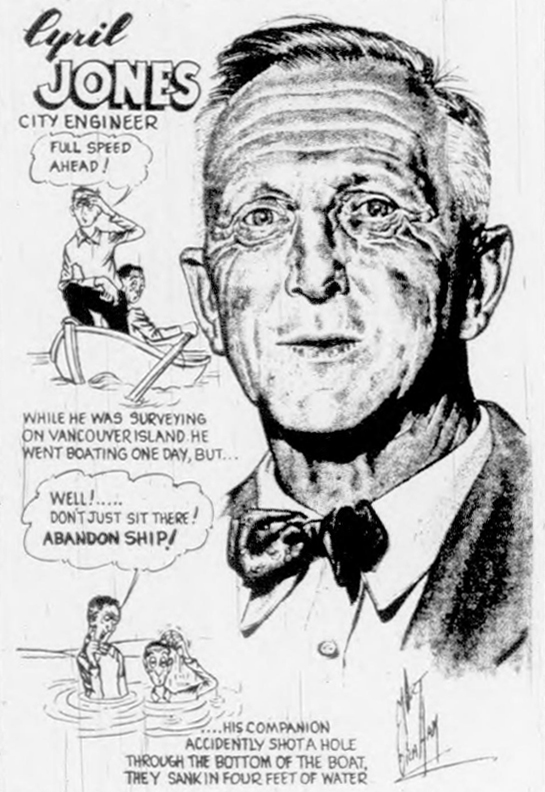
Cyril Jones cartoon.
Skiers Are Getting Ready
Reported in the Comox Argus Wednesday October 15, 1952. p.11.
When the snow covers the slopes of Mount Becher the skiers of the Comox District Mountaineering Club will be ready for it. They have plans laid out for a big season this winter. At a meeting of the club recently, plans were laid, officers and committees elected. Wood parties are already out at both cabins laying in fuel for the coming season. Keith Morton has been re-elected president with Dick McClure, vice-president, Linda Williams, secretary and Vera Bradley, treasurer. The ski patrol for the first aid and safety on the mountains will have Herb Bradley as captain. Members of the patrol include Stan Rushton, Archie Rankin, Dick McClure, Sid Williams, Oscar Petersen, Richard Webb, Angie Strachan, Bob Nikolaisen and Phillip Bickle. Ways and means committee: Ruth Masters, Heather Hooper, Cliff Gardner, Jack Emmett, Don Archibald, Vera Bradley and Donald Gordon. Membership committee: Ruth Masters, chairman; Tab Davis, Donald Gordon, Robert Kirk. Care and maintenance of ski tow: Keith Morton, Bob Nikolaisen, Archie Rankin, Tab Davis and Brian Bailey.
1953
ACCVI executive:
Chairman – Mark Mitchell
Secretary – Jean McDonald
Events:
February 27 – Dr. Fred Ayres of Portland, Oregon, gave an illustrated talk on the first ascent of Nevado Salcantay in Peru.
March – Club trip to the Gowland Range.
March 26 – Clubs annual banquet at Lougheed’s banquet room. Muriel Aylard and Mabel Duggan showed slide of their European trip including Mabel’s ascent of the Matterhorn and Zinal Rothorn.
April – ACC Mt. Robson Ski Camp.
April – Club trip to Waterloo Mountain.
May 16/17/18 – Club trip to Mt. McQuillan saw eight members reach the summit.
June 14 – Club trip to Mt. DeCosmos saw eight members reach the summit.
July 1 – Club trip to Saturna Island. Twenty members were taken on Miles Smeeton’s ketch “Tzu Hang.”
September 4/5/6/7 – Club trip to Big Interior Mountain led by Rex Gibson and Mark Mitchell via Drinkwater Valley. Thirteen members reached the summit.
Section members who attended the ACC ski camp at Berg Lake/Mt. Robson: Noel Lax, Margaret Reiss, Patrick Guilbride.
Section members attended the ACC summer camp at the Hooker Icefield July 20 to August 2: Muriel Aylard, Aileen Aylard, Connie Bonner, Geoffrey Capes, Mabel Duggan, William Foster, Rex Gibson, Ted Greig, Ted Goodall, Heather Hooper, Cyril Jones, Bill Lash, Sylvia Lash, Ruth Masters, Peter Thomas, Syd Watts.
Section members who passed away in 1953: Herbert Shade, Charles Whitney-Griffiths
Edward Goodall Talk
Reported in The Victoria Daily Times Friday January 16, 1953, p.13.
Edward Goodall, a member of the Victoria section of the Alpine Club of Canada, provided the program for the weekly meeting of the Oak Bay Kiwanis Club Thursday night at Oak Bay Beach Hotel. Mr. Goodall described a climbing expedition last summer in the Rockies near Banff. His talk was illustrated with colored slides.
Mountaineering Club Marks 25th Anniversary
Reported in the Comox Argus Wednesday February 4, 1953, p.12 & 13.
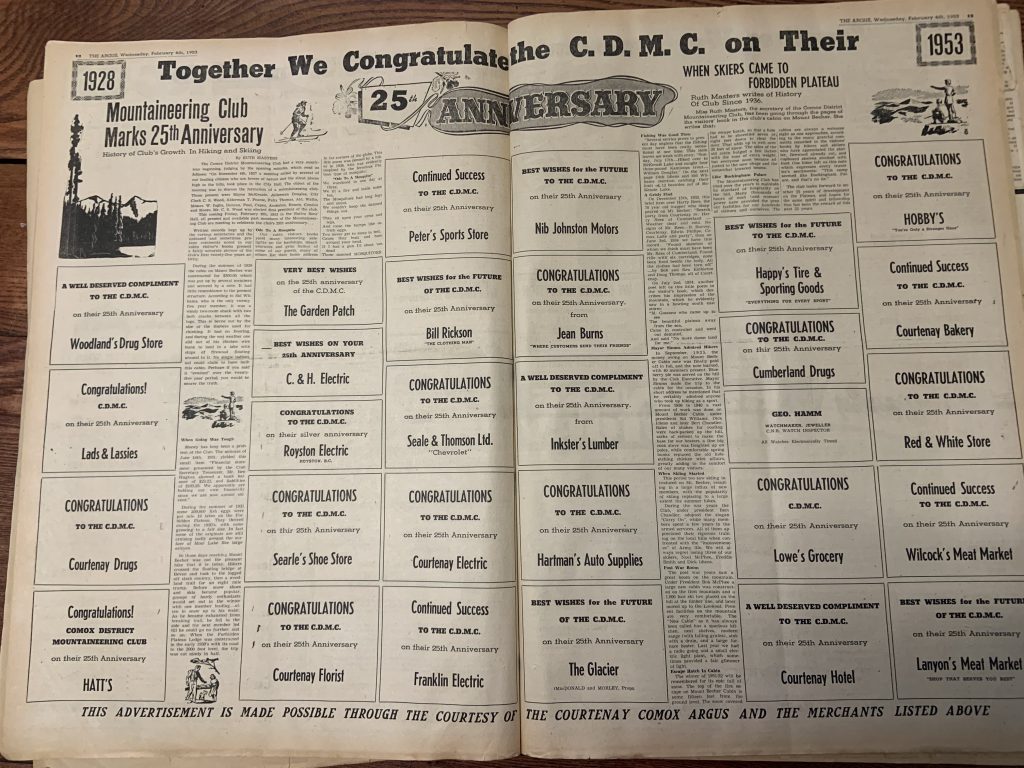
A two-page newspaper spread congratulating the CDMC on their 25th Anniversary: 1928 to 1953.
History Of Club’s Growth in Hiking And Skiing
By Ruth Masters
The Comox District Mountaineering Club had a very auspicious beginning judging by the opening minutes, which reads as follows: “On November 4th, 1927 a meeting called by several of our leading citizens who are lovers of nature and the silent places high in the hills, took place in the City Hall. The object of the meeting was to discuss the formation of a mountaineering club. Those present were Mayor McKenzie, Alderman William Douglas, City Clerk Clinton S. Wood, Alderman T. Pearse, Felix Thomas, Alderman Wallis, Messrs. W. Inglis, Duncan, Adrian Paul, Geoffrey Capes, Anderton, Hames, Condon and Moore. Mr. C.S. Wood was elected first president of the club. This coming Friday, February 6th, 1953 in the Native Son’s Hall, all present and available past members of the Mountaineering Club are meeting to celebrate the club’s 25th anniversary. Written records kept up by the various secretaries and an unbiased and sometimes profane comments noted in our cabin visitor’s books present a fairly accurate picture of the club’s first twenty-five years activity. During the summer of 1928 the cabin on Mount Becher was constructed for $300.00 which was put up by several members and secured by a note. It had little resemblance to the present structure. According to Sid Williams, who is the only twenty-five-year member, it was a windy two room shack with two-inch cracks between all the logs. This is borne out by the size of the timbers used for chinking. It had no flooring and during the wet weather one slid out of the chicken wire bunk to land in a lake with chips of firewood floating around in it. No single individual could claim to have built this cabin. Perhaps if you said it “evolved” over the twenty-five-year period, you could be nearer the truth.
When Going Was Tough
Money has long been a problem of the club. The minutes of June 16th, 1931, yielded this small item “Financial statement presented by the Club Secretary-Treasurer, Mr. Ben Hughes showed a bank balance of $23.22 and liabilities of $105.95. We apparently are holding our own financially since we are now almost solvent.” During the summer of 1931 some 200,000 fish eggs were put into 19 lakes on the Forbidden Plateau. They thrived during the 1930’s with some growing to a fair size. In fact, some of the originals are still cruising lazily around the surface of moat lake like large salmon. In those days reaching Mount Becher was not the pleasant hike that it is today. Hikers crossed the floating bridge at Bevan and took to the logged off slash country, then a woodland trail for an eight-mile tramp. Before snow shoes and skis became popular, groups of hardy enthusiasts would set out in the winter with one member leading—often in snow up to his waist. As he became exhausted from breaking trail, he fell to the side and the next member led till he could go no further, and son on. When the Forbidden Plateau Lodge was constructed in the early 1930’s with its road to the 2000-foot level, the trip was cut nicely in half.
“Ode To a Mosquito”
Our cabin visitors’ books yield many interesting sidelights on the hardships, misadventures and grim humor of some of our guests, many of whom list their home address in far corners of the globe. This little poem was penned by a hiker in 1936, who was evidently inspired by the ferocious Plateau type of mosquito:
We wandered in one day at three,
We lit a fire and made some tea. The mosquitoes had long legs and snout,
We, couldn’t keep the damned things out.
They sit upon your arms and legs,
And raise the bumps like ostrich eggs.
You never get to sleep in bed,
Cause the buzz and hum around your head.
If I had a gun I’d shoot them dead,
Those damned MOSQUITOES.
When Skiers Came to Forbidden Plateau
Ruth Masters writes of History of Club since 1927.
Miss Ruth Masters, the secretary of the Comox District Mountaineering Club, has been going through the pages of the visitors’ book in the club’s cabin on Mount Becher. She writes that:
Fishing Was Good Then
“Several entries prove to present day anglers that the fishing must have been really sensational at one time. This item leaves me weak with envy: “Sunday, July 17th—Hiked over to McKenzie Lake and caught four three-pound Kamloops trout—William Douglas.” On the next page Dick Idiens and Sid Williams mention catching their limit of 12 beauties out of McKenzie Lake.
A Grisly Find
On December 5th, 1933, this brief item over Harry Rees, the 70-year-old trapper who disappeared on Mount Becher: “Search party from Courtenay re: Harry Rees of Cumberland—Weather clear and cold. No signs of Mr. Rees—Barty Harvey, Courtenay, Edwin Phillips, Comox Lake and party”, then on June 3rd, 1934 we have found his record: “Found skeleton of whom we think must have been Mr. Rees of Cumberland. Found rifle with six cartridges, none been fired beside the body. All the clothes had been torn off”—by Bob and Rex Embleton and Dog Thomas, all of Courtenay. On July 2nd, 1934, another poet left us his little poem in the visitor’s book, which describes his impression of the mountain, which he evidently saw in a howling south east storm:
Gozzano came up to see
The beautiful plateau away from the sea,
Came in contruted and went out demuted,
And said “No more damn land for me.”
Mayor Simms Admired Hikers
In September 1935, the money owing on Mount Becher Cabin note was finally paid off in full, and the note burned, with 40 members present. Blueberry pie was served on the hill by the Club Executive. Mayor Simms made the trip to the cabin for the occasion. In his short address he mentioned that he certainly admired anyone who took up hiking as a sport. From 1936 to 1940 a vast amount of work was done on Mount Becher cabin under Presidents Sid Willaims, Dick Idiens, and later Bert Chandler. Bales of shakes for roofing were back-packed up the hill, sacks of cement to make the base for our heaters, a fine big cook stove was freighted up on poles, while comfortable spring bunks replaced the old hide-etching chicken wire affairs, greatly adding to the comfort of our many guests.
When Skiing Started
This period too saw skiing introduced on Mount Becher, resulting in a large influx of new members, with the popularity of skiing replacing to a large extent the summer hikes. During the war years, the club under president Bert Chandler, adopted the slogan “Carry on”, while many members spent a few years in the armed services. All of them appreciated their rigorous training on the local hills when confronted with “inconveniences” of Army life. We will always regret losing three of our skiers, Noel McPhee, Freddie Smith and Dick Idiens.
Post War Boom
The post war years saw a great boom on the mountain. Under President Bob McPhee a large new cabin was constructed on the first mountain and a 1000-foot ski tow placed on the hill at the timber line, and later moved up to the Lookout. Present facilities on the mountain are very comfortable. The “New Cabin” as it has always been called has a spacious kitchen, neat shelves, modern range (with falling grates), sink with a drain, and a large furnace heater. Last year we had a radio going and a small electric light plant, which sometimes provided a fair glimmer of light.
Escape Hatch Is Cabin
The winter of 1951-52 will be remembered for its epic fall of snow. The top of the fire escape on Mount Becher Cabin is some fifteen feet from the ground level. The snow covered the escape hatch, so that a hole had to be shoveled seven or eight feet down to clear the door. That adds up to well over 20 feet of snow. The sides of the old cabin bulged a few inches with the tons of extra weight, but everyone soon became adjusted to the new shape and the somewhat lowered beams.
Like Buckingham Palace
The Mountaineering Club has tried over the years to maintain its standard of hospitality on the hills. Many thousands of hours of man (and woman) power have provided facilities for our hundreds of visitors and ourselves. The cabins are always a welcome sight as one approaches, according to the many grateful comments recorded in the visitors’ books by hikers and skiers who have appreciated the shelter, firwood already cut, and cupboard shelves stocked with food. One hiker left us this note which expresses every traveler’s sentiment: “This camp seems like Buckingham Palace, and that’s no lie.” The club looks forward to another 25 years of development on the Plateau, and hopes for the same spirit and fellowship that has been the reward of this past 25 years.
Work Session Scheduled on Ski Tow
Reported in The Daily Colonist Thursday March 5, 1953, p.9.
Mount Brenton will be the scene of a special work session Sunday when a large group of skiers from the Victoria Sno-Bird Ski Club will be busy completing a ski tow. Anyone interested in joining the group is asked to register at 905 Government before 5 p.m. Friday. Last Sunday nine members of the club enjoyed good skiing on the slopes of Mount Brenton. They included Bill Payne, Bill Higgins, Grace and Theo. Waters, Mary Young, Barry Hall, Albert Hafer, Joe Twaits and Fred Buckmaster.
Victoria, Island Alpinists Attending Annual Ski Camp
Reported in The Daily Colonist Thursday April 2, 1953, p.24.
Victoria and Vancouver Island alpinists are included among skiers from all parts of Canada attending the annual ski camp of the Alpine Club at Berg Lake in Mount Robson Provincial Park. A.C.L. Warner, general passenger agent for the CNR announced yesterday that arrangements are complete for the camp to be held April 3 to 11. Island residents taking part in the camp are Noel Lax, 398 Constance Avenue; Miss Margaret Reiss, 1218 McKenzie Street, and Patrick Guilbride, Chemainus. The campsite is located about 13 miles from Mount Robson on the CNR’s transcontinental line.
Alpine Party Scales Mountain
Reported in The Daily Colonist Wednesday May 20, 1953, p19.
Eight members of the Victoria section of the Alpine Club of Canada climbed 5,160-foot Mount McQuillan, overlooking the Alberni canal during the week end. Purpose of the club is to encourage Canadians to climb mountains of their own country; develop an appreciation of natural beauties, and to learn the art of mountain climbing and camping.
ACCVI Trip to Big Interior Mountain
September 4 to 7, 1953
Recorded in the personal diaries of Geoffrey Gapes, and edited with Syd Watts oral account.
September 4 – Left [Courtenay] at 6:15 p.m. drove to Qualicum, branched off on Hilliers Road on to the main road past Cameron Lake, through the heavy timber in MacMillan Park [Cathedral Grove] over the summit to Alberni, branched off, arriving at Great Central Lake at 8:30. No sign of anyone else so took the car down a bumpy disused road. Then waited on the main road, went back to the car to get my thermos and sandwiches; it was not till after 10 that Syd Watts, Connie Bonner, and Dr. Roger Stanier arrived from Duncan; eventually Rex Gibson, Margery Thomas and party arrived. I was on the wrong road so had to drive back a little way. The four cars had some difficulty turning. Most of the occupants slept on the road side. I slept rather cramped on the back seat of the car.
September 5 – Saturday. Up before dawn, cooked a breakfast by the road side, then made up our packs and went to Great Central Lake. It was 8:45 when 13 of us, Dr. Mark Mitchell had driven from Victoria this morning. Rex Gibson leading the party, Dr. Mitchell, Roger Stanier, Peter Thomas, Derek Hawkins, Nigel Scott-Moncrieff. Bob Taylor, Cyril Jones, Connie Bonner, Margery Thomas, Syd Watts, David Francis and myself. It is 25 miles up Great Central Lake. We started up the old logging road and mining trail at 10:45. It was hot, and the leaders went too fast, we did 4 miles by noon, when we stopped in a pleasant spot for lunch; hot tea was made. We climbed steadily the rest of the day, passing numerous remains of the old mining claims. Cyril Jones’ lunch had upset him, and 2 of us stayed with him; we caught up with the party the other side of a very rickety bridge, where hot tea was made. Another party of 3 girls and a man passed us here, they had been given a 5-mile lift in the Forestry truck. Afterwards I stayed with Cyril Jones till we reached an old mining camp on the Drinkwater River about 5. Here we decide to camp. A fair-sized log crossed the river; during the trip I had to cross it several times, and did not feel happy about it. Those that had tents pitched on the other side; I put down my sleeping bag, with my light plastic rain coat as a ground sheet. I made my supper, with about 3 or 4 others; hot tea and soup being all I actually wanted, though I did manage a sausage. It had been a very hot walk, with our packs, and I for one had sweated a lot. Turned in immediately after supper, before 8.
September 6 – Sunday. It was dark, about 4, when Rex roused us. We got our breakfast in the dark and were on our way before it was very light. We followed the left bank of the Drinkwater, through the fairly open woods, then some fairly hard bush whacking, until we were in an open basin; we soon came to a fairly steep snow field, up which we climbed; David the chap with the low shoes clambered up the cliffs. Above the snow field, we had a short traverse; across which to be on the safe side, we tied a doubled rope to a tree. Peter Thomas held the lower end; there was steep climb through some bush, then above this we started up the main snow field, which edged round to the North; we stopped for lunch on some rocks, then back to the snow field, which we gently, until we approached a small badly crevassed glacier. At that point Rex decided to put four of us on a rope; he leading, Peter Thomas, Margery Thomas, and myself on the end; the snow was steep, but in good condition, though the ice axe would not sink more than 6 inches. Rex leading, kicking steps, the others following; we had some areas of rock, up one was a fairly difficult pitch. The main peak of 2, although both looked about the same height, was of course the farthest away, we got off the snow onto the stoney approach and were on the summit of Big Interior at 2:20. The sky had become hazy and there were a few drops of rain. The four of us unroped, and in 15 minutes were descending the South side of the mountain towards Della Lake; first over talus then on to snow; and rock patches; at about 5000 some prospectors had blasted into the mountain slope a passage about 10 feet by 6 feet high and over 3 feet wide; and just above had started another. We kept fairly high, traversing several long snow fields; I was the last and simply could not keep up with the others, Derek Hawkins stayed with me, until we reached Della Lake about 4:15, then for a while I kept up with the other. There was not trail around the lake; we had to move up and down the bluffy edge, a most uncomfortable part of the trip; when one was forced to stop, the mosquitoes covered one. I dropped my wrist watch, but luckily the chap behind me, picked it up. By the time I reached the easier going at the end of the lake, there were only 2 chaps nearby. Roger Stanier and I forgot the other chaps name; we had to cross 2 creeks to at last reach the very steep trail. Roger Stanier left his axe behind and when we discovered the loss, would not go back. The other 2 went on, the height of the mountain here is probably at least 1000 feet. Della Falls, the main fall, and 2 lesser ones were northwards. The trail is so steep in places, that thick wires are attached to trees for packmen to hang on to. I was not too afraid to use them. It rained harder, and the clinging bush, was wet, so that it was not long before I was soaked to the skin; I had no rain jacket. It was a relief to at last reach the flatter ground although the bush covered the trail. I could see the smoke rising from the camp fires and I got in about 7:15, the other 2 apparently had got off the trail and were not much ahead. All the four fires were on the other side of the river. Hot tea was ready. Later on had some soup, cocoa with some brandy in it. I had to cross the log by flash light. Everybody who had no tents, made shelter, and Dr. Mitchell made room for us in his tent. He was not feeling well, so would not eat. Nobody had any change of clothing; I did have dry socks for the morning; it was after dark when I turned in.
September 7 – Monday. The rained ceased during the night, I had heard on the tent for a time, made a breakfast of bacon and one egg, and tea. It was overcast, but fine. Packed up. I walked down with Margery Thomas and Dr. Mitchell: two others catching us up a long way down. The weather was pleasant. About 5 minutes from the Lake, the Forestry chap met us; five had left their packs on his big truck and had walked on. Rex arrived and it was decided we should ride the rest of the way, in case the boat got in earlier than arranged. It was the roughest ride I have ever had, the road was rough, the truck travelling over boulders in places; he had to drive carefully over bridges; we had to watch for overhanging branches, we picked up the other 5, and reached the Forestry Camp about 10:45. There is a wash house with showers, basins, hot and cold running water, and a big store. We dried our still wet clothes around the store, we had a good wash, one had a shower, and several shared, 2 went for a swim in the Lake. We also lunched. Paddy Burke arrived about 1:15; and we reached the end of the Lake about 3:15; I had a snooze part of the way. I changed my clothes in the car. We all met again at the Three Sisters Café in Alberni; I had apple pie with ice cream, and tea. Returned via Hilliers and went through Qualicum valley as I missed the turn; by the hotel. The sun came out. Reached home just after 6 p.m.
Included in the party were Rex Gibson, Mark Mitchell, Roger Stanier, Peter Thomas, Derek Hawkins, Nigel Scott Moncrieff. Bob Taylor, Cyril Jones, Connie Bonner, Margery Thomas, Syd Watts, David Francis, Geoffrey Capes.
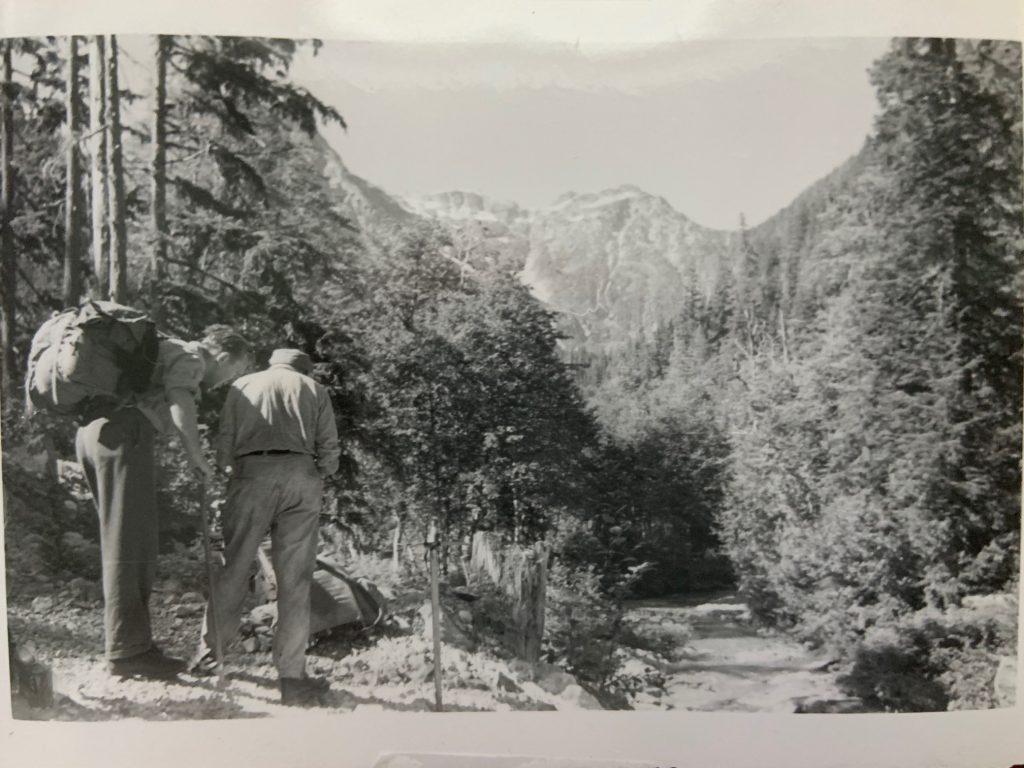
Rex Gibson and Peter Thomas stop to look at the map of Big Interior Mountain at the head of the Drinkwater 1953 – Syd Watts photo.
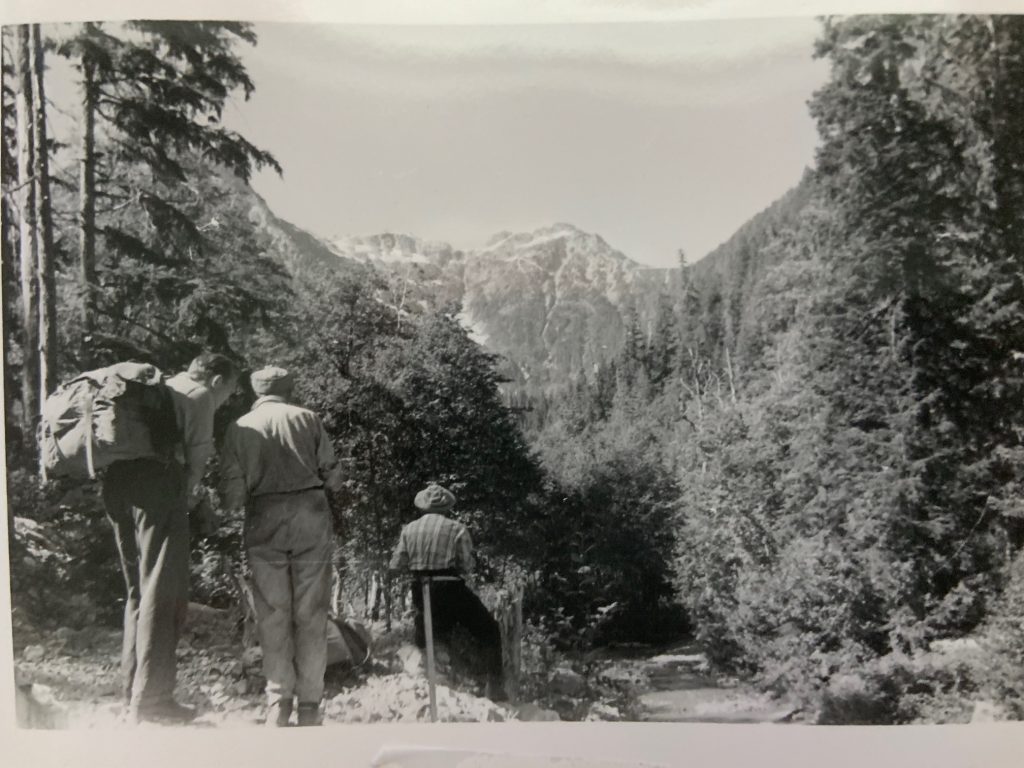
Rex Gibson and Peter Thomas stop to look at the map of Big Interior Mountain at the head of the Drinkwater 1953 – Syd Watts photo.
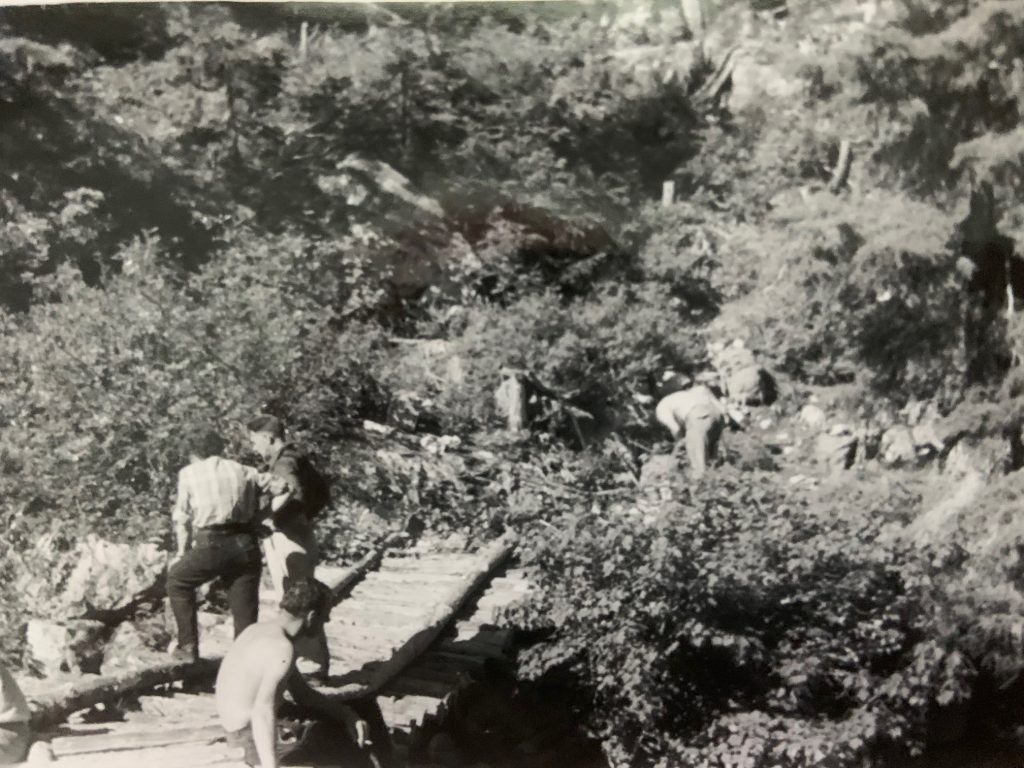
Taking a break on the bridge at the base of Della Falls – Syd Watts photo.
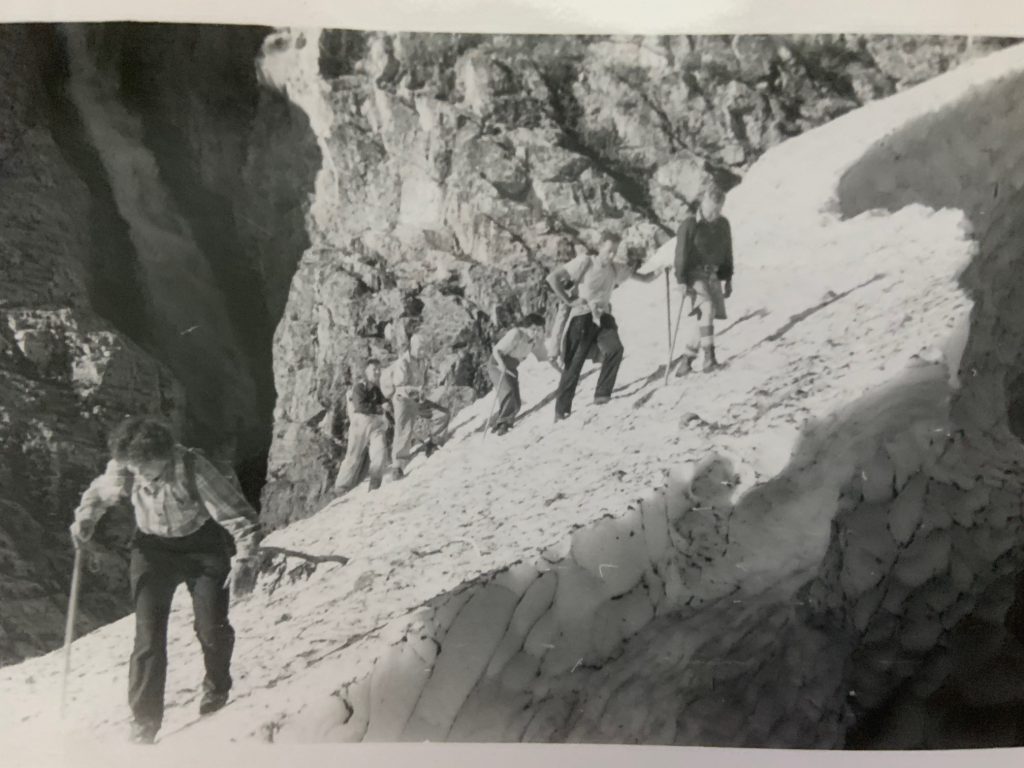
Crossing steep snow on the way up Big Interior Mountain 1953 – Syd Watts photo.
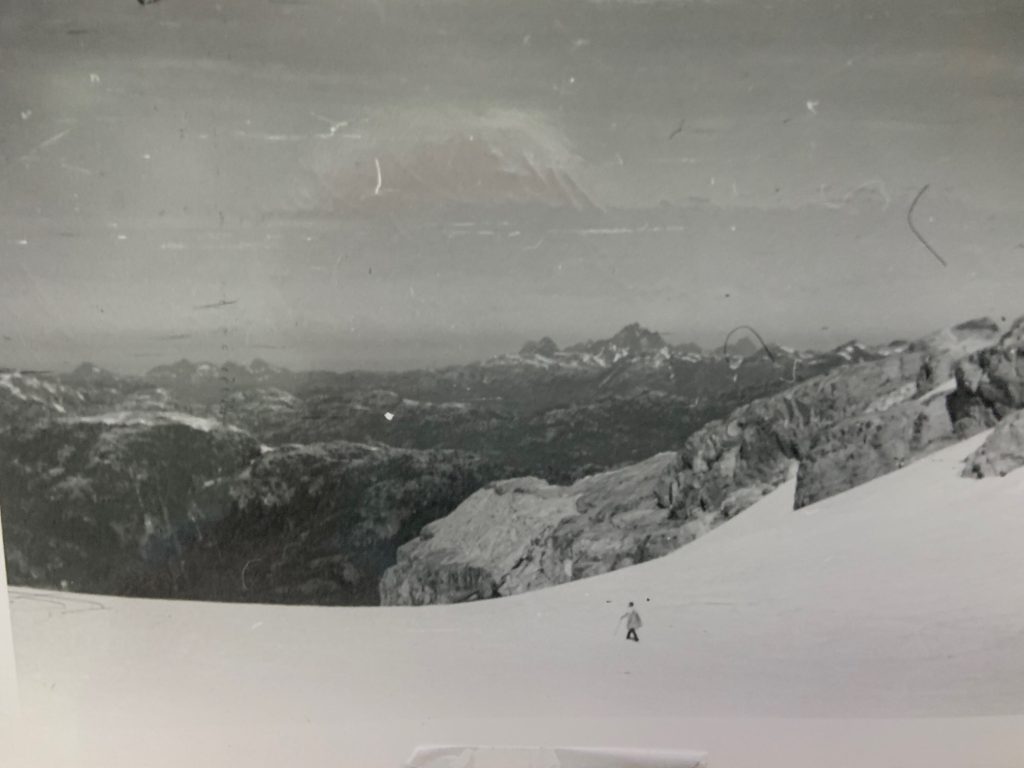
Looking at the Golden Hinde from the snowfield on Big Interior Mountain 1953 – Syd Watts photo.
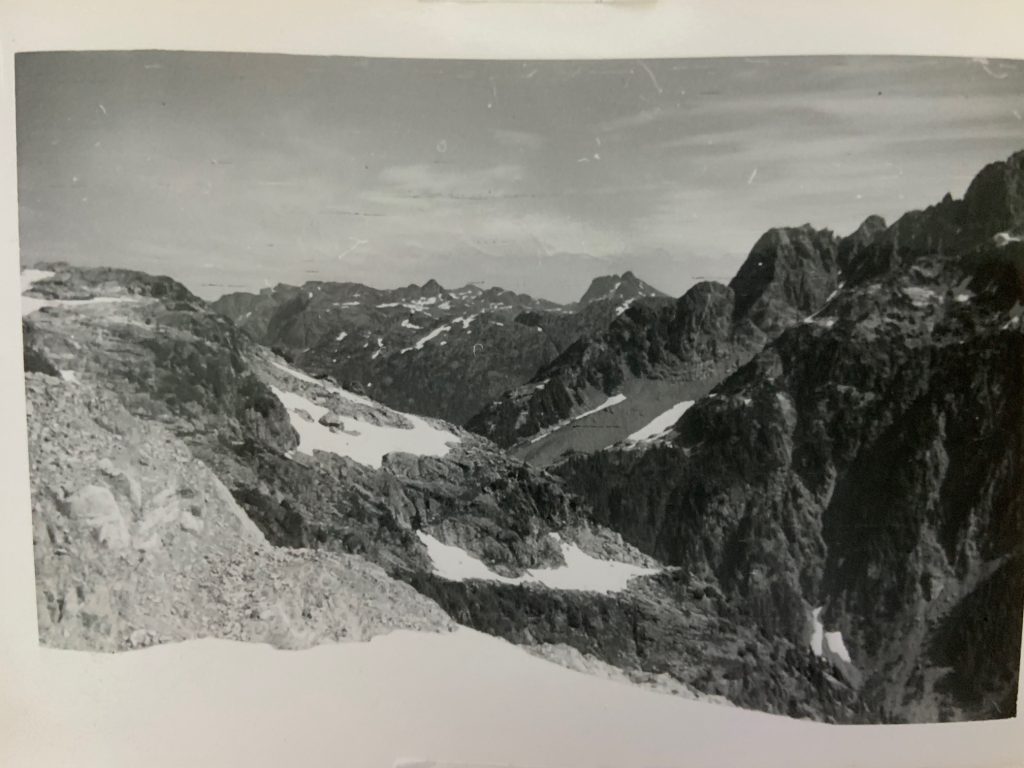
Looking up to the head of Drinkwater Creek. Mt. Harmston in the distance with Mt. Septimus on the right. 1953 – Syd Watts photo.
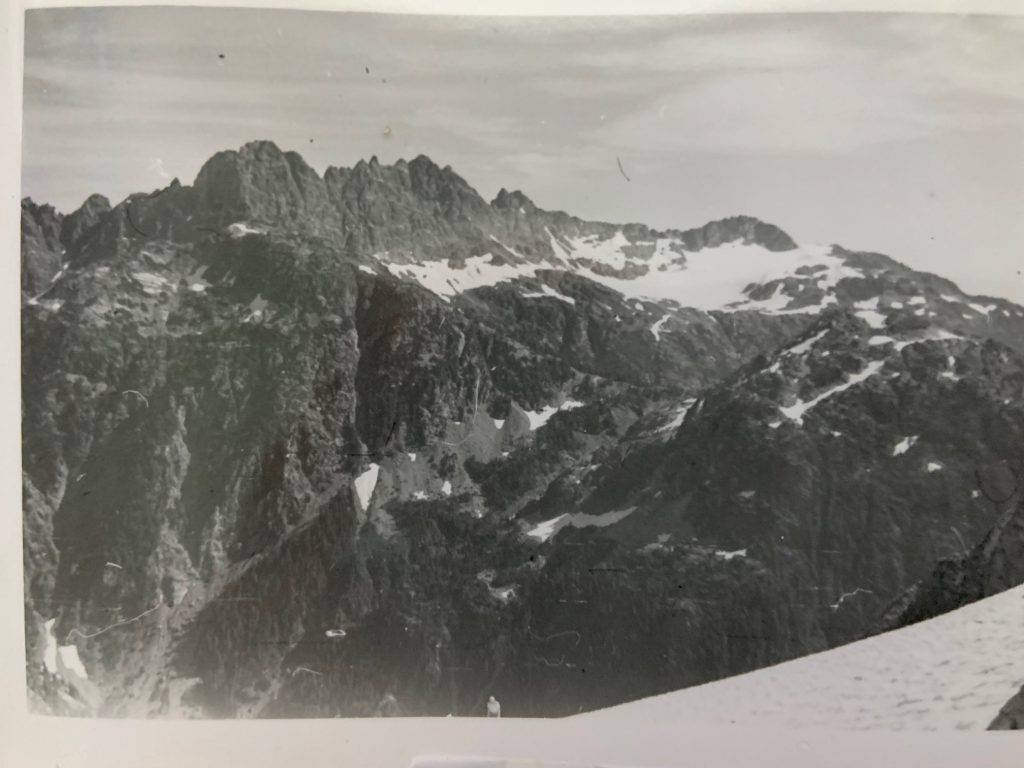
Mt. Septimus on the north side of the Drinkwater Creek 1953 – Syd Watts photo.
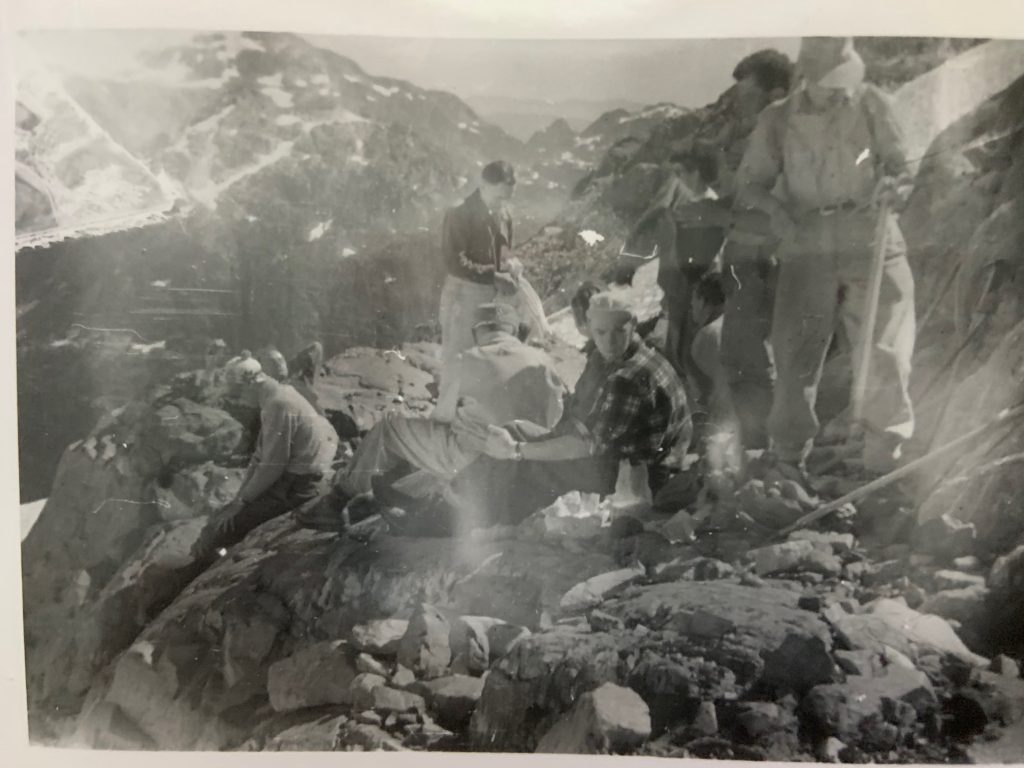
Lunch on Big Interior Mountain 1953. Geoffrey Capes on right with ice axe, Nigel Scott-Moncrief behind him. Rex Gibson sitting with back towards camera and Mark Mitchell standing beyond. – Syd Watts photo.
A Letter from Everest Hero
Alpine Club Receives Letter from Colonel Hunt
Reported in the Comox Argus Wednesday August 19, 1953, p.4.
A postcard has been received by Mr. J. White, secretary of the Qualicum Beach Alpine Club from Lieutenant Colonel John Hunt, one of the conquerors of Mt. Everest, acknowledging the congratulations of the club, which were sent as soon as the news reached this country. “I would like you to know,” wrote Colonel Hunt, “what very genuine pleasure it has given not only to myself, but to every member of the team, to know that it has been a source of inspiration to so many people at home and aboard.”
Local Alpine Club Members Scale Strathcona Park Peak
Reported in The Daily Colonist Friday September 11, 1953, p.6.
A 13-member party, organized by the Vancouver Island section of the Alpine Club of Canada, scaled Big Interior Mountain in Strathcona park during the Labor Day Weekend. Big Interior, 6,107 feet high, is one of the highest more accessible mountains on Vancouver Island. The party reached the mountain by traveling up Great Central Lake and hiking across a 10-mile stretch of rugged intervening terrain. The climb was a precarious one, across open crevasses, up and down steep cliffsides and across treacherous snow which covered glaciers at high altitudes. The party was led by Mr. Mark Mitchell of Victoria and Major Rex Gibson of Saanichton. Others in the party were David Francis, Nigel Scott-Moncrieff [a nephew of Gibson’s wife Ethne], Margery Thomas, Pete Thomas, Derek Hawkins, Bob Taylor, Cyril Jones, city engineer, all from Victoria, and Dr. Roger Stanier, Berkeley, California; Syd Watts, Duncan; Connie Bonner, Cobble Hill; and Geoffrey Capes, Courtenay. A base camp was established on the southern side of the peak near Della Falls, located at the 1,900-foot level. The actual climb started at 5:30 a.m. Sunday. The party crossed a saddle below the peak to the north side of the mountain, establishing what is believed to be a new route, and then up the glacier on the north face to the peak. The descent was made on the south face of the mountain down the steep and lofty cliffs above Della Lake and valley. Members of the party described the valley as a mass of Alpine flowers of every variety. The route ran along the north side of the lake to the top of Della Falls, then down a trail leading back to base camp. The ascent and descent, termed a traverse by alpinists, took 13 hours. Weather was excellent until the party reached the summit when it began closing in. The mountaineers said the view from the summit of Big Interior Mountain was “really magnificent.” Many of the higher peaks of the island could be seen including the Golden Hinde, 7,200 feet and highest peak on the Island, and Mount Septimus, 6,200 feet. Mount Septimus, an imposing mountain with a glacier and lateral moraine, will likely be on the club’s climbing schedule for Labor Day week end next year.
Development of Island Park Urged by Climber
Reported in The Victoria Daily Times Friday September 11, 1953, p.3.
The immediate development of Vancouver Island’s Strathcona Park was urged today by Dr. W.E. Mark Mitchell, president of the Victoria section of the Alpine Club of Canada. Dr. Micthell was one of the leaders of an expedition into Strathcona Park which scaled Big Interior Mountain, one of the Island’s major peaks, over the Labor Day week-end. “It is a beautiful park,” said Dr. Mitchell, “something should be done to develop it and make it accessible to the public.” Pending the development of the park, Dr. Micthell said the provincial government should maintain the trail in the park, including one small cabin near Della Falls [Joe Drinkwater’s log cabin]. He said this cabin was maintained by the Forestry Department, but has now been allowed to go to pieces. The cabin is needed to provide shelter for people who enter the park, he said.
Near Della Falls
Big Interior Mountain which has been climbed by 13 members of the Alpine Club is 6,107 feet high. It is situated near Della Falls, about 10 miles north of Great Central Lake. Others in the party were Major Rex Gibson of Saanichton. Others in the party were David Francis, Nigel Scott-Moncrieff, Margery Thomas, Pete Thomas, Derek Hawkins, Bob Taylor, Cyril Jones (city engineer), all from Victoria, and Dr. Roger Stanier, Berkeley, California; Syd Watts, Duncan; Connie Bonner, Cobble Hill; and Geoffrey Capes, Courtenay. To reach the summit of the peak, the climbers had to cross open crevasses and walk across treacherous snow which covered glaciers at high altitudes. Members of the party said the view from the summit of Big Interior Mountain was “magnificent.” While on top of the peak, the mountaineers took a good look at Mount Septimus, 6,200 feet, which they hope to climb on Labor Day week-end next year. It is an imposing peak with a glacier.
1954
ACCVI executive:
Chairman – Bill Lash
Secretary – Margery Thomas
Events:
February 27/28 – Club ski trip to the Olympic Mountains.
March 8 – Sir Edmund Hillary, Dr. Charles Evans, George Lowe and James Morris delivered a lecture on the 1953 ascent of Mt. Everest. The Victoria Daily Times initiated the organizing of the lecture and the audience of over 4,000 people was reportedly the biggest one which the Everest climbers had addressed in their whole tour of North America.
March 14 – The section conducted a rock school on Mt. Tzouhalem.
April 9 – At the annual banquet of the Vancouver Island section, Peter Schoening of Seattle was invited to show slides of the 1953 U.S. attempt to scale K2 in the Karakoram Mountains of Pakistan.
May 8 – A new departure in section activities was the Photographic Exhibition and Square Dance.
August 21 to 28 – The section held a week-long camp up the Elk River valley.
Twenty attended.
September 12 – Miles Smeeton took section members on his ketch “Tzu Hang” to Mayne Island for rock climbing.
October 4 – Len Chatwin showed his 16mm movies taken at the Hooker and Ice River Camps at the home of Margery Thomas.
November 5 – Willie Unsoeld of Seattle gave an illustrated talk for the ACCVI on Makalu at the Oak Bay Jr. High School auditorium at 8 p.m. Admission 50 cents.
November 27 – Section’s annual general meeting and re-election of officers.
Among the local peaks climbed this summer we Mt. Demers, Mt. Spencer, Mt. Whymper and Twin Peak (Olympic Mountains).
Section members attended the ACC general summer camp at Goodsirs July 26 to August 8: Rex Gibson, Bill Lash, Dorothy Lash, Sylvia Lash, Edith Maurice, Claude Maurice (age 15)
Section members who passed away in 1954: William Foster
Ski Slant
Reported in the Comox Argus Wednesday January 6, 1954. p.9.
By Herb Bradley
We have plenty of snow … yes, all the way to the top. Ti’s good and dry and ready to use. A number of CDMC spent the New Years up in the hills in true skiers fashion. The tow is all rigged up and raring to go and we hope it will be operating this coming Sunday. There is between seven and eight feet of snow at the new cabin so conditions should be fairly good. This is the time of year we get the heavy snows and need a lot of trail packing to make good skiing so we would like to ask all skiers going up past the Lodge if the snow is soft wear your skis and put one ski in the fresh snow, one on the trail. This makes the trail wider each time a person goes up. If we all do this we will have a much better ride down. Please don’t leave it for the next fellow. Ski lessons start this Sunday January 10th. Open free to anyone interested in learning to ski. The regular CDMC meeting is fourth Monday each month. But there will be one on Thursday January 14. 8 p.m. C.R.A. Hall to make up for the one lost in December. All skiers or prospective skiers please attend. All welcome. Busses 9 a.m. Saturday and Sunday.
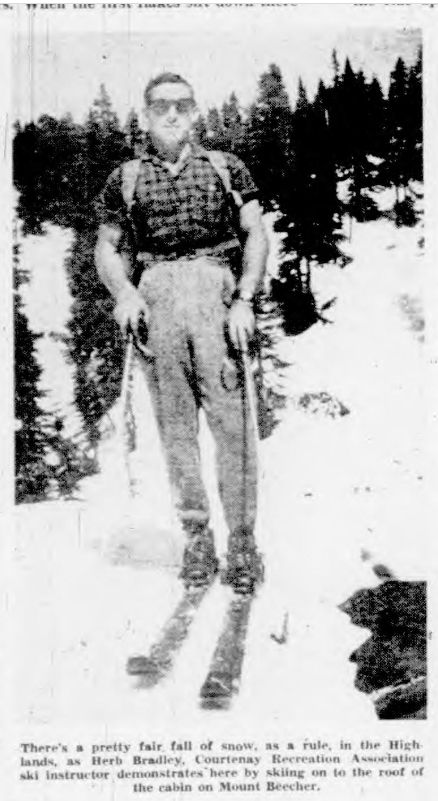
There’s a pretty fair fall of snow, as a rule, in the Highlands, as Herb Bradley, Courtenay Recreation Association ski instructor demonstrates here by skiing on to the roof of the cabin on Mount Beecher.
Mount Everest Lecture
Reported in The Daily Colonist Wednesday February 24, 1954. p.22.
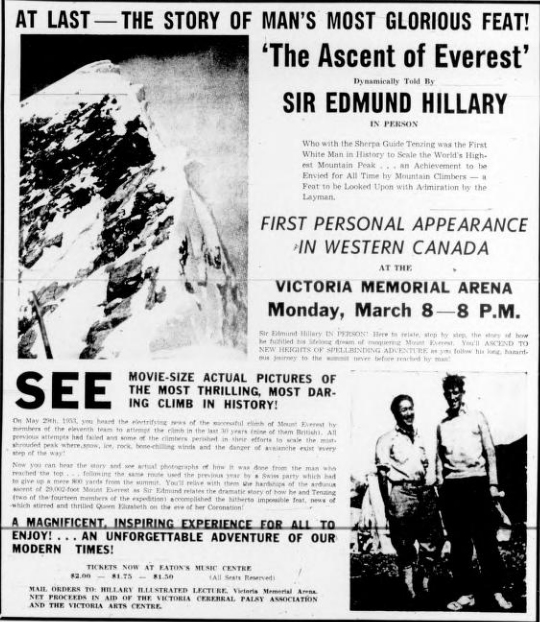
Ad for the Sir Edmund Hillary talk, Monday, March 8, 1954.
Mount Everest Lecture
Reported in The Daily Colonist Sunday February 28, 1954. p.23.
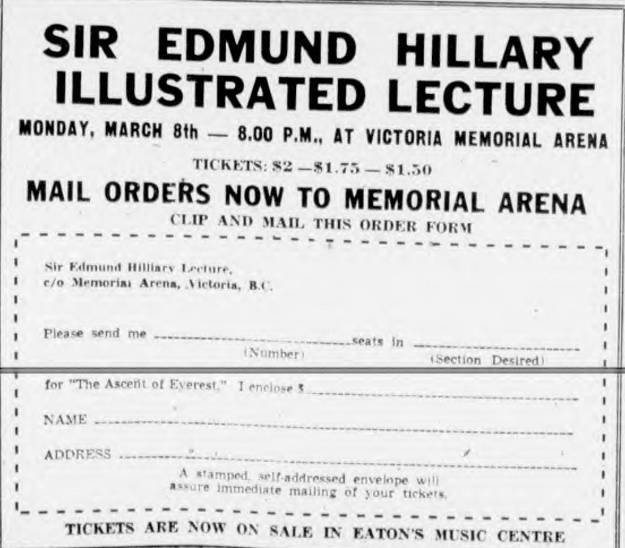
Order form for tickets to the Sir Edmund Hillary talk, Monday, March 8, 1954.
Local Skiers Win Trophy at Mt. Brenton
Reported in The Victoria Daily Times Wednesday March 3, 1954. p.9.
The Victoria Sno Birds Ski Club came home with the Mt. Brenton trophy for the best team in the Inter-club Downhill Race last Sunday at Forbidden Plateau. Best time for the race was made by Frank Jensen of the Sno Birds. Second was taken by Don Vogel of Nanaimo and Toni Lamprecht of the local skiers ran third. Sno-Birds speedy girl skier Herta Von Barloewen took the women’s honors. Team standing as follows:
Victoria Sno Birds Ski Club 1st team 29:21
Comox District Mountaineering Club 33:12
Nanaimo Ski Club 35:15
RCAF 41:28
Fanny Dunkers Ski Club 41:50
Victoria Sno Birds Ski Club 2nd team 43:20
Climbers All!
Reported in The Victoria Daily Times Saturday March 6, 1954. p.17.
Feminine members of the Alpine Club of Victoria and the Outdoor Club of Victoria are just as excited as their menfolk about the visit of Sir Edmund Hillary and his lecture, with pictures, on the conquest of Mount Everest, to be given in the Memorial Arena, Monday evening. A few of the feminine climbers who will be in the Arena on Monday evening are presented here.
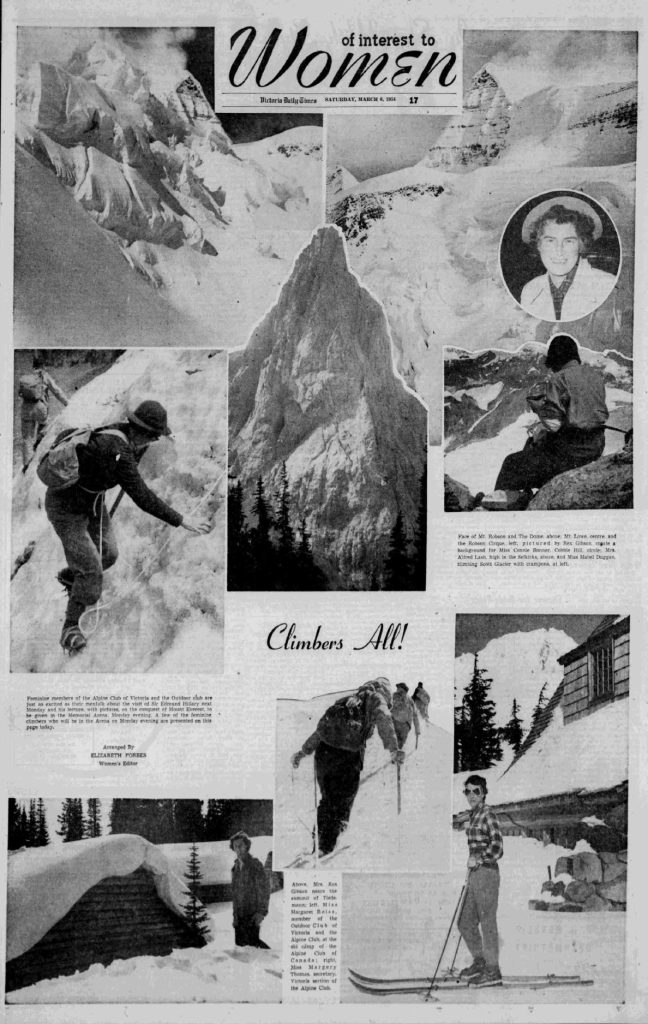
Climbers all!
Mount Everest Lecture
Reported in The Daily Colonist Sunday March 7, 1954. p.22.

Ad for the Sir Edmund Hillary talk, Monday, March 8, 1954.
The Ascent of Everest
Supplement in The Victoria Daily Times Monday March 8, 1954.
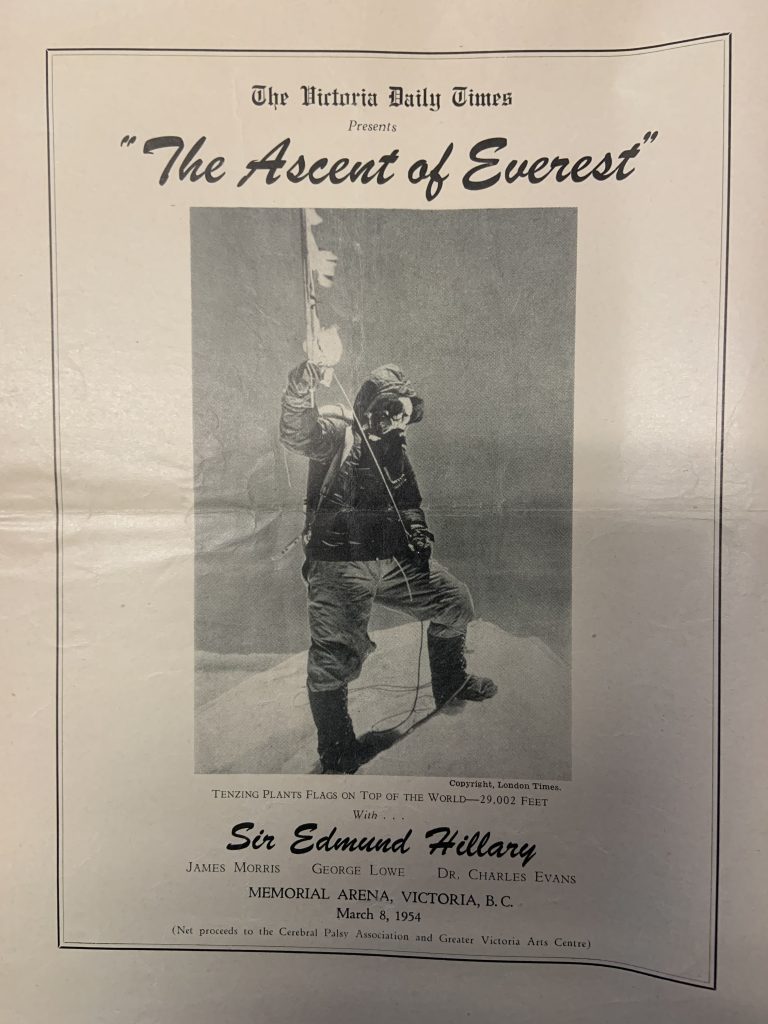
Program cover for “The Ascent of Everest.”
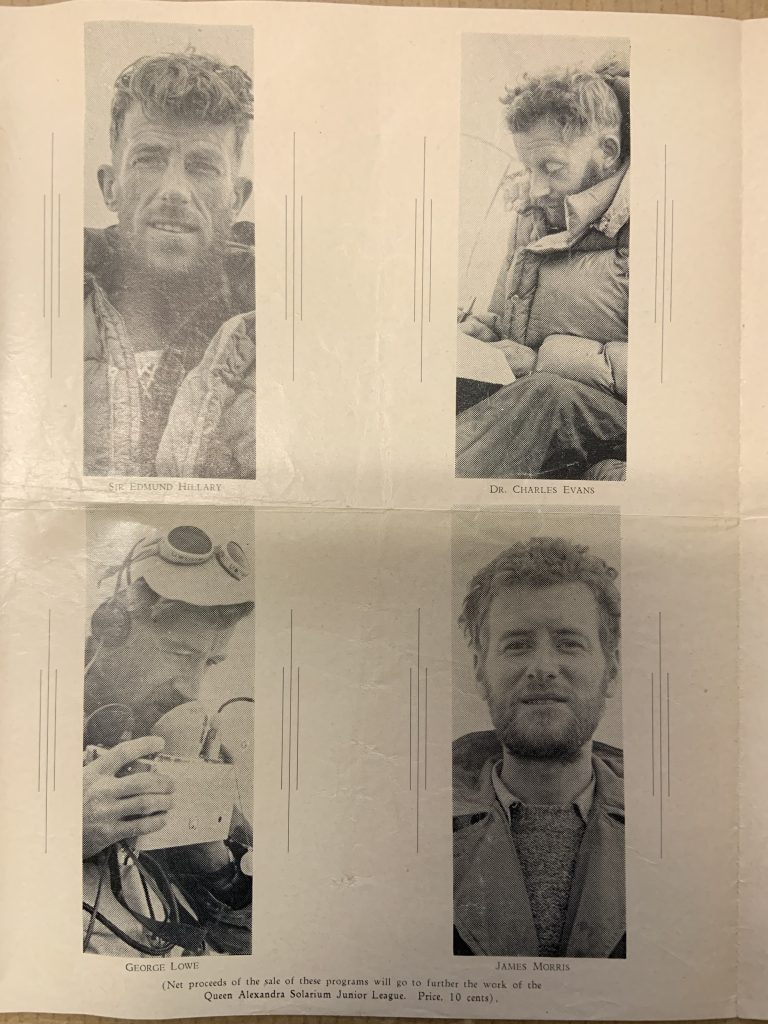
Program page 2, with portraits of Sir Edmund Hillary, Dr. Charles Evans, George Lowe and James Morris.
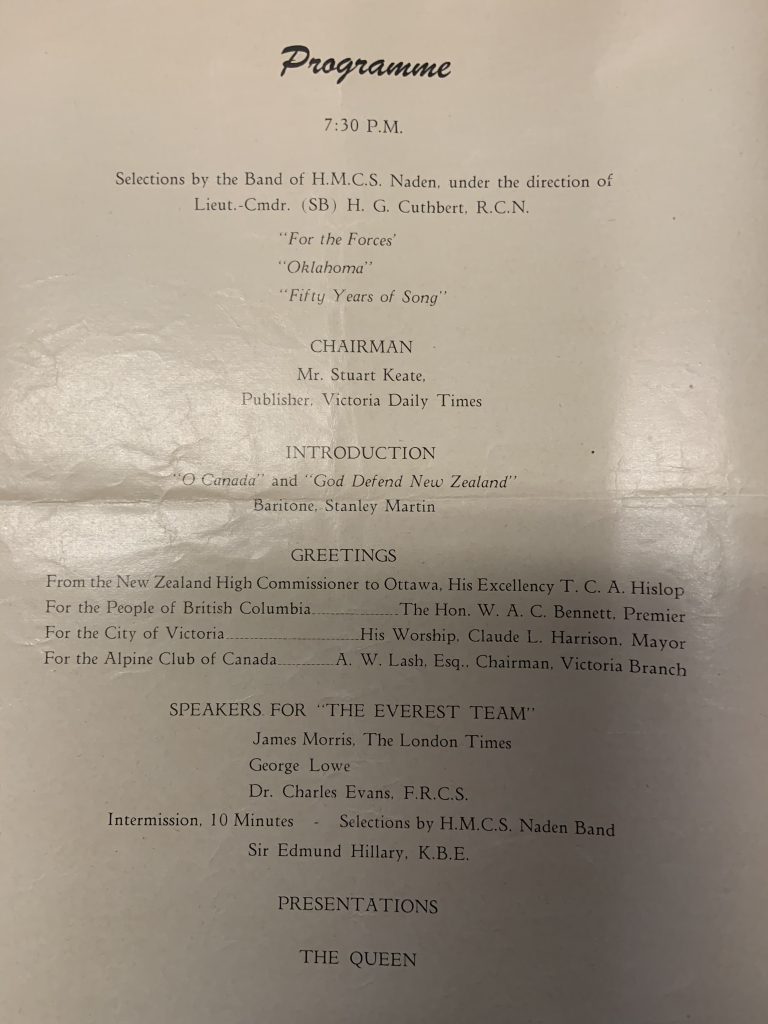
The Program for “The Ascent of Everest” talk by Sir Edmund Hillary.
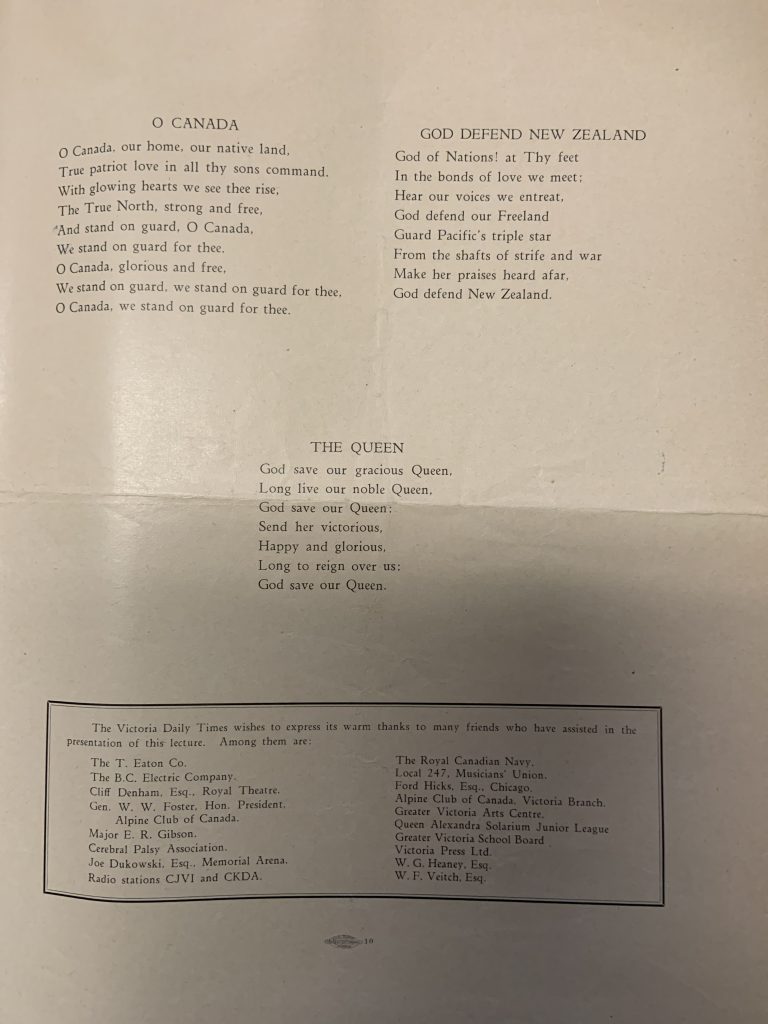
“The Ascent of Everest” program.
Hillary Party Receives Warm Welcome to Victoria
Reported in The Victoria Daily Times Monday March 8, 1954. p.13.
Sir Edmund Hillary, conqueror of the world’s highest peak, and three Everest companions, were given an informal welcome on arrival at Patricia Bay Sunday for a Times-sponsored public lecture at Memorial Arena tonight at 8.
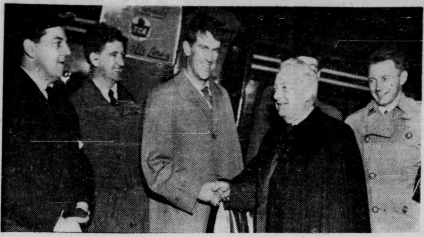
L to R, Stuart Keate, Times publisher; George Lowe, Sir Edmund Hillary, Mayor Claude Harrison and Charles Evans.
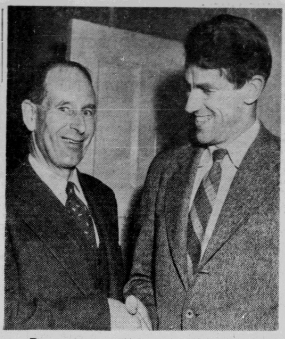
Bill Lash, chairman of the Victoria section of the Alpine Club of Canada with Sir Edmund Hillary.
Famed Island Indian Sweater Due for Jaunt to Himalayas
Gift Made to Everest Conqueror
Reported in The Daily Colonist Tuesday March 9, 1954. p.1 &13.
In a few weeks’ time Sherpa tribesmen in the Himalayas will be gazing at Indian sweaters made at Cowichan. Mount Everest conqueror Sir Edmund Hillary and other members of last year’s successful party were presented with the sweaters after they addressed a spell-bound audience at Memorial Arena last night. Sir Edmund took time off from a “pretty grueling” lecture tour yesterday afternoon to go salmon fishing with two other members of the expedition – George Lowe and Dr. Charles Evans. Once again it was Hillary who was successful. He caught the only fish—a 10-inch grilse. Sir Edmund will arrive back in New Zealand next Monday, and a week or so later will make yet another trip into the mighty mountains of Nepal. “I’ve only spent three and a half weeks in New Zealand since early last year,” said the tall lanky New Zealand bee-keeper. “I won’t even see the All Blacks.” Accompanying the party was James Morris, reporter for the London Times, who sent back exclusive coverage of the successful ascent. He himself climbed to 22,000 feet on Everest. James Morris, George Lowe and Dr. Charles Evens each spoke of the events leading up to the final dash to the summit by Hillary and Tenzing. And then Sir Edmund took over and gave a step-by-step account of the slow progress made by Tiger Tenzing and himself up the last few hundred feet. The audience applauded frequently as all the speakers graphically—and often humorously—described the feat. They emphasized the fact that it was a team effort which enable the climbers to get to the top. “The spirit of friendliness and comradeship was one of the major reasons for our success,” said Sir Edmund. He also dwelt on one of the unpublished aspects of the climb—the journey down the mountain. With oxygen running low and both men extremely tired, Sir Edmund described in detail the perilous descent. “One of the greatest thrills the expedition experienced was hearing a BBC broadcast announcing the conquest of the mountain. Until we had official confirmation from London, we hardly dared believe it,” said Sir Edmund. Special guests at last night’s function were Premier W.A.C. Bennett, New Zealand High Commissioner Thomas Hislop and Mayor Claude Harrison. “Any use in asking who got to the top first?” a reporter asked Sir Edmund. “No.” he said.
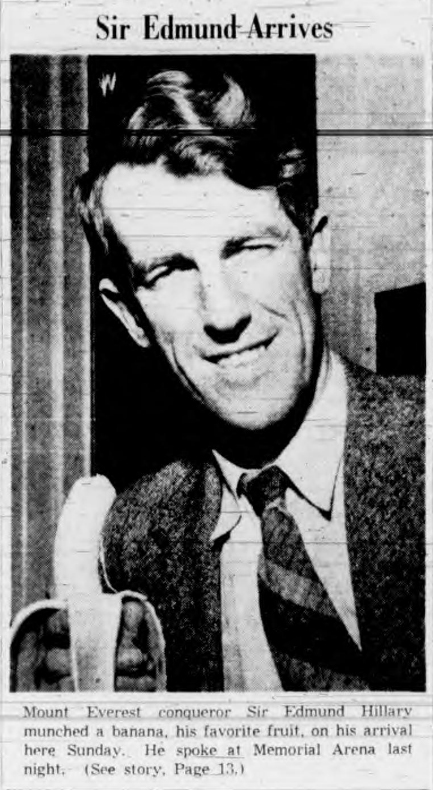
Mount Everest conqueror Sir Edmund Hillary munched a banana, his favorite fruit, on his arrival here Sunday. He spoke at Memorial Arena last night, (See story, Page 13,)
Mount Everest Film
Reported in The Daily Colonist Tuesday March 16, 1954. p.26.
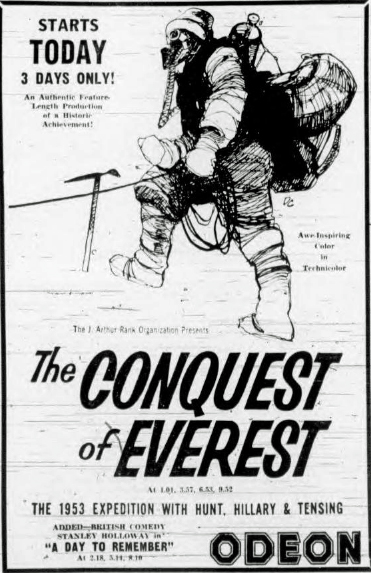
Ad for “The Conquest of Everest, the 1953 expedition with Hunt, Hillary & Tensing.”
Snow Birds at Home This Week
Reported in The Victoria Daily Times Thursday March 18, 1954. p.9.
This Sunday the Victoria Sno Birds Ski Club will play host to Nanaimo Ski Club and Comox District Mountaineering Club at an Inter-club ski meet on Mt. Brenton. The downhill and slalom courses on Brenton have never been raced competitively before and should provide some thrills for the spectators as well as the racers. Prizes will be offered in the men’s and women’s novice classes. Last Week-end Toni Lamprecht placed second to Herb Bradley in the Kandahar race at Forbidden Plateau, losing out by six seconds.
Local Planksters Capture Titles at Mt. Brenton
Reported in The Victoria Daily Times Tuesday March 23, 1954. p.9.
Two members of the Victoria Sno Birds Ski Club won championships in an Inter-club meet at Mount Brenton Sunday. Toni Lamprecht captured the men’s slalom and George O’Deir took the novice downhill event. Courtenay’s Herb Brdley placed second to Lamprecht in the slalom and won the downhill event. Lamprecht taking runner-up honors. The women’s downhill was won by Courtenay’s Sonia Lehit.
Alpine Club Hears of K2 Expedition
Reported in The Daily Colonist Tuesday April 13, 1954. p.31.
The 1953 American expedition to climb Mount Godwin-Austen in Pakistan was the subject of a talk by Seattle expedition member Peter Schoening to the Victoria section of the Alpine Club of Canada Saturday night at the Pacific Club at 7:30 p.m. Mr. Schoening showed a series of colored slides of the route taken by the expedition through Pakistan to get to the mountain known as K2. He told listeners that contrary to popular belief, K2 is more than 750 miles northwest of Mount Everest, and is not part of the Himalaya range. K2 is only 782 feet lower than Mount Everest (29,002 feet). It has yet to be climbed. The 1953 American expedition got to the 26,000-foot level before turning back, and nearly met with disaster on the way down. Forced to retreat before 100-mile-an-hour winds, one of the party slipped on the ice on a treacherous slope, and Mr. Schoening was responsible for saving all their lives. Many of the pictures were taken in villages of Pakistan on the way to the mountain.
Climbing Shown
Reported in The Daily Colonist Friday June 4, 1954. p.6.
COBBLE HILL—Color pictures of mountain-climbing trips in various parts of British Columbia were shown at the Shawnigan-Cobble Hill Farmers Institute by Miss Connie M. Bonner. Miss Bonner, a member of the Alpine Club of Canada, has taken part in some of the most spectacular trips taken by members of the club, and has taken pictures to show the many hazards encountered.
Rosseau’s Mountain Lore Guided Lost Times Newsman to Safety
Reported in The Victoria Daily Times Monday July 5, 1954. p.1.
By Humphry Davy
Ralph Rosseau was a man who loved mountains. His life was taken by one of the unpredictable and ruthless forces which stalk the lonely, snow-covered peaks of Vancouver Island. I first met Rosseau two summers ago while climbing Mount Arrowsmith with David Stock, Times reporter; Graham Harris, now of Vancouver, and Ulf Bitterlich of Alberni, who was a member of Saturday’s ill-fated expedition. He was building a cabin hewn from trees from the mountain slope. The cabin was situated not far from the timberline and overlooked the Alberni Valley. Rosseau deeply impressed me. Somehow, he seemed to fit into the landscape. He was part of it. As an alpinist, he ranked among the best in Canada. We watched him climb along a narrow ledge on the side of a 2,000-foot precipice. The ledge was not more than four inches wide. Yet he walked along it with a sureness of a mountain goat. He climbed swiftly, with determination and without fear. Rosseau did not climb for self-exultation and he did not belong to the cult of danger. Rosseau, though a school teacher, disliked the “passive man.” He believed it was the duty of men to create, to be active in the field he was best suited for. His field was mountain climbing and he developed it into an art. On the day we climbed Mount Arrowsmith, David Stock lost his way while returning to Rosseau’s cabin. The newspaperman followed a wrong trail, descended a precipice and was stopped from proceeding by a marsh. His friends wanted to organize a search party immediately, but Rosseau suggested waiting a while. “Mount Arrowsmith is a big mountain,” he said, “and it isn’t everyone who can conduct a search safely on a mountain.” Rosseau said he would chop wood at his cabin to attract Stock’s attention. The sound of chopping wood, he explained, can be heard for miles on a mountain, and if Stock was safe, he would follow the sound to the cabin. So, for three hours the school teacher chopped. The newspaperman heard the sound and was able to find his way back to the cabin. We left Rosseau that night on Mount Arrowsmith, his favorite mountain and his second home. I remember him saying as we left: “I love this mountain and it will take me a lifetime to know it all. But if I do, I will know myself.”
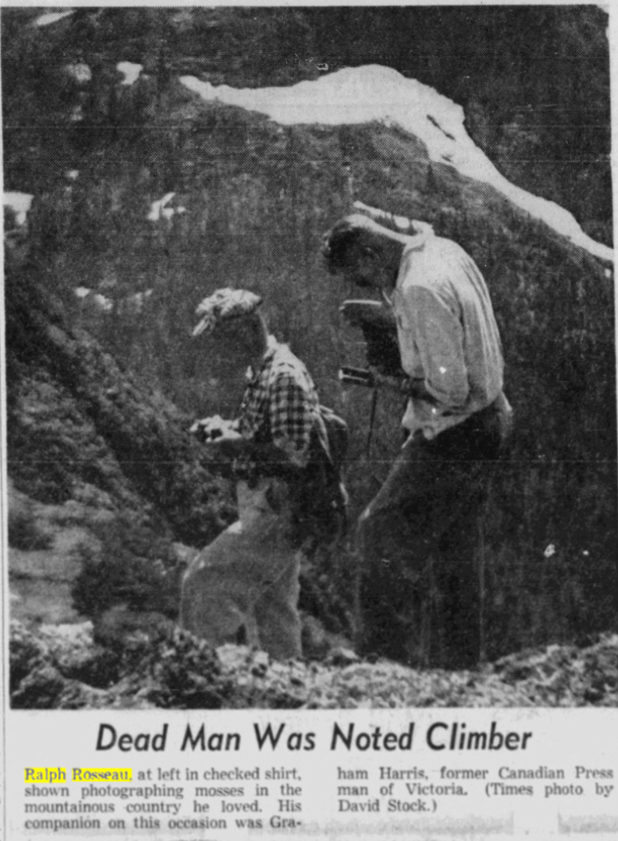
Dead Man Was Noted Climber
Ralph Rosseau, at left in checked shirt, shown photographing mosses in the mountainous country he loved. His companion on this occasion was Graham Harris, former Canadian Press man of Victoria. (Times photo by David Stock.)
Disaster Overtakes Island Climber
Alberni Schoolmaster Killed on Ice-Ridge: Helicopter Airlifts Women from Mountain
Reported in The Victoria Daily Times Monday July 5, 1954. p.1.
By Dave Stock
Ralph H. Rosseau, 46, principal of Gill Elementary School at Alberni, fell to his death Saturday when an ice ridge he was climbing in the hinterlands of Vancouver Island suddenly crumbled. He died instantly. A helicopter from Vancouver was bringing the body out of the rough, mountainous area today. Rosseau, a skilled and experienced climber, was on the return leg of a trip into Margaret Lake, a small body of water about halfway between the northern tip of Great Central Lake and the southern end of Buttle Lake. He was accompanied by three others, his wife Lillah, Miss Alma Currie and Ulf Bitterlich. Miss Currie was injured in the ice fall. Mrs. Rosseau was thrown clear. Bitterlich, who was leading, was on safe ground when the break occurred. The two women were flown out by helicopter Sunday evening. Miss Currie was being treated for possible cracked ribs and bruises. Mrs. Rosseau was treated for shock but allowed to go home. “I don’t actually know what happened,” she told the Times today. “We had been to the lake. We had got in the day before (Friday) and we camped there that night.”
Wife’s Eyewitness Account
The party planned on returning by way of Drinkwater Valley. Drinkwater Creek flows through this valley, joining Della Lake with Great Central Lake. To reach the valley, the Rosseau party had to cross Septimus Ridge. It was here the disaster befell. The party had just resumed its hike, after stopping for lunch. “We were just going to cross the ridge to the Della Lake side,” Mrs. Rosseau recounted. “We picked what looked like the best route up. It was a place filled with snow. As we worked our way up, a big block of ice gave way with three of us on it. It slid 25 or 30 feet and just rolled over. I was catapulted onto the ice that was left.” Mrs. Rosseau and Miss Currie were carried down with it and landed in a deep crevasse. Bitterlich, using a rope, lowered himself into the hole. He found Rosseau dead, apparently from a broken neck, and Miss Currie beside him.
Hikes 10 Miles to Get Aid
“Ulf wouldn’t let me go down,” Mrs. Rosseau said. “I looked over the edge but I couldn’t see the others. Ulf said to keep perfectly still because he was afraid other ice might give way.” Having rescued Miss Currie, Bitterlich found a safer place on the mountain ridge where the three spent the night. At daybreak he set off alone to bring help. After hiking 10 miles, he encountered another mountaineer. This man, not identified, carried the message for help to the RCMP while Bitterlich returned to the women. An aircraft spotted the trio Sunday morning and a helicopter of the Okanagan Air Services from the mainland took out the two women Sunday evening. Bitterlich and a policeman remained in the area Sunday night in order to guide those flying in today to the body. Mrs. Rosseau, heart-broken by the tragedy, found some comfort in knowing: “That’s the way he would have wanted it. He loved the mountains so. It had been a happy day, and Ralph was so pleased,” she said. Rosseau had planned on another climbing expedition next week-end to Elkhorn Mountain, a 7,200 peak in Strathcona Park.
Survivor Tells of Fall into Crevasse
‘There Was a Harsh Crack – Then Ice and Snow Tumbled Around Us’
Reported in The Vancouver Sun Monday July 5, 1954. p.1.
“We had no warning. Suddenly there was a harsh crack and we were thrown down into a deep ice crevasse with ice and snow tumbling around us.” Still bone-weary from 30 hours awaiting rescue on a windswept peak of the Septimus Range in the rugged heart of Vancouver Island. Miss Alma Currie told of Saturday’s mountaineering tragedy which claimed the life of fellow alpinist Ralph Rosseau and the ordeal before she and the dead man’s wife were airlifted out Sunday just at dusk.
Saw Ralph’s Head
“The four of us were crossing the small valley when there was a sudden crack,” she recalled. “Ralph Rosseau, his wife Lillah and I were hurled to the bottom and I remember a large slab of ice resting on top of me. I can remember seeing Ralph’s head sticking out of the snow and ice. But I was dazed and suffering from shock and I can only remember parts of it. Ulf Bitterlich and Lillah told me I climbed out of the crevasse with just a little help, but I can’t remember.” Alpine experts said the four were crossing the valley on snow which had rotted below the crust by spring run-offs. When they hit a weak spot, the crust collapsed.
Knew He Was Dead
The 30-hour ordeal began when Bitterlich, a veteran of expeditions in the Alps and B.C.’s mountains, located a crude camp near the scene of the tragedy and started down from the 4,00-foot level for help. “Ulf knew Ralph was dead as soon as he examined him,” Miss Currie related, “but he didn’t tell us until 11 that night when he returned. He just told us Ralph was unconscious and that we were not to go back to him because we could do nothing for him and besides it was too dangerous. We didn’t do much sleeping Saturday night and at first light we began to look for a plane. They would know just where to find us as Ulf had given the man he met a map with our position marked on it. At noon, a light plane came over and Ulf and Mrs. Rosseau ran out on the white snowfield waving red shirts. The plane spotted us and came over low to drop a message tied to a life jacket. The message said that a ground search party was on the way. At dusk, the helicopter came over and landed near us. It took me out first and landed me at the top of Great central lake. It went back for Mrs. Rosseau and we were then picked up by a float plane and were taken to Port Alberni.”
B.C. Climber Killed by Fall into Gully
Snow Bridge Gave Way
Reported in The Vancouver Province Monday July 5, 1954. p.1 & 2.
PORT ALBERNI—Ralph Rosseau, 46-year-old school principal, was killed instantly Saturday [July 4] when a snow bridge gave way as he was climbing a mountain near-here, catapulting him 30 feet down into a rock gully. A helicopter was trying to bring his body out today. Miss Alma Currie, a member of the party, also fell into the gully, and was slightly injured. Here is her story. I was lucky. I fell 30 feet into the same rock gully at exactly the same spot where Mr. Rosseau was killed. But I only cracked a rib and damaged my elbow. This picture of what happened is mainly drawn from what I was told later by Mrs. Lillah Rosseau, who was thrown clear when the snow gave way and Ulf Bitterlich, of Cameron Lake, who had been leading and missed the crack.
Wide Gully
We were climbing up a wide snow gully, plugged with snow, leading up to Mt. Septimus, 4,500 feet. On the other side the four of us were to meet a party of seven who had gone around a trail to the other side. We were going off the snow to the rocks when the accident happened. Ralph and Ulf have had a lot of mountaineering experience. They took all the usual precautions. But suddenly the whole edge of the snow bridge broke off behind us. Ralph hurtled down into the hole, onto the rocks below. I think a rock crushed him, and he died instantly
Leg Hurt
I stayed conscious for about two minutes after Ulf climbed down to us. My legs were hurt, but when he saw I wasn’t in bad shape, he started to dig out Ralph. But he was dead. Mrs. Rosseau was hurled over backwards as the snow-crust split wide open. Some of the snow and ice blocks crushed her legs, bruising them badly, but she was able to walk. Ulf told me afterwards I climbed out under my own power and made my way to where Mrs. Rosseau had a fire going. We were not roped, but were taking every precaution. The accident happened about 2 p.m. Saturday, eight hours above our base camp, which was 2½ hours from Great Central Lake. About 4 p.m. Ulf left us and made for the lake to get help. We had no food or equipment. About 11 p.m. he came back, a wonderful feat, with some chocolate and raisins, and a sleeping bag for me.
Took Us Out
He had marked the accident scene on the map, and on Sunday a plane came in and circled overhead. Just before dark a helicopter of Okanagan Airways managed to land on the snow in the gully and took Mrs. Rosseau and me out. Ulf stayed there with RCMP Constable Jim Hodgkins and forestry worker William Reith. They were hoping to come out with the body today. Mr. Rosseau, principal of Gill Elementary School, where I also teach, had climbed extensively in the Rockies. Ulf has done a lot in the Alps. They did everything possible. This was one of those things.
Rescue Helicopter Brings Out Body of Mountaineer
Reported in The Daily Colonist Tuesday July 6, 1954. p.3.
PORT ALBERNI—An air-sea rescue helicopter last night flew out the body of Ralph Rosseau, 47-year-old school teacher killed by a snowslide Saturday near remote Margaret Lake. Story of the tragedy was told Monday by twenty-one-year-old Alma Joan Currie, who suffered a cracked rib, arm injuries, cuts and shock when she was swept away into a crevasse with Rosseau, the district’s most experienced mountaineer. She told how Rosseau’s widow stayed alone with her as she lay helpless after the accident, gathered fuel and kept a fire going for seven hours while Ulf Bitterlich, the fourth member of the party, hiked through the rugged country to get help. The party had left Margaret Lake to climb Mount Septimus with the intention of meeting a seven-man party in the Della Lake area. Miss Currie was knocked unconscious in the slide and cannot recall being assisted back to the ledge on which Mrs. Rosseau and Bitterlich were standing when she and Rosseau plunged into the gorge. She recalled coming to momentarily and seeing Rosseau’s head protruding from the snow where Bitterlich had been digging with his hands. Bitterlich helped Mrs. Rosseau gather fuel and light a fire before leaving on his grueling hike, and told her to keep the blaze alight. According to Miss Currie, the return journey made by Bitterlich, also an experienced mountaineer, would ordinarily have taken eleven hours. He made it in seven, climbing in darkness during the last hours. With him he brought a sleeping bag and a small quantity of food, obtained when he met some members of the other party. Not having his knowledge of the terrain, they were unable to accompany him back in the dark. When he returned, he broke the news to Mrs. Rosseau that he had found her husband dead when he went down into the crevasse to bring Miss Currie out. Before leaving he merely told her that Rosseau was unconscious and had warned them not to leave the fire. The three remaining members of the party kept vigil through the night and at about 11:45 a.m. Sunday, a search plane sighted their signals. A message was dropped to tell them help was coming. The helicopter took Miss Currie out to the head of Great Central Lake, returning for Mrs. Rosseau. A PWA [Pacific Western Airlines] plane brought the two women to Sproat Lake, where they were met by Mrs. Rosseau’s father, R.G. Smith, and brought by car to Port Alberni. Miss Currie was treated in the emergency ward at West Coast General Hospital. Rosseau, 47, has taught school in the district for the past fourteen years, and in latter years has been principal of Gill Elementary School. He was born in Vancouver. Besides his wife Lillah, he is survived by relatives in Victoria and two married sisters in the Alberni’s. Mrs. Rosseau is vice-principal of Eight Avenue Elementary School and had joined her husband on many of his mountaineering expeditions. Ulf Bitterlich, who lives at Cameron Lake, is also an experienced mountaineer, and Miss Currie had been on many climbing trips. She is a teacher at Gill School. Miss Currie emphasized that the accident would not have been foreseen. As she and Rosseau stood on the ledge, a crack suddenly appeared in the ice and before they could move they were swept into the canyon. She praised the spirit shown by Mrs. Rosseau during the long hours of waiting and was full of praise for Bitterlich.
Alpinist’s Body Taken from Crevasse
Reported in The Vancouver Sun Tuesday July 6, 1954. p.2.
PORT ALBERNI—The body of Ralph Rosseau was brought out Monday night, 48 hours after he was killed when an ice bridge broke away during a weekend mountain climbing trip. Sunday a helicopter brought out Rosseau’s wife Lillah and Miss Alma Currie, who was slightly injured in the mishap, and Ulf Bitterlich. The helicopter brought out the body late Monday. The story of their ordeal was told Monday by Mrs. Rosseau and Miss Currie, a 21-year-old school teacher. “I don’t really know what happened,” Mrs. Rosseau said. “We were just going to cross the ridge … We picked what looked like the best route up. It was a place filled with snow. As we worked our way up, a big block of ice gave way with the three of us on it. It slid 250-300 feet and just rolled over.” The two women and Rosseau were catapulted down into a crevasse. Bitterlich lowered himself on a rope and brought out the two women. He left them for seven hours while he rushed across rugged country for help. It generally takes 11 hours to cross the same country. He did not tell Mrs. Rosseau her husband was dead until he returned.
Alpinist’s Body Flown Out
Died In Slide
Reported in The Vancouver Province Tuesday July 6, 1954. p.2.
PORT ALBERNI—Body of mountaineer Ralph Rosseau was flown from the 4,000-foot level of a Great Central Lake mountain Monday, 50 hours after a rotten snow-bridge threw him 30 feet to his death. Mr. Rosseau, 46-year-old principal of Gill Elementary School, was one of the party of four climbing Mt. Septimus on Saturday. The edge of the snow-bridge collapsed, throwing him and Miss Alma Currie into a rock gully. Other member of the party, which included Mr. Rosseau’s wife, were unhurt. Mr. Rosseau has been in this district since 1942.
Mountaineer’s Body Flown to Port Alberni
RCMP Planning Early Inquest
Reported in The Victoria Daily Times Tuesday July 6, 1954. p.8.
PORT ALBERNI—Arrangements for an inquest into the death of Alberni school principal Ralph Rosseau were being made here today by RCMP officers. Rosseau’s body was recovered Monday from the wilderness area around Mount Septimus, where he died Saturday in an ice slide. Remains were flown out by helicopter and brought to Steven’s Funeral Home here. Date for the inquest was expected to be announced later today by Dr. N.H. Jones, coroner. In the meantime, 21-year-old Alma Currie, who was injured in the ice fall, is recovering. She sustained a cracked rib, arm injuries, cuts, bruises and shock.
Two Injured
Mrs. Rosseau and Ulf Bitterlich, members of the week-end climbing expedition, were not injured in the ice fall, though Mrs. Rosseau is suffering from shock.
Mountain Death Scene
Reported in The Vancouver Province Wednesday July 7, 1954. p.3.
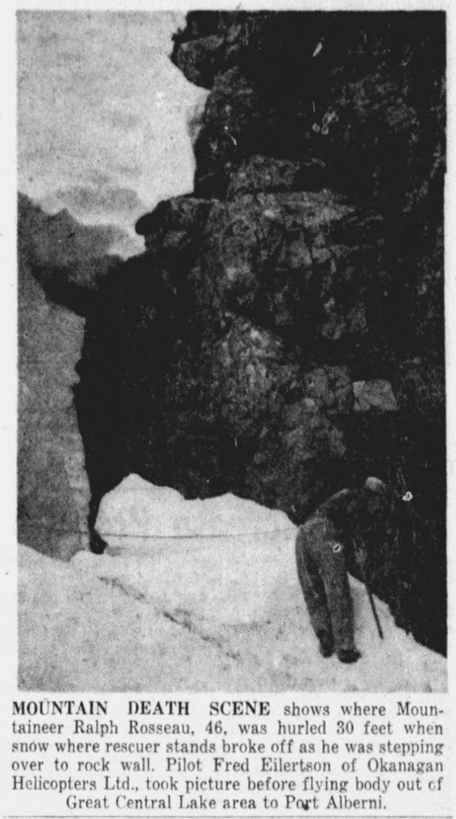
MOUNTAIN DEATH SCENE shows where Mountaineer Ralph Rosseau, 46, was hurled 30 feet when snow where rescuer stands broke off as he was stepping over to rock wall. Pilot Fred Eilertson of Okanagan Helicopters Ltd., took picture before flying body out of Great Central Lake area to Port Alberni.
Well-Known Teacher Dies in Mountain Tragedy
Reported in the Twin City Times Wednesday July 7, 1954. p.1.
Over 48 hours after the mountain tragedy which took the life of Ralph Rosseau, Gill Elementary School principal, an air-rescue unit under RCMP direction succeeded Monday afternoon in bringing out the body. The helicopter which had brought in an injured woman survivor of the tragedy and had returned twice Sunday evening to the remote mountain slopes some 20 miles from Port Alberni to bring out Mrs. Rosseau and a male member of the party left at 1 p.m. Monday in an attempt to land again near the scene of the accident where an RCMP constable and a B.C. Forestry warden had kept vigil during the second night. Weather conditions earlier in the day had delayed the trip. Story of the death of Rosseau was told Monday morning by 21-year-old school teacher Alma Currie, who was injured when she was swept into a crevasse with the district’s most experienced mountaineer when a huge block of ice broke away from the side of the mountain. She told how Ralph Rosseau’s widow stayed alone with her as she lay helpless after the accident, gathered fuel and kept a fire going for seven hours while Ulf Bitterlich, the fourth member of the party, hiked through the rugged country to a phone to give the call for help. The party had left Margaret Lake to climb over Mount Septimus with the intention of meeting a seven-man party in the Della Lake area. Miss Currie was knocked unconscious in the slide and can not recall being assisted back to the ledge on which Mrs. Rosseau and Bitterlich were all standing when she and Mr. Rosseau plunged into the gorge. She can recall coming too momentarily and seeing Mr. Rosseau’s head showing where Bitterlich had been digging in the snow with his hands to uncover his companion. Bitterlich helped Mrs. Rosseau to gather fuel and light a fire before leaving on his grueling hike then told her to keep the blaze alight. Mrs. Rosseau gathered fuel on the sparsely wooded slope for three hours then fed the fire during the long wait for Bitterlich’s return. According to Miss Currie, the journey made by Bitterlich, also an experienced mountaineer, would ordinarily have taken 11 hours. He made it in seven, climbing in darkness during the last hours. With him he brought a sleeping bag and a small quantity of food obtained when he met some of the members of the other party. Not having his knowledge of the terrain, they were unable to accompany him back to the scene of the accident on his night-time hike. When he returned he broke the news to Mrs. Rosseau that he had found her husband dead when he had gone down into the crevasse to bring Miss Currie out. Before leaving he had merely told the woman that Rosseau was unconscious and had warned them not to leave the fire. The three members of the party kept vigil through the night and at approximately 11:45 Sunday a search party in a PWA [Pacific Western Airlines] plane sighted their signal. A message attached to a life belt was dropped to tell the waiting group that help was coming. The helicopter took Miss Currie, suffering from a cracked rib, cuts, shock and an injured arm, out to the head of Great Central Lake, returning to bring Mrs. Rosseau out. A PWA [Pacific Western Airlines] plane, piloted by Gordon Moul brought the two women to Sproat Lake where they were met by Mrs. Rosseau’s father, K.R. Smith, and brought by car to Port Alberni. Miss Currie was treated in the emergency ward at West Coast General Hospital. Mr. Rosseau, 47, had taught school in the district for the past 12 years, coming here from Bamfield. Since 1951 he had been principal of Gill School. He was born in Vancouver. Mrs. Rosseau is vice-principal of Eight Avenue Elementary School, a position held by her husband before he went to Gill. She is also a keen mountaineer having joined Mr. Rosseau on many of his expeditions. During his years here he had scaled the major peaks in the area and had taken outstanding photographs of remote mountain scenes. Bitterlich, who lives at Cameron Lake, is also an experienced mountain climber while Miss Currie has been on many trips with local alpinists. She is a member of Gill teaching staff. Miss Currie emphasized that the accident was of a type which could not have been foreseen. As she and Mr. Rosseau stood on the ledge, a crack suddenly appeared in the ice and before they could move they were swept into the canyon. She expressed praise for the fortitude shown by Mrs. Rosseau during the long wait for aid and she also praised the manner in which Mr. Bitterlich took charge of the situation.
Service Today for Victim of Tragic Accident
Reported in the Twin City Times Wednesday July 7, 1954. p.1.
Funeral services will be held in Somass Legion Hall, Alberni, this afternoon at 2:30 o’clock for Ralph Rosseau, who died Saturday in a mountain accident. Reverend Glen Stevenson will conduct the services which will be followed by cremation in Victoria. Mr. Rosseau is survived by his wife Lillah, his parents, Mr. and Mrs. K.R. Rosseau, Victoria; a brother Earle, at Savona, B.C. and two sisters, Mrs. Louise (John) Eck and Mrs. Joe Lynn, Alberni.
Hundreds Attend Funeral of Alpinist Ralph Rosseau
Popular School Principal Killed When Snow Bridge Near Mt. Septimus Collapses; Mrs. Rosseau Has Miraculous Escape
Reported in the West Coast Advocate Thursday July 8, 1954. p.1 & 5.
Hundreds of valley residents, friends and admirers of elementary school principal and noted mountaineer Ralph Rosseau, were present at his funeral Wednesday afternoon in the Somass Legion Hall in Alberni. Mr. Rosseau was killed Saturday in a mountain-climbing accident that also injured school teacher Alma Currie and all but claimed Mrs. Rosseau as a third victim. Ulf Bitterlich of Cameron Lake, a fourth member of the little party which branched off for a side trip around the rear of Mount Septimus to Margaret Lake, some 15 miles from the head of Great central Lake, was the only one not directly involved in the mishap. Funeral services were conducted by Reverend Glen Stevenson at 2:30 p.m. and the body was forwarded to Victoria for cremation. Mr. Rosseau’s ashes will be scattered over Mount Arrowsmith, in the rugged country near his permanent camp on the slopes of the mountain he loved so well. The full story of the Saturday afternoon tragedy, her own miraculous escape from probable death and of Bitterlich’s literally amazing feat of endurance in covering some 20 air miles of the most rugged country on Vancouver Island in less than eight hours to summon help, was told to The Advocate by Mrs. Rosseau on Tuesday afternoon.
Left Main Party
“We left out camp at the head of Great Central Lake early Saturday morning,” Mrs. Rosseau said. “The main party was going to Della Falls, but about four miles up the trail Mr. Rosseau, Ulf, Miss Currie and myself branched off to go around the back of Mount Septimus to Margaret Lake and join them again later.” The four had reached the Lake at about 1 o’clock, Mrs. Rosseau recalled. Leaving it, they were traversing a broad snow slope, leading up to the snow “bridge” which passed beside a rock wall over which water was falling. “At the edge of the bridge, the three of us waited for Miss Currie who had lagged behind and changed position for the crossing, with Ulf in the lead, followed by myself, Alma and Ralph. Ulf went ahead, testing the bridge with his ice axe. He reached the other side and called to us that it seemed quite solid, so we started across. I had almost reached him when the whole center part broke off, right behind Ulf on one side and behind Ralph on the other.
Narrow Escape
“As Alma and my husband shot through the gap, I started falling too and thought I would follow them. But the piece of ice on which I was standing suddenly broke away from the rest and tossed me, high over their heads, back in the direction we had come. I landed with a thump right on the brink of the chasm and was knocked away from it, flat on my back, by the chunk of ice which had followed me through the air.” Mrs. Rosseau then recounted how Bitterlich had worked his way down to where her husband and Miss Currie lay in the narrow crevice some 30 feet below. From her own side of the vanished bridge, she could neither descend to where they were nor see them. Finally, Bitterlich returned to say he had almost got Miss Currie free but that Mr. Rosseau wouldn’t be coming up. Leaving the two women together with instructions for Mrs. Rosseau to keep a fire going and look after Miss Currie, who was in a state of shock, Bitterlich then left to summon help. Less than eight hours later, after covering between 20 and 30 miles, he returned at about 11 p.m. “We could see his flashlight winking as he came down Septimus,” Mrs. Rosseau said. “He was moving so quickly we thought there were two or three people as the tiny light appeared here and there at such rapid intervals.”
Amazing Feat
Others in the main party later paid high tribute to Bitterlich’s feat. He left the scene of the accident sometime between 3 and 3:45 p.m., traveled the 10 miles to where his party had branched off from the Della Falls trail, where he met Mr. Shelling who was going to Great Central and gave him the message to relay to police; then struck off up the trail to Della Falls where he contacted the main party after another six miles or so of hiking and, because there was no one fast enough to accompany him, started back to the scene alone, after being assured that a party would follow in the morning. On this last leg of his journey, he was traveling unfamiliar country across the front of Septimus and reached the two women at about 11 p.m. after nearly two hours of traversing snowy precipices and gullies in the dark.
Fall into Crevasse
Mr. Rosseau was killed as he dropped some 30 feet into a narrow crevice and was crushed by snow, ice and rocks which rained down on him. Miss Currie, falling behind him, escaped the avalanche and although bruised and shaken up was not seriously injured. W.D. (Bill) Reith of the B.C. Forest Service, who with Constable Jim Hodgson of the Alberni RCMP and the pilot of an Okanagan Airways helicopter chartered in Vancouver made the trip to the scene Sunday afternoon, described the accident in these words: “They were crossing a snow bridge which broke and plunged Mr. Rosseau and Miss Currie into a wedge-shaped crevice. Mrs. Rosseau was thrown backward through the air to safe snow where the piece of ice on which she was standing broke off and sprang back. On the other side of the break, Bitterlich also was on safe snow. He immediately descended into the crevice and brought Miss Currie out. Mr. Rosseau was dead.”
Helicopter Needed
Reith said he had received a call from Alberni RCMP at about midnight Saturday, requesting information as to how to reach the scene. He had hurried down to the police office and assisted in planning a reconnaissance flight into the area. “A Beaver aircraft chartered by the police took us over the scene on Sunday morning,” Reith told the Advocate. “From our observations then, it was decided that a helicopter would be needed in order to reach the party. Constable Hodgson and myself met the ‘copter when it set down on Sproat Lake at about 4:30 Sunday afternoon. We flew first to the head of Great Central Lake, leaving the constable there to establish camp since the helicopter could only carry the pilot and one passenger in the higher altitudes.”
Party Splits Up
“The original hiking party had been made up of 11 persons and had split up when Mr. Rosseau and his party of three decided to make a short side trip to Margaret Lake around the back of Mount Septimus. The accident occurred at about the 3,400-ft. level just a few hundred yards from the lake. As we sighted the party, we circled the spot once and landed. We found Mrs. Rosseau, Miss Currie and Ulf Bitterlich and didn’t waste much time talking as they had spent the night with just a small fire for heat and a little clump of trees for shelter. As we had to be flown out one at a time, the pilot took Miss Currie first, then Mrs. Rosseau, Bitterlich and finally myself. They were flown to Sproat Lake by Beaver from Great Central Lake.” Miss Currie was taken at once to hospital in Port Alberni for a check-up and later released. Mr. Reith reported that Bitterlich spent the night with Constable Hodgson, the pilot and himself at their camp on Great Central Lake and flew in to the scene of the accident to help with taking out Mr. Rosseau’s body on Monday afternoon. Heavy cloud prevented their return to the scene Monday morning, he said, and it was about 2:30 before the first flight could be made. The final trip out left the scene at about 5:30 p.m., Reith estimated.
Popular Sportsman
One of the best known and most popular sportsmen in the district, Mr. Rosseau had many friends throughout B.C. He was also popular with his pupils at Gill School, where he had been principal since its opening in 1950, and had taught many of the valley’s youngsters how to ski. He was a thoroughly experienced mountaineer and with Mrs. Rosseau had many times in the past gone on hikes through the rugged country surrounding this area. Always interested in the affairs of young folk, particularly in matters of sport and outdoor life, the Rosseau’s frequently were hosts to weekend camping and hiking parties at their permanent camp on the slopes of Mount Arrowsmith.
Death of Great Sportsman
Reported in the West Coast Advocate Thursday July 8, 1954. p.2.
The unfortunate and most untimely death of Gill School Principal Ralph H. Rosseau in a slide while hiking last week-end came as a shook to hundreds of persons throughout the Alberni’s. Seldom has any man ever been so popular with the students he has taught. But Ralph Rosseau was more than a fine educator, he was an able friend of youth and an ardent outdoorsman. In his years as a teacher in this area he undertook to organize innumerable outings for his pupils with their well-being as his main interest at all times. Skiing was one of his favorite pastimes and the knowledge and ability he gained in this field he passed along to a large number of his students and other young people interested in participating in the sport. Words will never express the appreciation and gratitude of these young people whom he introduced to the great outdoors; young people who otherwise may never have learned to thrill to the enjoyment of skiing, hiking and mountaineering. One of British Columbia’s better known, more popular and certainly most tireless participant and exponent of outdoor sports, his loss will be greatly felt by all who knew him, across the length and breadth of our province, as well as by those members of the teaching profession who had the honor to know and work with him. While “Ralph” will not again be with us, his unbounding spirit will continue to traverse the mountains and slopes with members of the outdoors fraternity of which he was so highly respected and renown a part. His memory will long exemplify the good citizenship and sportsmanship so desirable to youth.
Atop Un-Climbed Peak
Reported in The Daily Colonist Wednesday July 13, 1954. p.1.
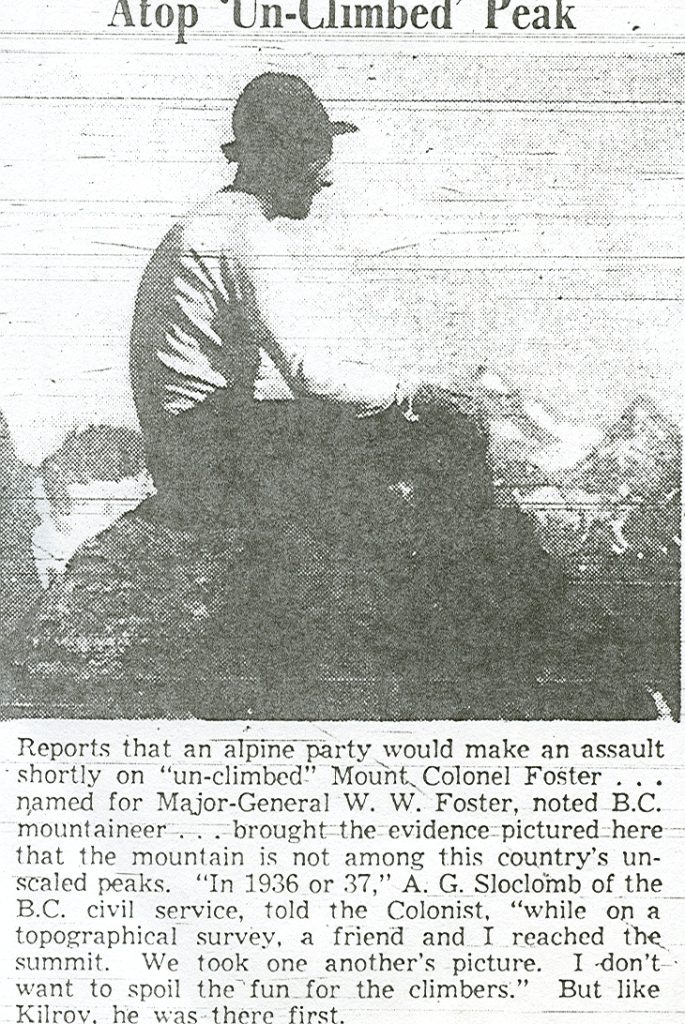
Reports that an alpine party would make an assault shortly on “un-climbed” Mount. Colonel Foster… named for Major-General W. W. Foster, noted B.C. mountaineer… brought the evidence pictured here that the mountain is not among this country’s unscaled peaks. “In 1936 or 37,” A. G. Sloclomb of the B.C. civil service, told the Colonist, “while on a topographical survey, a friend and I reached the summit. We took one another’s picture. I don’t want to spoil the fun for the climbers.” But like Kilrov, he was there first.
ACCVI trip to Elk River 1954
Recorded in the personal diaries of Geoffrey Capes, August 21-28, 1954.
Saturday August 21 – About 10:30 there gather at my store 4 of the Lash family [Bill, Dorothy, Sylvia and Mallory], Syd Watts, Connie Bonner, Ted Grieg, Margery Thomas, Mabel Duggan, Pat Guilbride, Elizabeth Larrett, Karl Ricker, Noel Lax and Dr. Mark Mitchell. After arranging packs and equipment, Ted and I were in Syd’s car with Connie. We all drove off to meet for lunch at the top of the hill where one road goes to the John Hart Dam, the other to Campbell Lake. The weather continued dull. Cyril Jones with Barbara Dans, who was to act as cook came along just as we veered off to Upper Campbell Lake. Lash and I went in to Camp 8 to find out about the key to the gate of the Elk River Timber Co. No arrangement had been made; however, Lash knew of a key underneath a stone, used by the survey parties of the B.C. Power. Syd and I went down to the Whittakers at Strathcona Park Lodge to make arrangements about late comers getting through the gate. On the way up the road to the Elk Valley, we noticed oil, and a mile or so farther on we found Dr. Mitchell’s car, stalled. A stone had knocked out the plug and all the oil leaked out. Later on oil was brought up from Strathcona Park Lodge and a temporary plug made. The rest of us drove on to the jumping off place, but the accident delayed our start till 5. I had exactly 50 lbs on my back and in the course of the journey up, Cyril Jones and I got separated from the rest of the party. I was looking for a certain log by which to cross the river, but I missed it, so we went about a half mile further up and in the end were forced to bivouac on a stoney beach. Luckily Cyril had a small tent, just big enough for 2 to squeeze into. Although I was carrying a 11 lb joint of beef cooked by Nell [Capes’s wife], and 2 loaves, we were too tired to be interested in food, and as it was now dark, we crawled into our sleeping bags.
Sunday August 22 – It rained during the night and was gently raining when Cyril and I got up in the early daylight. If I slept it was very little. Millions of “no-see-ums” dive bombed on any exposed skin the whole night. There was no escaping them. There were clouds of them. We ate a slice or two of the meat and some bread and started back towards the road, knowing that sooner or later, some of the party would run into us. We met a group of 11 just as we were leaving the packs to make an easier search and by that time we were a good hour below the camp which we eventually reached about noon. It was now sunny. I went up the river a little way, stripped and had a bath. Spend the rest of the day making a table and in helping to set up camp. Two small stoves had been brought in, one by Karl. Only Mrs. [Dorothy] Lash and Barbara were in camp, the rest having gone to the road to bring in supplies. Ted has a fine roomy tent, it takes 2 comfortably, and could take 3. The no-see-ums continued to bother us, day and night, and during the rest of the week, everybody in Camp had a towel or some other stuff. Around the camp fire in the evening, a programme was drawn up. Today, Keith Morton, Len Williams and Darrell Nixon arrived from Courtenay. A couple of puffs from our Deet Bomb completely eliminated every no-see-um, and mosquito from our tent, and because of this remarkable invention, we slept peacefully every night.
Monday August 23 – Keith, Len, Darrell, Ted and myself started at 8:30. Crossed the creek by a log just above the Camp, walked about ½ mile to the old slide, then angled upwards. Crossed small creek and in a short time found ourselves beneath a bluff. From there on it was bluff climbing, route finding. Sometimes spending much time scaling a route. The yellow cedar roots and branches and other bushes, helped us to clamber up otherwise impossible spots. There was not a drop of water anywhere. The highlight of the day for me, was the sight of an eight or nine or ten inch long lizard which quickly disappeared. I have never seen a lizard that long, either down below or in the mountains. The elevation was about 2500 feet. There was a number of quite difficult spots. Len and Darrell had never climbed before. About 2, we were stopped entirely. There was no possible route to go any higher, just sheer cliff. In any case we were on the wrong mountain; we should have been further south [Puzzle Mountain] and our hoped for destination. Volcano Lake was perhaps more than a day’s trip. We had considerable difficulty in getting down, in some spots, and spent considerable time in route seeking. At one point, Ted standing on a sharp looking rock, and gazing at a cliff two or three feet away, suddenly exclaimed “I’ve got it.” It was a plant “Douglasia” which is a rare plant on Vancouver Island, but plentiful in the Olympics. We had reached open timber, and at 5:30 were beside Elk River, having the first drink since starting. On the way back we passed a very few species of Coral Fungus. The party that started for King’s Peak, arrived back about 8 having failed to reach the top. This experience was something similar to ours, “Bluffs.”
Tuesday August 24 – About 11, Mrs. Lash, Elizabeth, Ted, Cyril Jones, Dr. Mitchell and I walked down to the road. After making tea, we all walked to Drum Lake. Cyril, Dr. Micthell and I with the purpose of seeing if there were any trout. Dr. Mitchell had borrowed Barbara’s rod. He and I took it in turns, eventually I got a 6 inch Cutthroat. Dr. Mitchell with the rod, us crossing the outlet, put his foot on a loose log and tried to save himself only to end up sitting on a very short log. Jumping to his assistance, Cyril stepped on the spear tip of Barbara’s rod and broke it. At the same time the aluminum fly box dropped to the bottom of 6 to 8 feet of water. Dr. Micthell, after careful manoeuvring at last got ashore, only slightly wet. Cyril stripped and got the fly box the first dive. Late Dr. Mitchell got a 10” Cutthroat and I got one the same size. We took them back to Camp where they were appreciated by the few who could have them. Back about 7.
Wednesday August 25 – Waited around Camp all the morning until Bill Lash, Syd, Mallory, Noel and Pat returned from the upper Camp. They reported their attack on Foster had failed. About 2 they started up again, accompanied by Dr. Mitchell, Ted, Keith, Len, Mabel and Elizabeth and I. I happened to be with the first party consisting of Syd leading, Lash [Bill], Mallory, Ted, Keith and Len. We followed the old trail, where we could. The middle part was for some distance, on a wide beach of the river. Very good travelling. We came to a very high step, then a second high step, then around the rather steep sides of a lake [Landslide Lake], to the high Camp at the far end. Sylvia and Connie had been there since Monday and were short of food. Cyril Jones and I spread our sleeping bags in a very small plastic tent, one end open. I went to bed about 9:30. Some of the others sat around the camp fire about an hour longer. The fire was well situated on the other side of a huge sloping rock. The 2nd part of our party did not get in for another hour after us. We were camped under the two thousand foot cliffs of Foster. With Elkhorn the other side of the valley.
Thursday August 26 – A sunny morning. Slept fairly well. The odd stone under the sleeping bag. No mosquitoes or no-see-ums. The group had broken up to three parties. Two of them to try and find a way to the summit of Foster. The other which I joined were to swiftly climb to the Col. Something over 5000 feet. We started at 11, Karl, Dr. Mitchell, Connie, Elizabeth, Ted, Keith, Len and myself. Except for climbing up the creek, the whole ascent was on snow. Fairly steep. Although the experts would not have done so, I do not like snow, and Keith and Len, had little experience, we used two ropes. I took one, Dr. Micthell the other. We got off the snow occasionally. We eventually reached the Col. Bill, Syd, Mallory and Pat joined us after an unsuccessful attempt, they got to about 50 feet from the true summit [in fact they were trying to reach the Southwest Summit across the knife-edge ridge from the Southeast Summit], and decided it was too dangerous to try that. They thought an outstanding rock man could have done it. Bill and Mallory did some fancy rock climbing on a mountain a couple of hundred yards away [Slocombe Peak], after trying to talk someone into trying supervised rock climbing. Ted found more “Douglasia”. I brought a clump back. About 4 we started down unroped. At the bottom of the first slope Ted slipped. He had no ice axe and rolled a short distance, before stopped by Mallory. Keith and Len got down using a pointed stick as a brake. I hate steep snow and was not sorry when Dr. Mitchell roped up with Ted leading, I next. Elizabeth and Dr. Mitchell did the rest of the descent. It had gradually clouded and rain started at the point where we had to leave the rock for snow, that at one point was really giving way. Hail pelted down. I slipped on a rock that was wet and by luck did not injure my knee that came flat against the rock. By the time we reached Camp the whole party was soaked from head to foot. My little plastic coat kept the upper part of my body dry. The third party coming to Camp, also having failed to reach the summit about 4 escaped. The last of the evening, luckily the rain ceased, was spent drying out and eating a very good supper of a mixture made by Connie. We were out of bread, later having cocoa.
Friday August 27 – A beautiful evening clear. A good breakfast. We packed up. I did not like the one or two tricky spots by the lake. So went up higher. Connie and Cyril did too. My legs felt shaky. The far end everybody stopped, drying sleeping bags in the sun, taking photos. Eventually Ted and I went on, attaching ourselves to the Lash family, by the time we reached the long easy stretch along the river. We had a light feed here washed down by hot orange drink. Mallory used his …. None are in sight We eventually went on, getting on and off the trail numerous times. We had a few rests. We arrived in Camp about 4. Keith, Len and Darrell had gone on to the road to go out. Barbara was down at the road. The 3 going out had taken some of the tarps. The remainder of the party got in about an hour later, having stopped to have a swim and generally lounge. Syd had been on the glacier until 2, taking pictures. After a bountiful supper, Ted and I went to the river, stripped, bathed and changed. We all lounged around the camp fire till well after dark, finishing up with cocoa. Strangely there were no “no-see-ums.”
Saturday August 28 – A more comfortable sleep last night. After a very hearty breakfast, we broke camp in a leisurely fashion. Ted and I happened to be a group comprising of Margery Thomas, Dr. Mitchell, Mabel Duggan, Sylvia Lash. I was packing 50 lbs. We did a little trail searching, but got down in good order by noon. We had hot tea, oranges, chocolate, bread and jam, etc. Some walked to Drum Lake for a swim. In time we started home, Syd’s car taking Connie, Ted and I, and Karl. We stopped once or twice to take pictures, also to see if Dr. Mitchell’s car was in order after he poured in 4 quarts of oil. There was a slight drip, but he reached Campbell River, where he had the vehicle fixed. Syd’s car, Dr. Mitchell’s, Lash’s and Cyril were all at Corfield’s garage at the far end of Campbellton, but Pat did not show up. At last Syd went back. Then Syd was so long away that Lash started out, Mrs. Lash and I went with him. After we were some distance beyond the junction to Elk Falls, another car came racing behind, it was Cyril to say Pat had a flat tire 2 miles this side of Upper Campbell and no spare. Dr. Mitchell, Lash and Cyril started for Victoria. Later the four of us, Karl and Pat had supper at the Beehive, while the tires on Pat’s pick-up truck were fixed. Then Connie wanted to take pictures of fishing boats, so we drove along the wharf. Both Ted and I were smoking when we went to look at a big Fish Packer. The smell of gasoline made Ted put out his cigarette, and I my pipe. The ship was taking on gas. There was no one around, no ‘no smoking’ signs. From there we returned to get the Pick-up. Back in Courtenay about 9. They have been paving the Campbell River Road between Oyster River and Campbell River. Phoned Phyllis to pick me up.
Participants: Elizabeth Larrett, Patrick Guilbride, Bill Lash, Dorothy Lash, Mallory Lash, Sylvia Lash, Connie Bonner, Cyril Jones, Noel Lax, Keith Morton, Karl Ricker, Syd Watts, Ted Grieg, Margery Thomas, Mabel Duggan, Geoffrey Capes, Len Williams, Darrell Nixon, Mark Mitchell, Barbara Dans.
ACCVI Camp in The Elk River Valley
August 21 – 28, 1954
By Lindsay Elms from interviews with Karl Ricker and Syd Watts
At the Elk River trailhead Karl Ricker found there was a large metal stove (about 4′ x 2′ x 1′) that no one wanted to carry into camp. Since he had a framed pack, he decided he could strap the stove onto the frame and then put his kit into the stove. Being young and strong it was no problem for him. Fortunately, he only had to carry it to their campsite at Puzzle Creek. Although Syd said that this was not a very successful trip in the sense of summiting mountains, they did explore the mountain. From the camp at Landslide Lake a small group including Karl Ricker, Cyril Jones, Sylvia Lash and Noel Lax went around the North Tower of Mount Colonel Foster and had a look at the big snow gully that ascends between the North Tower and the Northwest Summit. A large bergschrund cut off access to the upper gully so they returned unsuccessful to camp. That same day Syd Watts, Bill and Mallory Lash, and Patrick Guilbride climbed the Southeast Peak of Mount Colonel Foster. Access up the cascades beside the river to the lake was via the path created by a rock slide from the 23 June1946 earthquake. This earthquake measured 7.2 on the Richter Scale and its epicenter was just east of Strathcona Park. This resulted in several landslides including one in the upper Cervus Creek which created a lake and wasn’t discovered until years later. The subsequent rockfall from the displace tower measured 1,500,000 cubic metres and came away from about 1965m to 1600m leaving a scar 365m high and about 100m wide. Half the volume of rock was deposited on the ridge near the tower while the rest plummeted down the steep slopes to the lake below at 890m. The rockfall created a huge displacement wave which ran between 41 to 51m vertically up the opposite shore and sent a twenty-nine-metre wave over the lip of the lake scouring it clear of morainic debris and vegetation. Cedars over one metre in diameter were snapped clean off, while boulders two metres in diameter were swept downstream. The wave continued to devastate the upper Elk Valley for a distance of three kilometres from the landslide, picking up more vegetation and sediment which was eventually deposited on the alluvial flats below. The size of the landslide-generated wave remains the largest ever recorded in the Canadian Cordillera.
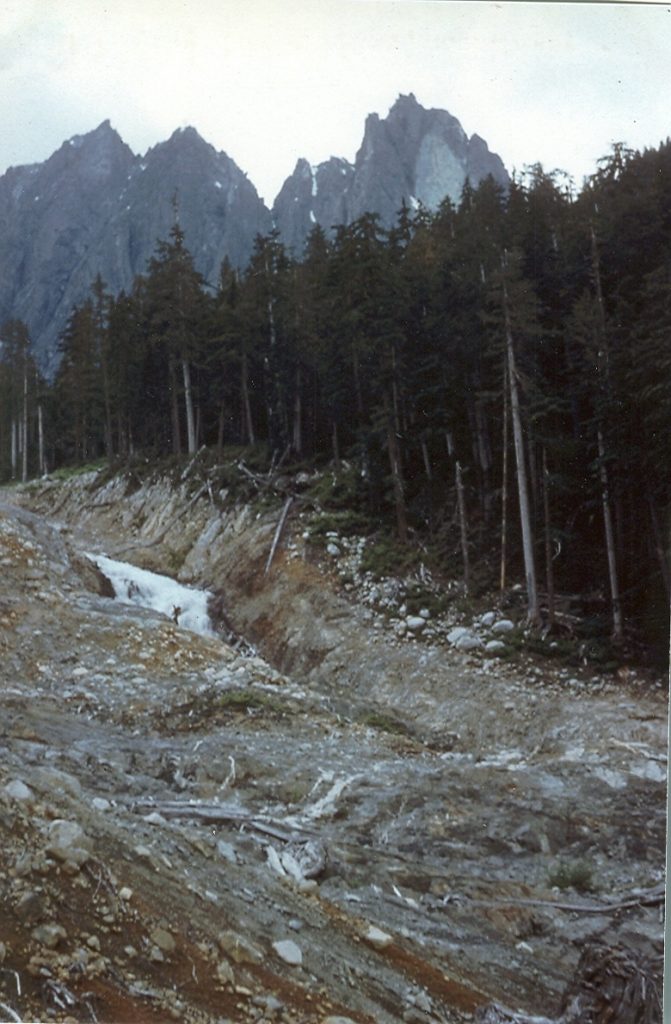
The scar on Mt. Colonel Foster from the rockfall and the path cleared by the displacement wave that cleared the upper Elk River of vegetation 1954 – Patrick Guilbride photo.
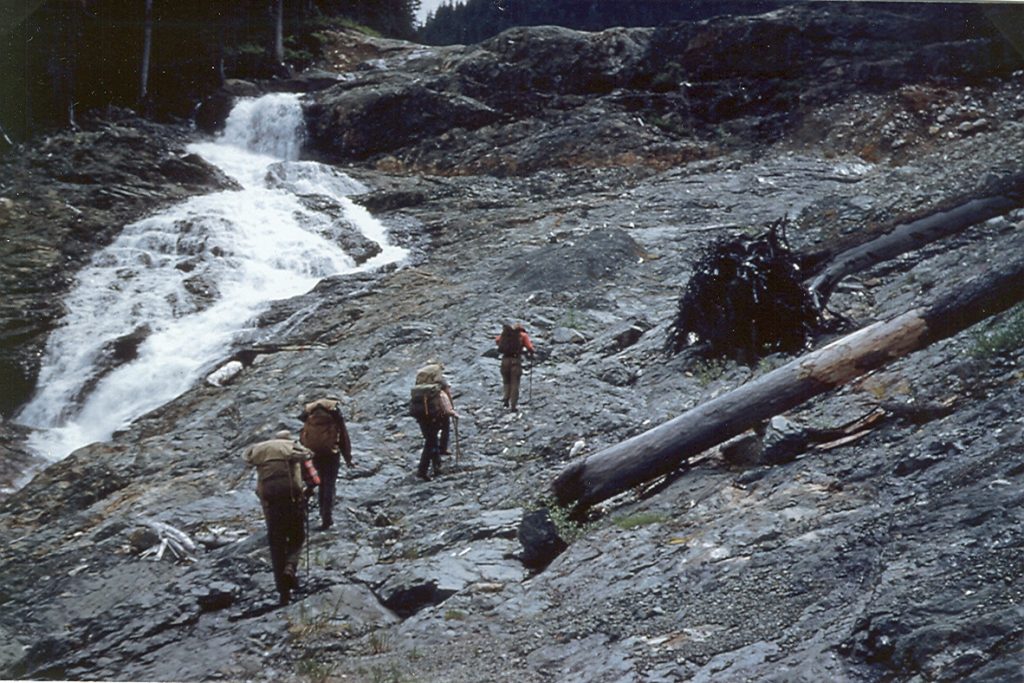
Members of the Alpine Club hiking up the rock beside the Elk River towards Landslide Lake 1954 – Patrick Guilbride photo.
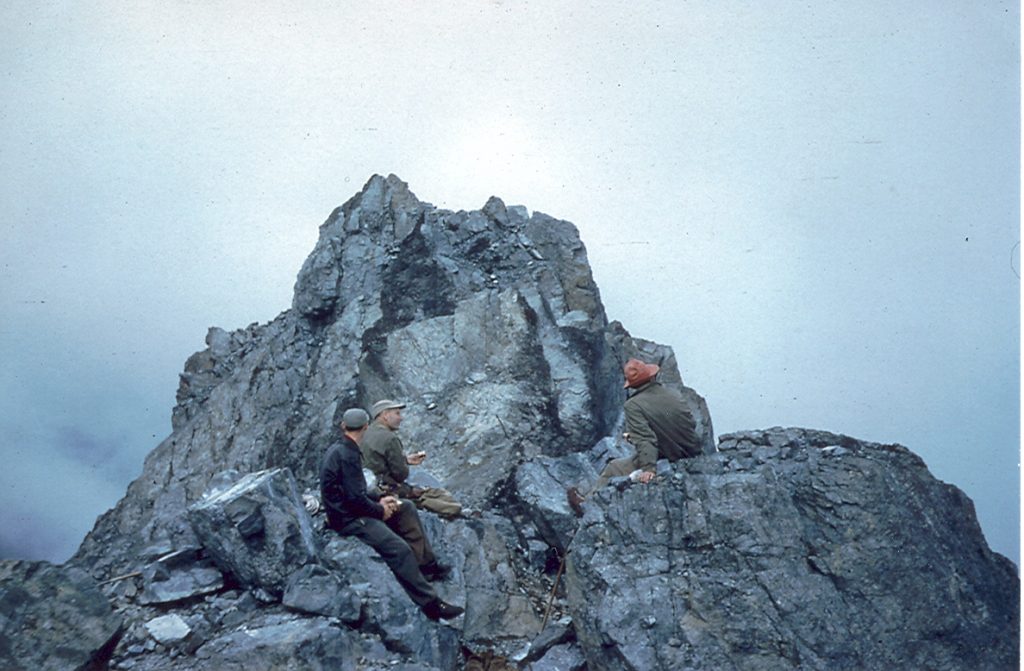
L-R Syd Watts, Bill Lash and Mallory Lash sitting on the Southeast Peak of Mt. Colonel Foster with the Southwest Peak behind1954 – Patrick Guilbride photo.
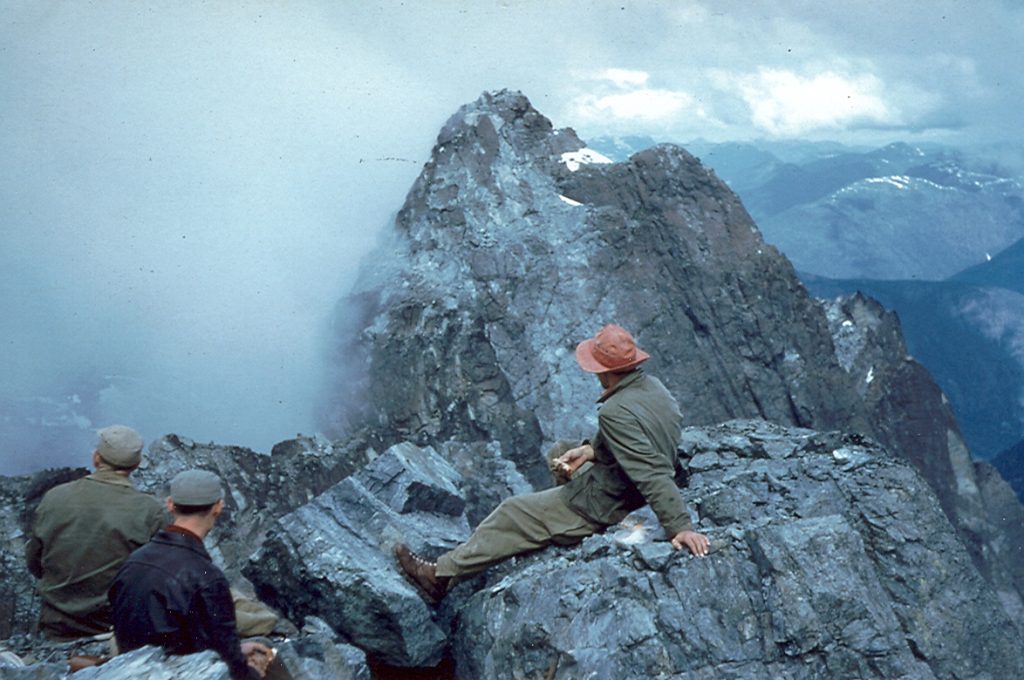
Syd Watts, Bill Lash and Mallory Lash looking towards the main summit of Mt. Colonel Foster from the Southeast Peak 1954 – Patrick Guilbride photo.
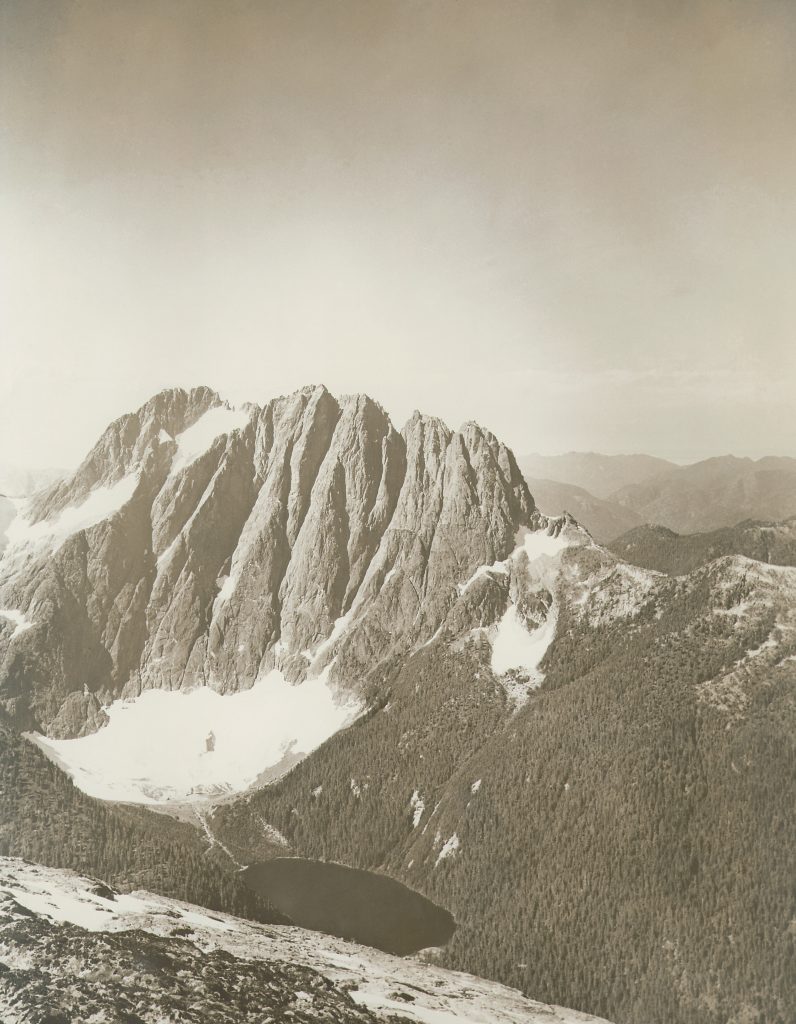
The East Face of Mt. Colonel Foster before the 1946 earthquake – Norman Stewart family photo.
Will Climb Strathcona Peaks
Reported in the Comox Argus Wednesday August 25, 1954. p.9.
A party of twenty members of the Alpine Club from Victoria, Duncan and Courtenay left Saturday for a ten-day trip into the Plateau making camp in the vicinity of Elkhorn Mountain. Courtenay members in the party include Geoffrey Capes, Ted Grieg, Len Williams and Darrell Nixon. The party went in by way of the Campbell Lakes and made their base camp at the foot of Elkhorn Mountain. One of the objectives of the expedition is to climb Elkhorn Mountain, Mount Colonel Foster and Puzzle Mountain, all in Strathcona Park
A Trip to Strathcona Park
Reported in the Canadian Alpine Journal Volume 39, 1955, p.73/74/75.
By Cyril Jones
A few of Vancouver Island section members held a seven-day trip among Vancouver island’s interesting Strathcona Park Mountains, in the upper part of the Elk River Valley where Mount Colonel Foster, Elkhorn Mountain, Kings Peak, and Puzzle Mountain offered a challenge to our group. On Saturday, August 21st, a party of 13 drove by a fair logging road to the Elk River Forks about 32 miles from Campbell River and a half mile below Drum Lake. Leaving our cars there we packed our camp three and a half miles up stream where the party (except for two who went astray) made themselves more or less snug before dark. The next day (Sunday) was spent by the party, including the stragglers, in fixing up camp, and packing more supplies from the car park. On Monday a party of five reconnoitered the ridge towards Elkhorn and Kings Peak, a small party explored the steep slopes on the west side of the river towards Puzzle Mountain and a party of five moved up stream to establish a higher camp on the south end of a lake at the base of Mt. Colonel Foster. The main camp group spent Tuesday quietly doing local chores and exploring down stream to Drum Lake near the car park. The Mt. Colonel Foster group returned to the main camp on Wednesday having had an exhausting yet very interesting two days at the higher camp. They were full of enthusiasm for a return to Mt. Colonel Foster which they found to be a mountain worthy of any climber’s interest. Next day this party augmented by five others returned to the higher camp. It was seen from there that the vicinity of this lake was an excellent base for attacks on Mt. Colonel Foster and Elkhorn Mountain but it was decided that the short time left should be spent on Mt. Colonel Foster. Friday the party divided into two groups, on to the north col at the head of the big slide, whist the other returned to the south col where they had made some reconnaissance earlier in the week. The northerly party reached the col about noon and found that this route did not offer any feasible approach to the top. After a short rest and a short climb along the base of the west face we returned to camp wet through and got a good fire going while waiting for the south col party. The south col party found no trouble in reaching the summit ridge by way of the south col but found progress along the ridge more difficult. After an interesting day they found themselves on a local summit only fifty feet lower than the main peak separated from it by a break in the ridge which presented difficulties great enough to prevent them crossing it that day. Reluctantly they abandoned it and all returned to camp. Next morning we all moved down to our main camp where Mrs. Dorothy Lash and Miss Barbara Dans welcomed us with a first class meal. Saturday we moved down to the cars thence home. The following is an interesting note from Mr. Jones explaining the big slide on the picture of Mt. Colonel Foster. “The Mt. Colonel Foster picture does not show the whole summit ridge but shows an interesting slide. An older photograph of the mountain taken during the topographical survey of the 1930’s shows this as a wooded slope. It appears that a large part of this most northerly turret broke away probably during the 1946 earthquake and fell down this slide into the lake forcing the water up about 100 feet whence it rushed down the valley causing a bare rocky slide area for about a mile and a half.”
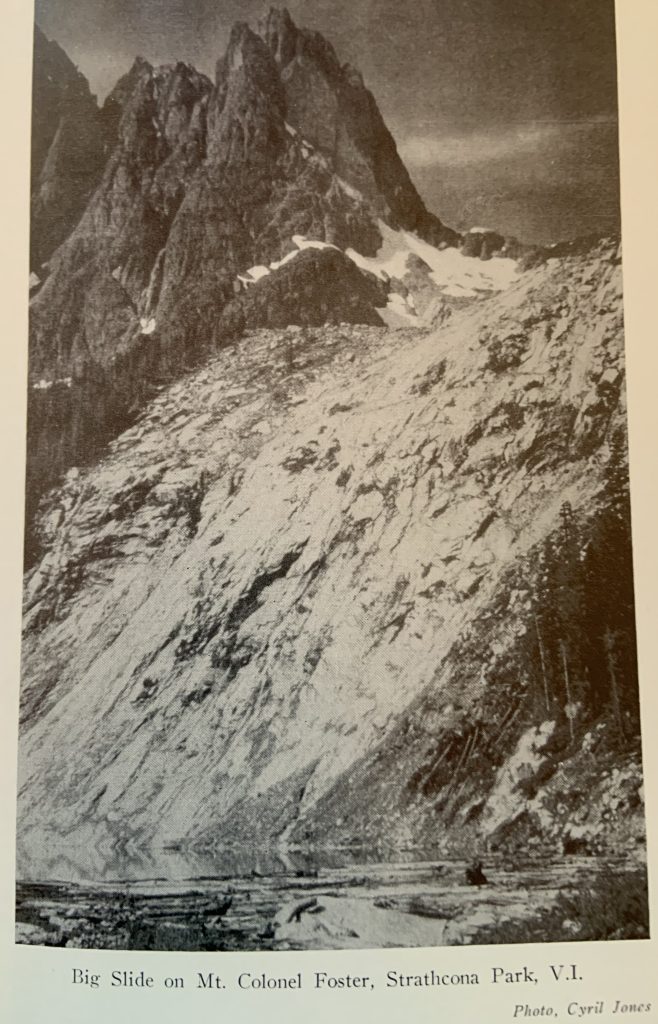
Big Slide on Mt. Colonel Foster, Strathcona Park, V.I. – Cyril Jones photo.
Aircraft Join All-Out Search for 4 On Lost Plane
Searchers Comb Island Mountain
Reported in The Vancouver Sun Tuesday October 12, 1954. p.1 & 2.
Seventeen aircraft, including three helicopters, today were thrown into an all-out search for a twin-engined RCAF Expediter plane missing near rugged Mt. Arrowsmith since Sunday with four men aboard. RCAF officials said the search was one of the greatest in B.C. flying history. Crews of the aircraft scanned the densely-timbered slopes of the 5,958-foot mountain eight miles due east of Port Alberni while a seven-man ground search party encountered heavy snow and bitter cold in its fight to the summit. Searchers operated in prefect weather after being hampered with fog and mist Monday, but no trace was found of the missing plane.
U.S. ‘Copter in Hunt
Two RCAF helicopters and one from the U.S. Coast Guard are taking part and an RCAF Lancaster is doing photo reconnaissance of the area. The missing plane is a widely-used type regarded as extremely dependable. RCAF officials disclosed today that crankshaft trouble had developed some time ago in Expediters back east and that a notice had been posted warning pilots not to push the plane past 1800 – 2000 revolutions to avoid vibration. Officers said the order was later withdrawn and the plane found perfectly trustworthy.
Families Wait
As the search went on, families of the two missing men sat by their radios in Vancouver and hoped against hope that searchers would bring a happy end to their three days of anxiety. They are Mrs. L.E. Oppenheimer, 1228 Garden, wife of the plane’s pilot, Flying Officer Lorne Oppenheimer and mother of two young children; and two daughters and one son of Squadron Leader H.G. Stibbards, 2848 West Nineteenth, RCAF Chaplain.
Won’t Give Up Hope
“We will not give up hope,” said Marjorie, daughter of the permanent force padre who has been 12 years with the air force. His two other children are Karen 12, and Gordon, 15. Others aboard were Flying Officer Michael Saunders, Bristol, England, and R.D. Hall, civilian employee of air material command. The aircraft as enroute from Sea Island to Tofino on the West Coast of Vancouver Island when it disappeared between 1:40 and 2:15 Sunday. It carried complete survival equipment, including rations and snow shoes.
One Signal Heard
Early reports that two SOS signals had been heard were corrected today by RCAF officers, who said there had been one very weak signal picked up by two of the search aircraft. Squadron Leader Stibbards was on his way to conduct a Thanksgiving service in Tofino when the aircraft disappeared. “The weather is excellent,” said an RCAF search and rescue officer in Vancouver. “There is some haze, but not sufficient to prevent close inspection of the mountain.” RCAF officials are hopeful some clue to the whereabouts of the aircraft may be provided by one of the many parties of hunters in the area. Ulf Bitterlich, of Alberni, German mountaineer leader of the ground search party, was climbing the mountain Sunday when he heard a plane’s motors stop and then crash. His brother Adolf, climbing another section of the mountain, heard the same noise and they hastened towards each other and pin-pointed the spot where they thought the plane had hit. Fred Zochling, a third member of the party, was sent scrambling down the mountain to alert police.
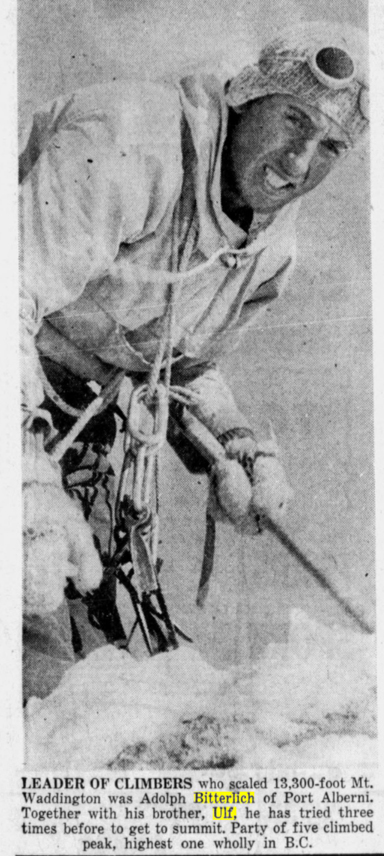
LEADER OF CLIMBERS who scaled 13,300-foot Mt. Waddington was Adolf Bitterlich of Port Alberni. Together with his brother, Ulf, he has tried three times before to get to summit. Party of five climbed peak, highest one wholly in B.C.
Down Near Peak
Bitterlich is sure the plane is down within a mile radius of the top of Arrowsmith. The faint signal heard Monday was mixed with call signals, raising some doubt that it was the lost aircraft, Squadron Leader George Sheahan, searchmaster, said today. He said that the emergency equipment aboard the plane is automatic and should send a straight distress signal if it is properly used. “We’re still working on the SOS angle in the hope that if someone who was aboard the aircraft is working it, he does not know how to operate it and is mixing the call letters into the signal. The right way to operate it is simple to turn a crank and turn out the signal.” Mrs. J.W. Wolverton, 2616 West Sixth, had intended to make the trip along with Chaplain Stibbards, but changed her mind at the last minute. Wife of an air force carpenter at Tofino, Mrs. Wolverton is an organist who has accompanied the chaplain on various occasions. All Sunday night searchers checked on reports of crash sounds, missing motors and fires. One fire, on investigation, revealed a party of hunters on the mountain. Parksville Roman Catholic priest W.H. Bulloch roamed mountain roads all night without success in his radio-equipped Volkswagon.
Foiled By Weather
RCAF planes from Comox and Sea Island, and the helicopters, failed in all attempts Monday to fly over the top of the mountain. Clouds and falling snow kept them below 4,000-foot level, too low to check on the mountaineers’ story. Working on Bitterlich’s information and the fact that nothing has been discovered at lower levels, officials presume the wrecked Expediter is lying near the mountain summit. “The area of coverage is not too big,” one officer said. Bitterlich, a member of Alberni Alpine Club, was last in the news in July when he brought a dead mountaineer, Ralph Rosseau, back from a crevasse on Mount Septimus.
“Funny Crash”
The mountaineer told police Monday he heard a motor that stopped a couple of times—”and then, kind of a funny crash.” Zochling said it was not an explosion. “It was more like an ‘oomph.’” Bitterlich led the ground party on the mountain at 3 p.m. Monday, to a rendezvous with brother Adolf, waiting in an Alpine cabin. With the ground searchers were RCMP Constable Ian Hall of Parksville and his police dog Rip; Sergeant Dennis Henshaw, Flight Lieutenant Dan Mckinnon, Warrant Officer Jerry Gribling, all of Comox; and Staff Sergeant “Red” Jameson, a tough veteran of countless ground searches. The Sikorsky “eggbeaters” were piloted by Fred Snell and Pete Cromwell, employees of Okanagan Helicopters Ltd.
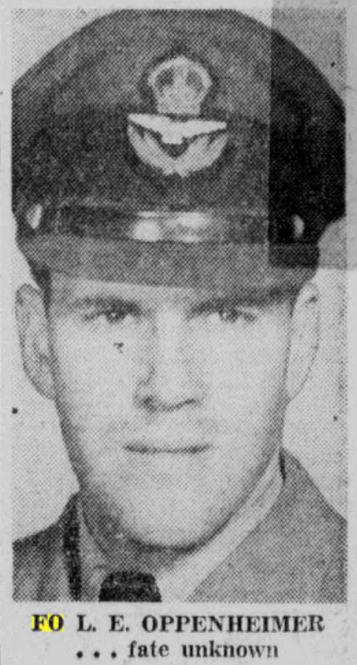
FO L.E. Oppenheimer … fate unknown
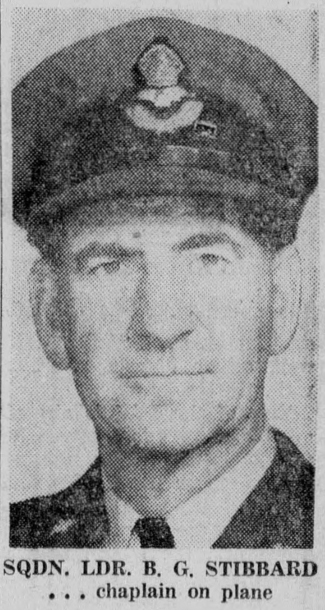
SQDN. LDR. H. G. STIBBARDS … chaplain on plane
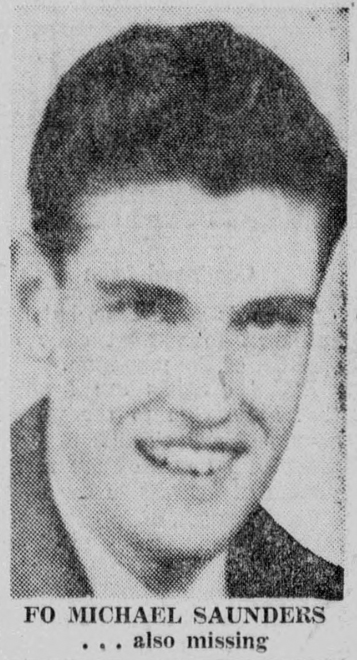
FO Michael Saunders … also missing
Aircraft Exploded on Mountainside
Reported in The Vancouver Sun Wednesday October 13, 1954. p.1 & 2.
Wreckage of an RCAF Expediter missing since Sunday was found at the 5,100-foot level on Mount Arrowsmith at 10:45 a.m. today. Air Force Officials said there were no survivors. The plane exploded when it struck the rugged face of the mountain, scattering wreckage over a wide area. The wreck found today was identified definitely at 11 a.m. as the missing twin-engined Expediter.
Hit Rock Wall
Flight Sergeant J.R. “Red” Jameson, parachutist for the RCAF rescue squad, said wreckage of the plane was scattered over an area of more than 100 yards when it crashed into the solid rock wall 100 feet below the lip of a cliff. Jameson and Constable Hall, RCMP, were lowered to the wreckage by the helicopter, and immediately started digging in the deep snow for bodies.
Bodies Scattered
It is expected that helicopters will have to be used to get out the bodies and RCAF officials were unable to say how long it would take. They reported weather in the Mount Arrowsmith area is closing in rapidly and that rain and storm conditions are expected this morning. This might delay operations. Meanwhile, search aircraft returned to their base at Sea Island and Comox. The three helicopters remain near the scene.
Alpinists Found It
Dead are Flying Officer Lorne E. Oppenheimer, 1228 Graden Drive, pilot; Squadron Leader H.G. Stibbards, RCAF Chaplain, 2848 West Nineteenth; Flying Officer Michael Saunders, of Bristol, England, and R.D. Hall, civilian employee of the air material command. The plane was found by a party of Vancouver Alpine Club members led by Ulf and Adolf Bitterlich, Port Alberni mountaineers.
Heard Motors Stop
The Bitterlich brothers were on the mountain Sunday, when they heard a plane’s motors stop and then a crash and explosion above them. They tried to pinpoint the location while a third member of their climbing party, Fred Zochling, raced down the mountain to tell police. The report touched off one of the greatest search operations in B.C. flying history. As many as 17 aircraft and ground search parties led by the Bitterlich’s searched the rugged densely-timbered slopes of the 5,986-foot peak for missing craft and its four occupants. Bad weather hampered the first two days of search with fog and mist obscuring the upper levels of the mountain. Faint SOS signals at first believed to come from a Gibson Girls transmitter aboard the missing aircraft, spurred their efforts Tuesday. Dozens of other reports were checked by RCAF officials said the Bitterlich brothers. They were so sure of their information that the search was concentrated continually on Arrowsmith.
Sharp-Eyed Boy
The brother’s story was later confirmed by a sharp-eyed 10-year-old, Peter Olsen of Parksville, who saw the plane hit. The boy asked his mother why all the planes were flying over Arrowsmith and she told him that a plane was down. “We did see a plane crash then: it hit and exploded. First of all,” he said, “I thought there were airplanes on exercise. Then I saw it go towards the mountain. When it hit the ground there was a quick flame. It tumbled over the side and then after a while we heard an explosion.” The boy was playing with his foster-brother, Ted Birch, when they witnessed the tragedy. Discovery of the wreckage brought to an end nearly four days of bitter anxiety for the families of Oppenheimer, and Squadron Leader Stibbards in Vancouver.
Hoped to End
Oppenheimer is the father of two young daughters, Sandra, two, and Lorene, six months. Chaplain Stibbards, a veteran of 12 years’ service with the air force, leaves three children, Marjorie, 17; Gordon, 15, and Karen 12. Both families refuse to give up hope that the flyers would be found alive. The aircraft was listed missing at 3:15 p.m. Sunday. Nine planes from Comox and Vancouver RCAF stations were immediately pressed into search. Falling light and bad weather cut the operation off after three hours but as the news was reported by radio many reports of “crashes” were sent to RCAF headquarters by Island residents and hunters. Seventeen aircraft were in operation over the mountain Sunday, including three helicopters, one from the U.S. Coast Guard. Lancaster bombers from Comox undertook photo reconnaissance of the area Monday and were covering 18-mile-wide strips when the lost aircraft was discovered.
Teams Press Search
Reported in The Daily Colonist Wednesday October 13, 1954. p.1 & 3.
By Alec Merriman
PARKSVILLE—Two teams of experienced mountaineers will be dropped by helicopter at dawn today to continue the search for an RCAF Expediter aircraft with four men aboard which crashed Sunday afternoon [October 10]. In addition, 13 aircraft from Comox and Sea Island bases and two RCAF and one US Coast Guard helicopter will start at dawn to continue to comb the area. Air force officials last night still held hopes that all or some of the men survived the crash. Aboard the plane were; Flight Officer L.E. Oppenheimer, pilot, whose wife and two children are in Vancouver. Flight Officer Michael Saunders of Bristol, England: Squadron Leader H.G. Stibbards, chaplain at RCAF headquarters in Vancouver, who was on his way to conduct a Thanksgiving service in Tofino: R.D. Hall, civilian employee of the air force material command.
Routine Flight
The plane was on a routine flight Sunday from Vancouver to Tofino when it vanished in the cloudy, wooded wastes of the Mount Arrowsmith terrain. RCAF officials were confident that if any lived through a crash they would be able to survive. “Every kind of emergency equipment, including sleeping bags, is carried on all our planes,” searchmaster Squadron Leader George Sheahan told The Daily Colonist last night. On the blacker side is the fact that no kind of signal has been sighted from the missing party although the plane was fully equipped with flares. Two brothers, Ulf Bitterlich of Port Alberni, and Adolf of Victoria, will lead the land parties today. They are both members of the Alberni Alpine Club and were hiking at the 3,500-foot level of Mount Arrowsmith Sunday afternoon when they heard a plane motor “rev” up and then cut out.
Veteran Climbers
Yesterday they led a party of four airmen and an RCAF constable in a search on the mountain. Today they will be joined by three experienced climbers from the Vancouver Alpine Club of Canada. They were due to rendezvous at Comox Air base at 12:30 a.m. and take off at dawn by helicopter. If possible, they will be dropped from the helicopter on top of the 5,958-foot peak and the seven climbers will split up into two parties. While full of praise for the seven climbers who searched the area yesterday, Squadron leader Sheahan said he thought more could be accomplished by fully qualified alpinists. “It is an area for strictly expert and fully qualified mountain climbers,” he said. “It is like a solid sheet of ice from 4,000 feet up.”
Lumps in Snow
The climbers will investigate any unusual “lump or bump” in the snow which may have fallen and hidden the missing aircraft. Search officials are confident the plane is in the Mount Arrowsmith area. They feel it may have hit a down draft and crashed below the tree line and be hidden by trees. “If it is under the trees we could search for six months and not find it,” Squadron Leader Sheahan said. More than 100 RCAF personnel, RCMP and other officials have been directly engaged in search, together with dozens of volunteer hunters and members of the forest service, since the plane was last reported at 1:30 p.m. Sunday over Lantzville. Search headquarters is at Comox, and Dakotas and Cansos, Expediters, Lancasters and Otters are sweeping an area 35 miles north and south of Tofino, 48 miles wide and 75 miles long. Helicopters are concentrating on a tree-by-tree search in the Arrowsmith area.
Full Force
No. 121 Communications and Rescue Flight from Sea Island has its full force behind the search. Helicopters are based at Parksville along with a land search truck which keeps in touch by radio with planes, ground service and search parties. Search officials have been besieged by scores of calls from people who claim to have heard or seen the crash. With the full cooperation of RCMP, which has put all its men and equipment in the area at the disposal of the RCAF, every scrap of information is being investigated. “Over half (of reports) are strictly rumor. The people are sincere, but some are letting their imaginations run away with them,” Squadron Leader Sheahan said. They place great hopes on the information of the Bitterlich brothers. They were on Arrowsmith with Fred Zochling of Victoria and were separated when they heard a plane overhead between 2 and 3 p.m. Sunday. They pinpointed the scene of the crash within a mile radius of the top of Arrowsmith. Adolf said the plane seemed to be running fine and then they heard it “rev” up the motor and then suddenly stop. Mr. Zochling started out for help, but got lost on the way down and had to sleep out. The next morning Ulf Bitterlich descended the mountain, found Zochling on the way down, and reported to RCMP. A search party was organized and led by Ulf, set out at 3 p.m. Monday. In the party were Warrant Officer 2 Jerry Gribling of the RCAF at Comox, LAC John Mackenzie of the RCAF at Comox, Sergeant Denis Henshaw of the RCAF at Comox, Flight Sergeant J.R. Jameson of the RCAF search group, and RCMP Constable Ian Hall and Rip, his German Shepherd, and the Bitterlich brothers and their Weimaraner dog, Hexie Von Reiherhof. The party took portable radios and flares and camped up the mountain Monday night. They found sleeping bags hidden in a cache and slept under the trees while an inch and one half of snow fell on them overnight. Yesterday they climbed to the 5,000-foot mark, but when they returned at 1:40 p.m. they had nothing to report except cold and windy. The Bitterlich brothers have little faith in reports of people having seen the plane crash. Visibility up there was only about 50 yards, they say. Flight Lieutenant M.S. Wolochow, RCAF medical officer, took part in the air search Sunday afternoon and reported it was so bumpy that even experienced airmen were sick. One of the most reliable reports of a crash came from Peter Olsen, 10, and Ted Birch, 8, of Swayne Road, Errington, who said they were playing in a farmyard near Arrowsmith when they saw a plane crash. Their mother sent a note to their school teacher who informed RCMP. The lads, from whose house is the best view of Arrowsmith in the district, said they thought the left wing bumped into the mountain and then they heard and saw an explosion. They placed the crash in approximately the same location as the Bitterlich brothers. Flight Officer K.R. Cox yesterday investigated a report from some hunters that they saw several puffs on the McLaughlin Ridge, south of Arrowsmith, and it is likely helicopters will search that area. One aircraft has been patrolling the area every night in hope of sighting a fire or flares. Flight Officer Ron Nicholson is directing the helicopter search. Among Victoria climbers familiar with the Arrowsmith area, ready to assist in the search for the lost fliers, are Alexander “Sandy” Stevenson, David Blissett, and Alan Morrison all on leave from the RCAF. They had returned to Victoria only last night from a holiday climb in the Arrowsmith area. They were ready to go back at once: but they were not needed. “Thank them, please,” an officer at RCAF base at Comox told The Daily Colonist. “But they are not needed … not yet, anyway.”
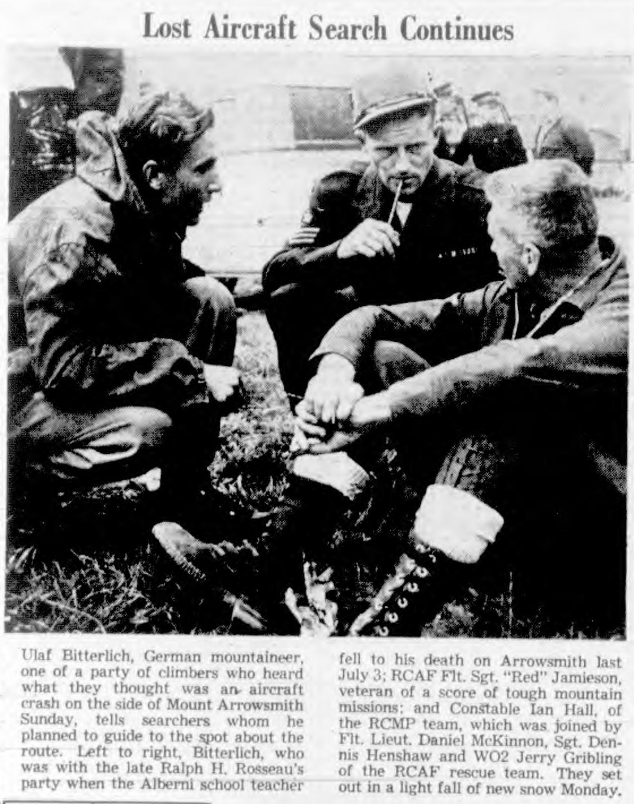
Lost Aircraft Search Continues
Engine Failure Cause?
Reported in The Daily Colonist Wednesday October 13, 1954. p.1 & 3.
Engine failure may have caused the missing RCAF Expediter to crash in the vicinity of Mount Arrowsmith, according to a Victoria alpinist who heard it in trouble. Fred Zochling, 25, of 684 Burnside Road told The Daily Colonist yesterday he was at the 1,000-foot level on the 6,000-foot mountain when he and his friends heard the twin-engine aircraft quite close. He described its engine note as “uneven … a rising and falling sound … then a deep drop in the sound … then nothing. He heard not crash or explosion. Mr. Zochling’s mountaineering friends, Ulf and Adolf Bitterlich, are experienced climbers who have ascended Arrowsmith about 40 times. They are at present leading an RCAF ground search party to the approximate area where they pinpointed the end of the engine sound. A German immigrant who has been in Canada three years, Mr. Zochling is a cooper at Growers Wine Ltd. He has climbed Arrowsmith “about four times.” He and his friends were looking for a suitable site to build a cabin when they heard the erratic sound of the aircraft. Mr. Zochling said it was raining, there was swirling fog and a wind was blowing. He was sent back by the Bitterlich brothers to notify police of what they had heard but he lost his way Sunday and had to spend the night in his sleeping bag. By the time he arrived Monday, his friends had also come down and contacted RCMP officers. A directive was issued to RCAF pilots ordering them to take special precautions for passengers carried in Expediters because of a number of cases of crankshaft failure which had been reported in the east. Pilots were also told not to push the engines beyond a certain speed. Extreme vibration and in some cases disintegration of crankshafts had been experienced on Expediters in the East. The order was later withdrawn, however, when tests proved the trouble had been overcome, RCAF officials say. The plane is regarded by the RCAF as highly dependable.
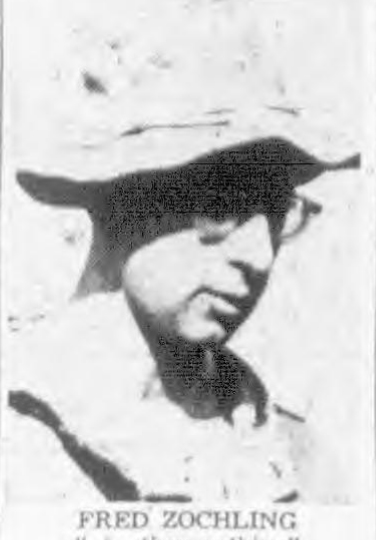
Fred Zochling
Plane, 4 Bodies Found on Mountain
Searchers Find Wreck at 5,100 Feet
Reported in The Victoria Daily Times Wednesday October 13, 1954. p.1.
PARKSVILLE—Four men missing in an RCAF Expediter since Sunday were found dead today in wreckage on Mount Arrowsmith. The bodies are being brought out by helicopter. The plane, scattered over a wide area on the east slope of the 5,962-foot mountain, was sighted this morning by a ground party at 10:45 a.m. It was found by a five-man ground party of the alpine division of the mountain emergency squad from Vancouver, a civilian volunteer group of climbers led by Ulf Bitterlich of Port Alberni and brother Adolf of Victoria. They were dropped atop by helicopter early this morning. The crash site was near where the brothers, climbing the mountain Sunday, reported they heard what they thought was a plane in trouble.
Identified
The ground party which found the wreckage contacted a helicopter by walkie-talkie, and positive identification was made o the twin-engine plane at the RCAF base at Comox. The scattered plane was found in an area which has been flown over dozens of times during the 200 air-search hours by the RCAF in the course of the three-day hunt. It was partially buried in snow. The Expediter last radioed in at 1:38 p.m. Sunday 6,500 feet over Lantzville while on a routine flight between Vancouver and Tofino. An RCAF spokesperson said it must have struck the slopes of Mount Arrowsmith about 15 minutes later.
Icing
He said the fast drop in altitude during the short run could have been caused by icing of the plane as weather was bad at the time. Another 900 feet in altitude and the plane would have cleared the mountain. The alpine party was standing by at the crash site and RCAF officials were flown in to the scene. It is likely bodies will be brought out today. Bodies when brought out likely will be taken to Parksville. The district coroner has already been notified. The crash will be investigated by the RCAF’s accident investigation branch, but it is still too early to determine when hearings will be held. Branch officials must visit the scene first.
Experienced Men
The Bitterlich brothers, experienced climbers have ascended Mt. Arrowsmith as many as 40 times. They were both hiking at the 3,500-foot level Sunday afternoon when they heard a motor “rev” up and then cut out. With them was Fred Zochling, 684 Burnside Road, who described the engine note as “uneven … the nothing.” They heard no crash or explosion.
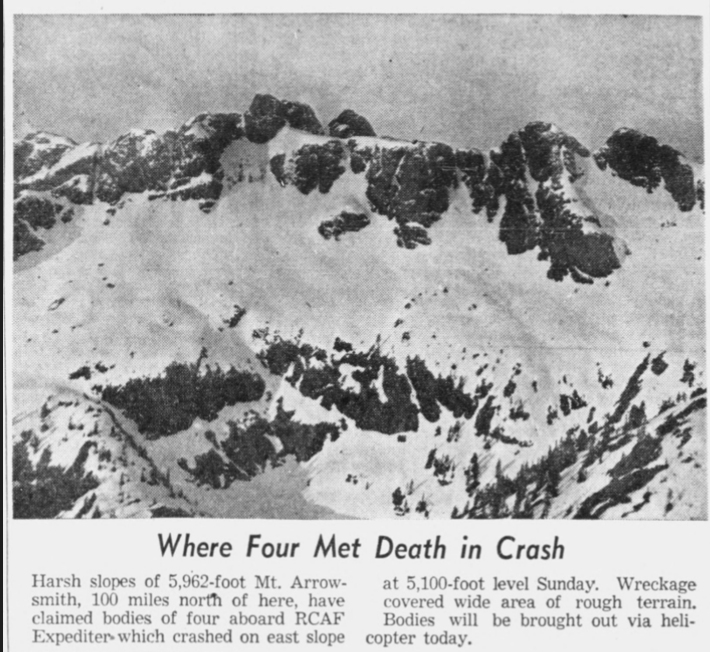
Where Four Met Death in Crash
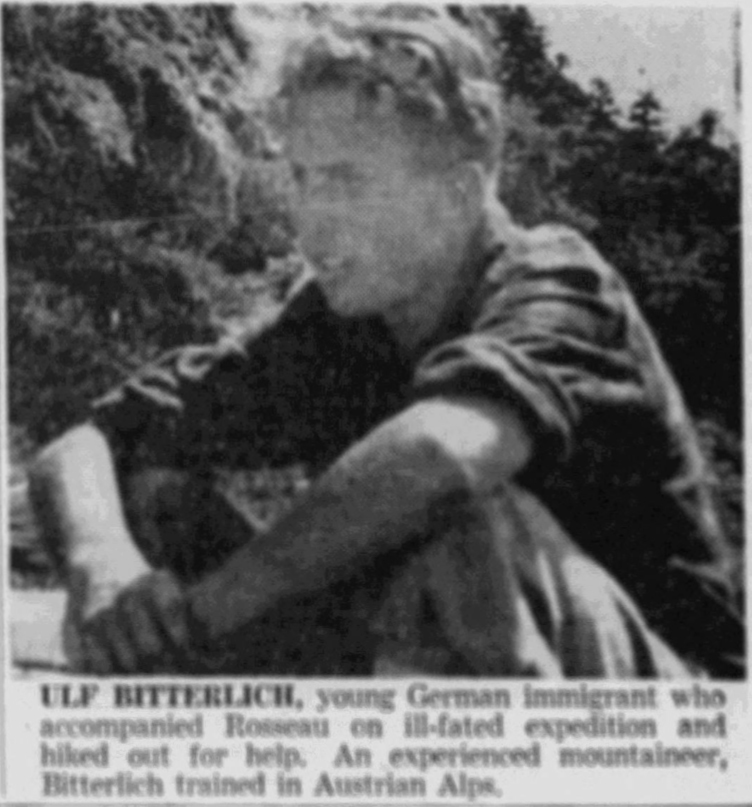
ULF BITTERLICH, young German immigrant who accompanied Rosseau on ill-fated expedition and hiked out for help. An experienced mountaineer, Bitterlich trained in Austrian Alps,
Wreckage Strewn Over 1000 Yards
Reported in The Vancouver Sun Thursday October 13, 1954. p.1.
Vancouver Sun photographer Mickey Carlton flew in a U.S. Coast Guard helicopter at 1 p.m. today over the scattered wreckage of an RCAF Expediter plane which crashed on Mount Arrowsmith on Vancouver Island. Here is his story:
By Mickey Carlton
At 5,000 feet I could pick out pieces of the wrecked plane that disintegrated as it plowed into the side of Mount Arrowsmith, instantly killing the four occupants. Parka-clad mountaineers were picking their way across the treacherous snowbanks directing the U.S. Coast Guard rescue helicopter to hovering position above the snow-covered debris. RCMP Constable Ian Hall and Flight Sergeant J.R. “Red” Jameson aboard the ‘copter prepared to disembark to aid ground crews in preparation for removal of the three charred bodies, and to aid in the search of the fourth victim still unlocated. Heavy cloud formation made their way over the treacherous terrain towards the crash scene and assisted in gathering debris for inspection by RCAF technical experts. On the side of the mountain in a diamond-shaped patch of snow, I could pick out a snow-covered motor that had been torn from the disintegrating Expediter. About 1,000 yards away, what appeared to be a tailpiece was lodged in the ground. And in another direction still more debris could b spotted from the air. Jack Atkinson, Alpine Club of Canada, who lives in Vancouver, spotted the debris after eight hours searching on dangerous terrain and signalled he wanted to come aboard the copter. We returned to the mountain-top plateau, the base of the ground crew, to take on Atkinson and a fellow searcher. I helped pull the two men aboard and they told me that an RCAF helicopter piloted by civilian Fred Snell had previously returned with a battered generator, torn loose from the downed plane.
Missing Airplane Located
Alpinists Dropped by ‘Copter” Spot Wreckage
Reported in the Twin City Times Thursday October 14, 1954. p.1.
News of the finding of wreckage of the RCAF Expediter, lost Sunday, was received just before press time with the announcement that there were definitely no survivors of the crash on Mount Arrowsmith. Alpinists in two search parties found the wrecked plane about 10:45 a.m. Wednesday. Preparations were being made to remove the bodies of the four victims by helicopter via Parksville to Comox. Wreckage of the missing RCAF Expediter plane was sighted by Alpinists dropped by RCAF helicopters at the 5,100-foot level on the east slope of Mount Arrowsmith at 10;45 a.m. today. Two teams of experienced alpinists headed by Ulf Bitterlich of Port Alberni were dropped by helicopters near the peak of Arrowsmith this morning. Positive identification of the wreckage as that of the plane with the four persons aboard, missing since Sunday afternoon, was made at 11:20 a.m. Searchmaster Squadron Leader George L. Sheahan told the Free Press this morning that he would be flying to the scene of the crash in about three hours’ time by helicopter. At noon today it was not known how long it would take ground parties to reach the crash site. The plane disappeared Sunday while in flight from Vancouver to Tofino.
Those on Board
The Expediter piloted by Flight Officer L. E. Oppenheimer of Winnipeg, carried Squadron Leader H.G. Stibbards of Vancouver, Flight Officer Michael Saunders of Bristol, England, and R.D. Hall, an engineer, of Beau Repaire, near Montreal. Ulf and Adolf Bitterlich, mountain climbing brothers of Port Alberni, said they believed they heard the plane while they were hiking high on Arrowsmith Sunday. The two men, both members of the Alberni Alpine Club, were at the 3,500-foot level when they heard a plane motor “rev” up and then cut out. They heard no crash. Shortly before, two Errington boys, Peter Olsen, 10, and Ted Birch, 8, of Swayne Road, Errington, said they were playing in a farmyard within sight of Arrowsmith when they saw a plane crash. They said they thought the left wing struck the mountain and then they saw and heard an explosion. They placed the crash in approximately the same location as did the Bitterlich brothers. Searchmaster Squadron Leader Sheahan told the Free Press yesterday that all reports were being followed up. One aircraft patrolled the area every night in the hope of sighting a fire or flares. A report from hunters that they saw smoke puffs on McLauglin Ridge, south of Arrowsmith
People Sincere
“Over half of the reports were strictly rumor. The people were sincere, but some let their imagination run away with them,” said Squadron Leader Sheahan. Successful culmination of the search within three days of the plane’s disappearance was due to the 100 per cent co-operation of both public and private services with the RCAF organization. Participating in the hunt for the lost Expediter were more than 100 men actually in the field, backed up by scores more who manned key posts tying in the work of searchers on the mountain slopes and throughout the thickly-forested area between the east coast of the Island and the Alberni valley.
RCMP Contribution
RCMP detachments from Nanaimo, Parksville, Qualicum and the Alberni’s played an important part. Constables of the Qualicum, Alberni and Parksville detachments were in the field while Nanaimo RCMP radio, which covers the area, supplied communication between the ground parties. Nanaimo also supplied radio equipment and vehicles supplementing those of the other detachments in the search area. Ground parties worked mainly from the Alberni highway summit almost at the foot of Mount Arrowsmith, while three RCAF helicopters, piloted by Carl Agar’s Okanagan Airway pilots, were based in Parksville. Headquarters of the entire search was at the RCAF Comox base. Sixteen RCAF planes participated from Sea Island and Comox, as well as one U.S. Coast Guard plane. B.C. Forest Service staff, who are perhaps more familiar with the Arrowsmith region than any other individuals, added equipment and experience to the search supplemented by men and equipment from the Western Logging Division of MacMillan Bloedel Ltd. In addition, numerous hunters helped to comb the area, each supplying results of his observations to the general fund of knowledge. Next problem will be removal of the bodies. Reports of faint SOS signals received Monday lent color to the hope that someone may have survived the wreck. However, no further signals were received since.
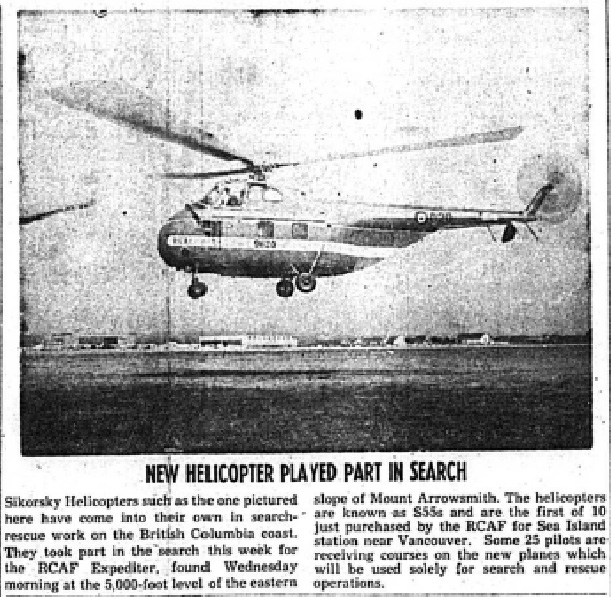
NEW HELICOPTER PLAYED PART IN SEARCH
Plane Wreckage Found At 5,000 Foot Level on East Slope of Mt. Arrowsmith
Missing Expediter Sighted from Search Plane at 11:20 Wednesday Morning: Ground Parties and Helicopters Move In
Reported in the West Coast Advocate Thursday October 14, 1954. p.1 & 6.
Bodies of the four men aboard the RCAF aircraft which crashed on Mount Arrowsmith Sunday while on a routine flight from Vancouver to Tofino were discovered mid-afternoon Wednesday as ground parties reached the wreckage of the Expediter plane. First trace of the missing aircraft was reported by a search plane at 11:20 Wednesday morning, when wreckage was sighted at the 5,100-foot level on Arrowsmith’s eastern slopes. With heavy clouds which had hampered air search all week still persisting, two ground parties were dispatched to investigate and reached the scene within three hours. The ground parties, led by local mountaineers Ulf and Adolf Bitterlich, were made up of members of the RCAF mountain emergency squad, alpine division Vancouver. RCAF spokesmen at search headquarters in Comox did not know immediately which party had reached the scene first. At a late hour Wednesday, arrangements were being made to bring out the bodies, and it is believed that helicopters will be used. The aircraft, enroute from Sea Island to Tofino disappeared between 1:40 and 2 p.m. Sunday. In addition to Flight Officer L.E. Oppenheimer, the pilot of Winnipeg and Vancouver, who has a wife and two children in Vancouver, also aboard Flight Officer Michael Saunders of Bristol, England, Squadron Leader H.G. Stibbards, Chaplain at RCAF headquarters in Vancouver, and R.D. Hall, civilian employee of the air material command, Montreal. Thirteen aircraft from Comox and Sea Island bases in addition to two RCAF helicopters and one U.S. Coast Guard helicopter were engaged in the air search. Squadron Leader George Sheahan, who was overall in charge of the search expressed confidence that if any aboard the missing plane had survived the crash they would be able to stay alive, since all RCAF planes are equipped with every type of emergency equipment, including sleeping bags. Ulf Bitterlich of Alberni, veteran mountaineer, had been leading ground search up Arrowsmith’s precipitous slopes. He and his brother Adolf, with Fred Zochling of Victoria, were climbing Arrowsmith Sunday at the time of the crash and reported hearing the engines change pitch and stop. The Bitterlich brothers said the sound of the engines was uneven as if they were being revved up and down, just before stopped altogether. Climbing different sections of the mountain at the time, both were sure the plane would be found within a mile radius of Arrowsmith’s rocky peak. Although considerable faith had been placed in the report of a Qualicum resident and two boys in Errington that they saw the plane crash on Arrowsmith Sunday, the Bitterlich brothers said the area in which they were climbing was shrouded in cloud with visibility limited to about 50 yards. At the time of the crash they sent Zochling down in search of help, but he lost his way and had to spend Sunday night in his sleeping bag. Ulf Bitterlich found him Monday as he came down and they reported their experience to the RCMP. Two ground search parties, one out of Port Alberni and the other le by Ulf Bitterlich out of Parksville, were organized Monday by RCAF Searchmaster Squadron Leader Sheahan and had been scouring the area ever since the crash. The Searchmaster praised the effort of the RCMP. Constable Ian Hall of Parksville and his police dog “Rip”, Sergeant Dennis Henshaw, Flight Lieutenant Dan McKinnon, Warrant Officer 2 Jerry Gribling, all of Comox and Staff Sergeant J.R. “Red” Jameson, tough veteran of a score of similar searches, who took part in the ground search. Also active were helicopter pilots Fred Snell and Pete Cornwall of Okanagan Airways. Sheahan had voiced the opinion that if the plane had hit a down draft and been forced below the tree line, ground parties “could search for six months and not find it.” To combat this possibility helicopters endeavored to carry out a tree-by-tree search in the Arrowsmith area, but like other aircraft were hampered by the low cloud cover which persisted throughout the week. All attempts to fly over Arrowsmith Monday failed as low cloud and snow kept the machines below the 4,000-foot level. Tuesday similar conditions prevailed. The snow and high winds combined to make air search extremely difficult, and Flight Lieutenant M.S. Wolochow RCAF medical officer, reported it was so bumpy that even experienced airmen were sick. Tuesday the Bitterlich brothers led a ground search party from their camp on the mountain up to the 5,000-foot level, but returned with nothing to report. According to Squadron Leader Sheahan, Arrowsmith from 4,000 feet up is “like a sheet of solid ice” and passable only by fully qualified and experienced mountaineers. One fire investigation Sunday night proved to be the campfire of hunters, while another was investigated Tuesday just after dark by Gordon Moul of Pacific Western Airlines, Port Alberni, who flew over the west side of the mountain and reported he could find nothing. An aircraft of the regular group assigned to the search had been patrolling the area every night in the hope of sighting a fire or flares, with which the missing plane was equipped. The helicopter search was conducted by Flying Officer Ron Nicholson. Altogether between 100 and 200 RCAF personnel, RCMP, B.C. Forest Service and MacMillan Bloedel employees took part in the search this week, together with mountaineers from Alpine Clubs in Alberni, Victoria and Vancouver. Search headquarters was at Comox Air Force base from where Dakota, Canso, Lancaster, Otter and Expediter craft swept a search area 50 miles wide by 75 miles deep from about 35 miles north and south of Tofino to points along the Beaufort Range. Helicopters were based in Parksville and mainland radio contact with other aircraft and a ground search truck which, in turn, kept in touch with the ground search parties. Ulf Bitterlich, who took a leading part in the search of the missing aircraft was last in the news in July when he brought dead mountaineer Ralph Rosseau back from a crevice in Mount Septimus.
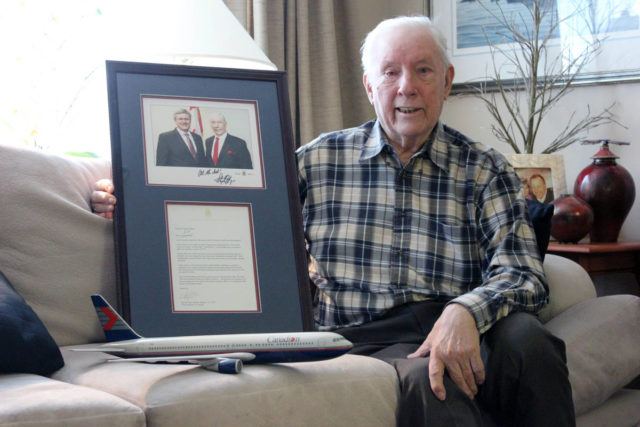
Gordon Moul holding a letter he received in 2013 from then Prime Minister Stephen Harper recognizing a 1972 Entebbe (Uganda) refugee flight Moul captained.
Ground Party Sets Out Today on Grim Trip To get Bodies
Ice-Slicked Peak Plane Crash Site
Reported in The Daily Colonist Thursday October 14, 1954. p.1 & 6.
By Alec Merriman
PARKSVILLE—A ground party of eight airman and civilian guides will set out on foot or by helicopter at first light today to help bring down the bodies of four men from the ice-slicked peak of Mount Arrowsmith. They will join forces with two airmen, two civilians and an RCMP constable, who spent a lonely vigil last night just 200 yards below the top of towering snow-capped Arrowsmith. The bodies are those of Flight Officer L.E. Oppenheimer, 24, of Winnipeg, pilot; Squadron Leader H.G. Stibbards, chaplain; Flight Officer Michael Saunders, 22 of Bristol, England; and R.D. Hall, an engineer of Beau Repaire, near Montreal. All were killed, probably instantaneously, when an RCAF Expediter (Beechcraft) aircraft crashed into the side of the mountain Sunday afternoon. None of the bodies was identified. Alpine climbers who discovered the scattered wreck yesterday morning said if the aircraft had been 200 feet higher it would have cleared the ridge instead of crashing; and if it had been 400 yards to the right it would have cleared through a low pass between the main rock spire of Arrowsmith and a subsidiary peak. Heroes of the four-day search were two brothers Ulf and Adolf Bitterlich, experienced alpine climbers from Germany, who were hiking at the 3,500-foot level of Mount Arrowsmith Sunday and heard the plane engines falter “rev” up then die down.
Stripped Down
Two RCAF helicopters and one from the U.S. Coast Guard were stripped down to carry the alpinists, and after circling the area of Arrowsmith dropped them off on the peak at 9:30 yesterday morning. Ulf Bitterlich spotted the plane wreckage from where the group landed. Keith Ingold and Patrick Sherman accompanied him to the wreckage and shouted back confirmation to Jack Atkinson on the mountaintop. “I frantically tried to radio a message. I should have paid more attention when I was briefed on the portable radio we took with us. It wasn’t tuned right,” Atkinson said. “I motioned the helicopter piloted by Fred Snell, to come in close. He realized from my motions that we had found it and sent out word.” The plane wreckage was sighted at 10:42.
Small Pieces
The plane was scattered in small pieces at about the 5,200-foot level, Atkinson said, and added, “It was covered with snow.” Three dismembered bodies were found almost immediately and last night word was received that workers on the mountain believed they had found the fourth body wedged in ice at a higher level. The plane was found on the east side of the mountain at the head of Englishman River, 400 yards south of the hump and the main summit ridge. Keith Ingold was flown out by helicopter to Comox with parts of the airplane for identification—an auxiliary generator, log book and brief case. Positive identification was made from an emergency credit purchase order book of the pilots. Arrangements for the ground search were made Tuesday night after a study of crash reports from people in the district.
Were in Luck
Squadron Leader George Sheahan told The Daily Colonist yesterday: “We were in luck in plotting it that closely.” For information he credited Mrs. Tom Macmillan, who first reported a crash at 2:05 Sunday: Joe Dillon who reported a crash at 2:45 Sunday and a man named Lewis and his son who were hunting in the area. All are from Coombs. The wreck was found in a spot near which Peter Olson, 10, and Ted Birch, 8, of Errington, said they had seen it plunge. Directions proved to be accurate and confirmed what the Bitterlich brothers had reported.
Dropped at Site
After the plane was found RCMP constable Ian Hall, RCAF medical officer Flight Lieutenant Wolochow and veteran air rescue man Flight Sergeant J.R. “Red” Jameson, were dropped at the site and Jack Atkinson and Patrick Sherman were flown back to Parksville. The Bitterlich brothers remained at the wreckage. Rescuers labored under trying conditions all yesterday to prepare the bodies for removal by helicopter to Parksville, but were unable to complete the job before dark. They built a landing strip for helicopters on a ridge about a quarter of a mile from the wreck. Blair and Thomas were flown out about 5:30 p.m.
Poor Forecast
Weather forecasts are anything but promising for today’s attempt to bring the bodies down. A bad cold front is forecast. Helicopter searchers yesterday said they had passed over the wreckage several times without seeing it. Even after it was discovered it was hard to see, they said. All that was visible was one engine mount and a wing.
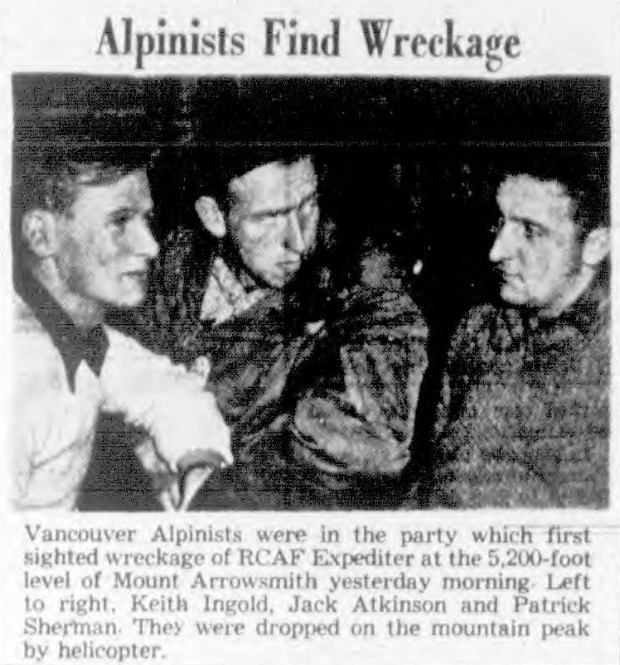
Alpinists Find Wreckage
Rescuers Fight Storm
Weather Stalls ‘Copter, Party Must Pack Bodies
Reported in The Vancouver Sun Thursday October 14, 1954. p.1 & 2.
Heartbreaking task of carrying the dead of the Mount Arrowsmith plane crash out to civilization got underway today with the treacherous slopes of the mountain and the fury of the weather fighting rescue parties every inch of the way. A RCAF spokesman said it would be impossible to say how long it would take to bring the four bodies down from the 5,100-foot level where they died instantly Sunday when the Expediter aircraft crashed. The wreckage, scattered over a 100-yard radius, was located Wednesday morning by a five-man alpine party airlifted into the desolate area by a helicopter. First to spot the wreckage was Jack Atkinson, UBC student.
2 Bodies Recovered
Three bodies have been discovered. The fourth is trapped in the twisted wreckage. First plans were to bring the four bodies out by helicopter but poor weather has prevented the operation. “We have to pack them out,” a RCAF official said. “When we’ll get them out, I can’t say. Maybe Friday, maybe later.” He said it would take an estimated 40 men to bring the bodies down the precipitous slope to the Arrowsmith Trail, one-quarter mile away.
Plane Rescuers Battle Weather
Five men are presently at the site of the crash, and are waiting for an eight-man party from RCAF base at Comox to work their way up the mountain. At least 25 more men will be needed to help remove the bodies from the wreck site and lower them down the mountain. The same conditions which probably caused the crash of the Expediter are making the work difficult. Winds which shrieked through the mountain range at 70 mile-per-hour made life miserable for the party overnight as they huddled in their tent shelters on the steep face of the mountain.
Ice Downdraft
It is believed the plane, on a flight from Vancouver to Tofino Sunday afternoon, ran into heavy icing conditions and was sucked into the rock wall of the mountain by a vicious downdraft. When it hit, it exploded and the men died instantly. A wristwatch on one man had stopped at 2:15. The spot was near the area where the Bitterlich brothers, Ulf and Adolf, heard a plane in distress Sunday.
Wreck Pinpointed
The men, both experienced mountain climbers, led the two search parties into the area after several leads pinpointed the wreck to the high slope of Mount Arrowsmith. The wreckage was found only 400 yards from where the large helicopter dropped the men. When the Bitterlich’s and the rest of the group reached the site, they quickly found the bodies of three men. A generator, a log book and brief case were flown out to positively identify the plane as the one missing A preliminary inquiry was immediately launched by the RCAF, but fuller investigation must wait recovery of vital parts of the wreckage.
Probe Launched
No inquest will be held, but a brie inquiry will be held by Parksville coroner Thomas Hadfield before the air force takes over the full investigation. RCAF investigators will visit the wreck scene as it will be impossible to bring the full wreckage down to civilization. Searchmaster Squadron Leader George Sheahan said he hoped that the dead could be brought out by helicopter, but the weather closed in late Wednesday making flying conditions impossible. “The party at the wreck say they are working in zero visibility,” Sheahan said. “And the winds are so strong that they practically have to hang onto to rocks to keep them from being blown away.” Sheahan said that before the airlift had been called off, one of the bodies had been carried several hundred yards down the mountain to a place the helicopter could land. “That job took five men three hours,” he said. “That’s just how rugged it is up there.”
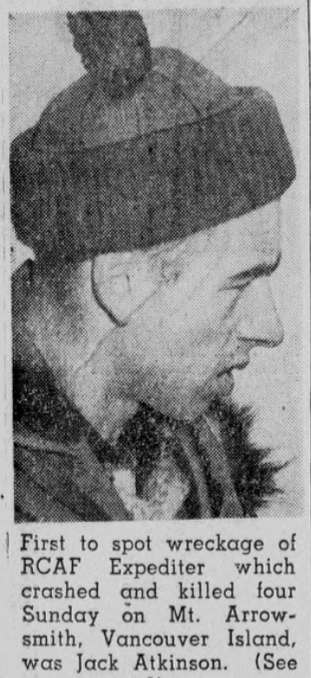
First to spot wreckage of RCAF Expediter which crashed and killed four Sunday on Mt. Arrowsmith, Vancouver Island, was Jack Atkinson.
Wrecked Plane Shattered Cross on Mountain Side
Reported in The Vancouver Sun Thursday October 14, 1954. p.6.
Photographer Mickey Carlton of The Vancouver Sun was aboard a United States Coast Guard helicopter which flew two officials to the wreckage of the RCAF Expediter on Mount Arrowsmith. Carlton came back with this eyewitness report.
By Mickey Carlton
The RCAF Expediter was a shattered cross marking the mountain snow bank grave of four dead men. It was the site of this garish cross, the plane’s horribly twisted and scattered wreckage, that dashed what little hope we held. We knew that there were no survivors. There was but one task left; to dig out the bodies. We’d flown through dense fog and cloud, within four feet of Mount Arrowsmith’s jagged fingertops, to this windswept and lonely grave. Now Lieutenant M.B. Williams of U.S. Coast Guard worked our helicopter in tight circles within the V-shaped ravine at the 5,000-foot level. His voice crackled over the ‘copter’s inter-com. He told the co-pilot, Flight Lieutenant D.W. Defreest, that he was going to drop low enough to land Constable Ian Hall of the RCMP and RCAF technical expert, Flight Sergeant J.W. Jameson. Moments later he ordered me to open the landing door. I signaled the two men to jump as the ‘copter hovered four feet off the ground. I wanted to leave the ‘copter, too. But RCAF officials had ordered me earlier not to takes pictures from the ground. I requested Flight Lieutenant Williams to circle the crash scene. However, we agreed to make a run over the scene for a closer look. We inched down the mountainside. The ‘copter’s whirling blades swept out into the fog and every second I expected them to be shattered against the rock formation next to us. The blanket of fog cleared as we dropped into the chasm to reveal Hall and Jameson snaking their way across the snow bank to the wreckage. We circled them and then went on to reach the wreckage ahead of them. Death had come quickly and mercifully to the fliers en route to a church service.
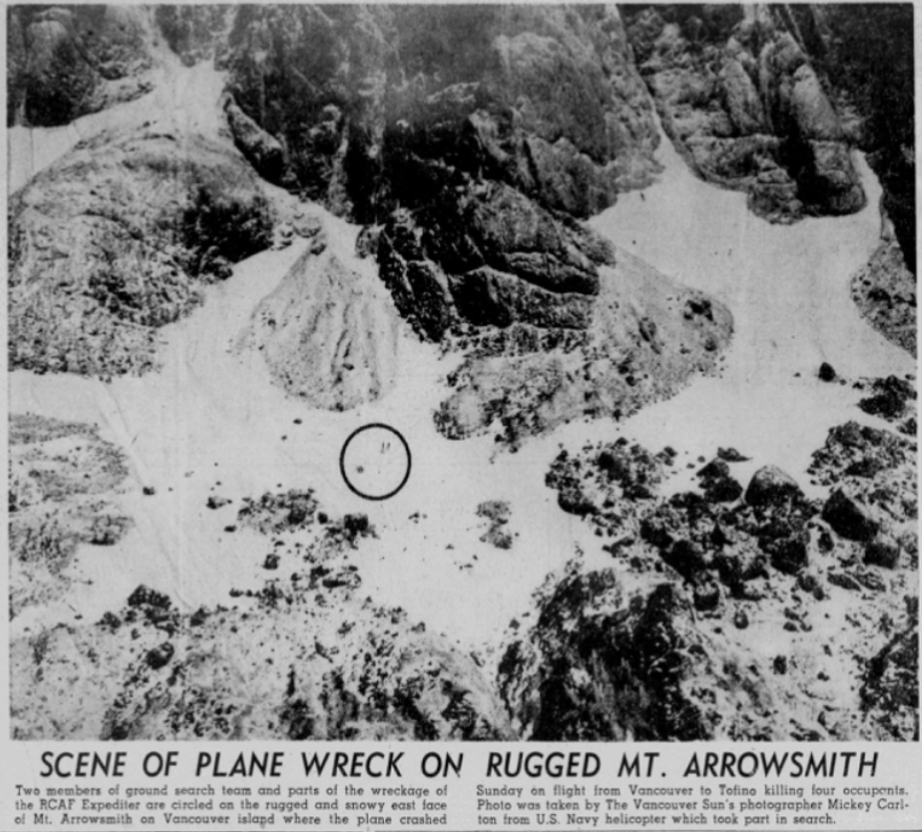
SCENE OF PLANE WRECK ON RUGGED MT. ARROWSMITH
Technicians Are Probing Cause of Expediter Crash
Bodies of Four Victims are Flown Out from Arrowsmith to Sea Island by Helicopter
Reported in the West Coast Advocate Thursday October 21, 1954. p.6.
Bodies of the four victims killed in the crash of an RCAF Expediter plane on Mount Arrowsmith on Sunday October 10, were flown out by helicopter on Friday night of last week and were taken to Sea Island air force base. The bodies, those of three airman and one civilian engineer who died when the plane smashed into the jagged peak near Cameron Lake, were carried down from the 5,000-foot level to a cleared off spot where the helicopter could land, by 38 men who formed the rescue party. Air Force funerals for the pilot Flight Officer L.E. Oppenheimer, of Winnipeg and Vancouver, and Squadron Leader H.G. Stibbards of Vancouver were held this week in the mainland city. The service for Flight Officer Michael Saunders of Bristol, England, was held in Winnipeg. He was to have been married there November 12 to 20-year-old Marilyn Hill. The body of R.D. Hall, a civilian engineer from Beau Repaire, Quebec was flown to Montreal. The twin-engined Expediter crashed into the side of Mount Arrowsmith while taking Squadron Leader Stibbards, padre at the Sea Island base, to conduct church services at Tofino. Search for the plane was hindered by bad weather conditions and the wreck was not sighted until the Wednesday of last week. A 38-man rescue party fought fog, below-zero temperatures, driving rain and 70-mile winds to aid in bringing out the bodies. A five-member team of RCAF technicians has begun investigations into the cause of the wreck.
Heroism in the Mountains
Reported in The Victoria Daily Times Friday October 23, 1954. p.5.
For the second time in just over four months, Alberni’s Ulf Bitterlich has displayed a great spirit of service and heroism under tragic circumstances in the mountains which surround the Alberni Valley. The former Cameron Lake mountaineer, with his brother Adolf deserve the fullest praise and thanks of Vancouver Island people for their heroic roles as leaders of the two ground parties which pressed the exhausting search for traces of the RCAF Expediter plane throughout three long days before the wreckage was found and it was established that all four men aboard the ill-fated craft had perished.
Airp’t Rescue Squadron Seek Missing Plane
Comox Station Headquarters in Search for Expediter
Reported in the Comox Argus Thursday October 27, 1954. p.1.
Ever since the RCAF Expediter plane crashed on Mt. Arrowsmith on Sunday [October 10] the rescue branch of Comox RGAF has been going all out. At one time there were six Lancasters of the 407 Maritime squadron and two Expediters. They flew for 90 search hours covering an area of 5300 square miles. They were out shortly after the accident was announced and flew Sunday, Monday, Tuesday and Wednesday morning until the plane was found at the 5100-foot level on Mt. Arrowsmith. The search was made more difficult because of bad weather conditions. The planes carried out search work round the mountain but were not able to take photographs. The weather was cloudy all the time except for four hours on Tuesday when sun broke through. After the lane crashed an inch of snow fell and there was a great deal of ice on the mountain and its rocky terrain. The plane was eventually found on Wednesday by German alpinists from Port Alberni. Three bodies have been taken out by helicopter. The RCAF is conducting an inquiry as to the cause of the accident and no conclusion has been reached. But there is always a danger of down-draught in the Island range or icing may have taken place on the wings. Approximately a hundred airmen from RCAF Comox took part in the search, each plane carrying between eight and ten men. The captains in charge of the flights were: October 11th—FO McGrath, FO Richmond, FO Siegrist, FO Hincke, FO Menzies. October 12th—FL Johnson, FO Vaughan, FO Hyslop, FO McGrath, FO Brindle, FO Finan, FO Tellitier, FO Richmond, FO Cuff. October 13th—FO Siegrist, FO Menzies, FO Finan, FO Vaughan, FO McGrath, FO Brindle, FO Hyslop.
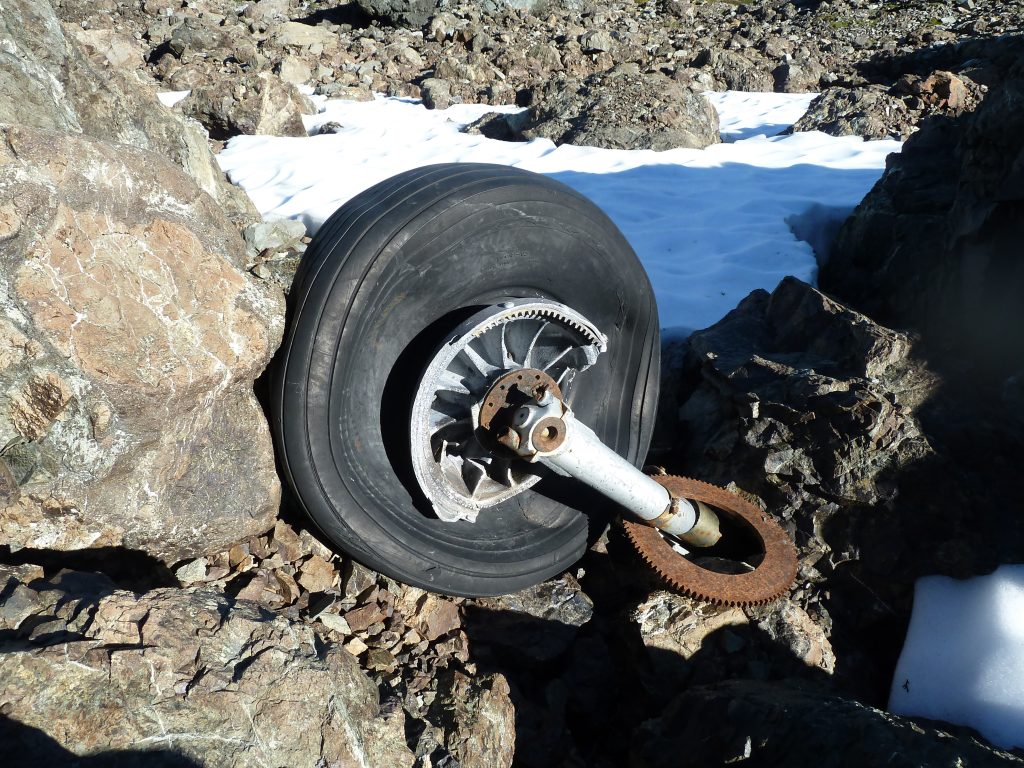
Expediter wreckage
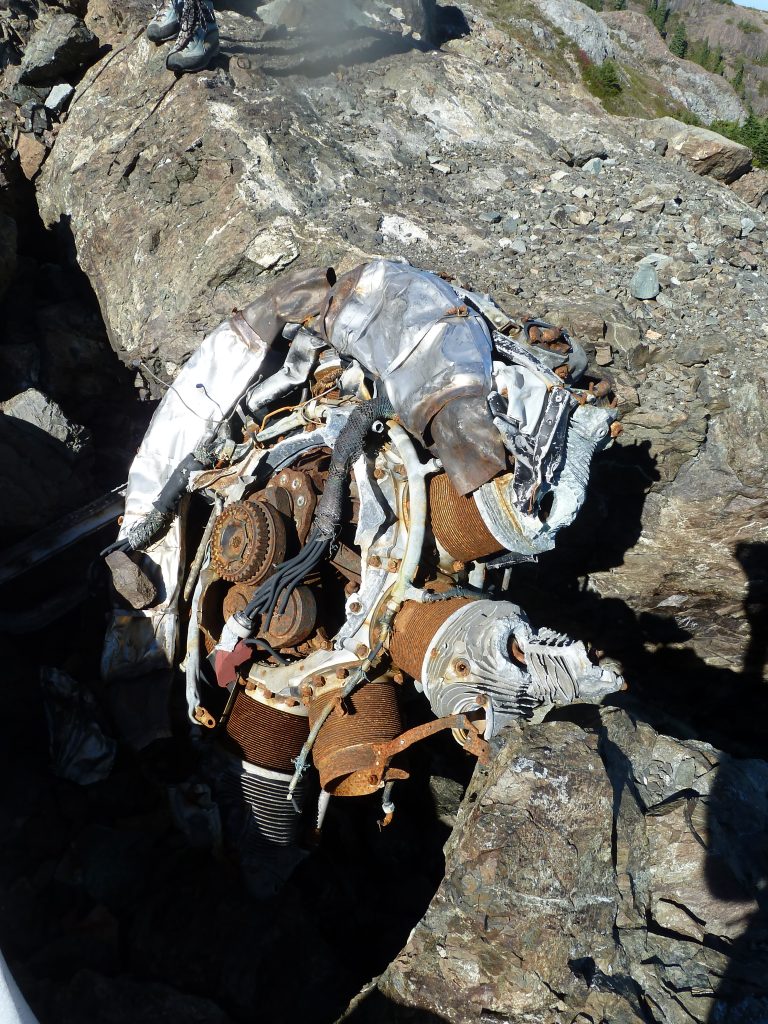
Remains of the RCAF Expediter aircraft which crashed on Mt. Arrowsmith in 1954 – Lindsay Elms photos, ~2015.
Makalu Lecture
Reported in The Victoria Daily Times Tuesday October 26, 1954. p.14.
The Victoria section of the Alpine Club of Canada presents ‘The 1954 Expedition to Mt. Makalu, 27,800 feet’, the world’s fourth highest mountain on November 5. William Unsoeld of Seattle will give an illustrated lecture with superb color pictures at the Oak Bay Junior High School auditorium at 8 p.m. Admission 50 cents.
Attack on World’s Fourth Highest Peak Will Be Told to Local Audience
Reported in The Victoria Daily Times Wednesday October 27, 1954. p.3.
The story of one of the leading Himalayan expeditions of 1954, a California party’s attack on 27,790-foot Makalu, will be told at Oak Bay Junior High School auditorium November 5 by William Unsoeld, a member of the expedition. Makalu, known as “the Armchair Peak” because it resembles a huge easy chair, is the fourth highest peak in the world, and possibly the least known of the really lofty mountains. It is only 12 miles southeast of Mount Everest, on the Nepal-Tibet border. The California Himalaya Expedition’s attempt on Makalu was the first approach ever made to reach this mountain. The Barun valley on which it borders had been traversed previously by only two other human beings, in 1952, and pictures and maps of the area were practically non-existent. The party’s “neighbors” for some time were Sir Edmund Hillary, Dr. Charles Evans and George Lowe, of the New Zealand group exploring the huge Barun Glacier. All three men spoke to a huge audience in march when they appeared at the Memorial Arena, under Victoria Daily Times sponsorship, to describe the successful assault on Mount Everest in 1953. Mr. Unsoeld who was one of the two climbers that reached the expedition’s high point of 23,000 feet before being turned back by the monsoon, will discuss the functioning of large-scale expedition, high altitude equipment, physiology research at high altitudes, and reactions by Sherpa porters to various nationalities. He has been in touch with Major Rex Gibson, president of the Alpine Club of Canada, and is looking forward to his visit here. “According to our talks at base camp with Hillary, his talk at Victoria was greeted with the most enthusiastic interest that he encountered on his entire tour of Canada and the States,” he wrote. “I am truly looking forward with eagerness to a meeting with your section.” A student of both physics and theology, Mr. Unsoeld is working towards his PhD at the University of Washington. He has climbed widely in the Pacific Northwest, Wyoming, the Swiss Alps and has made two attempts on Himalayan peaks.
Ski Notes
Reported in the Comox Argus Wednesday October 27, 1954. p.11.
By Herb Bradley
At the annual meeting of the Comox District Mountaineering Club, held Monday [October 25] at the CRA Hall, the new executive elected were as follows: President, Jim Doucette; Vice-president, Gordon Buck; Secretary, Miss Heather Hopper; Treasurer, Mis Marilyn Pimm; Captains in charge of cabins, lower cabin, Cliffe Gardner; Becher cabin, Sid Williams. It was reported tow ski tows will be in operation of the mountain this year. The CDMC have a new 1000-foot tow just inside the timber above the Lodge, a 15-minute walk from the Lodge. The Fanny Bay Dunkers have a 600-foot tow [bunny tow] on the timber-line hill. Both tows will be operating on week-ends as soon as the snow flies. All former club members and, new members are asked to note that the bus, cabin and tow privileges will only be available to paid up members wearing their 54-55 year badge. Membership chairman is Ruth Masters. The ski busses this year will operate Saturday and Sunday leaving at 9 a.m. sharp, returning bus leaving the lodge at 5 p.m. There is still one more day’s work to be done on both ski tows and anyone wishing to put in one of the work parties should turn out on Saturday at 9 a.m. at Hobby’s or Sunday at 8 a.m. at Hobby’s.
Top U.S. Climber Will Lecture Here
Met Hillary on Peak
Reported in The Daily Colonist Thursday October 28, 1954. p.36.
An American mountaineer who chatted with Everest conqueror Sir Edmund Hillary about Victoria while they were both high in the Himalayas last spring, will lecture here November 5. William Unsoeld, who is working toward a doctorate in philosophy at the University of Washington, is coming at the invitation of the Victoria [Vancouver Island] section of the Alpine Club of Canada. He will speak on the efforts of the 1954 California Himalaya Committee to scale 27,790-foot unconquered Mount Makalu, fourth highest peak in the world. Although unsuccessful, Unsoeld was one of two climbers in the expedition who reached a record height of 23,300 feet. While on the mountain they met Hillary’s party, which included Dr. Charles Evans and George Lowe, who were with him when he lectured in Victoria last March. “According to our talks at base camp with Hillary, his lecture at Victoria was greeted with the most enthusiastic interest that he encountered on his entire tour of Canada and the United States,” reports Unsoeld.
Many Climbs
The climber, who has scaled most of the major peaks in the Cascades, Canada, Switzerland, and has been on two Himalayan expeditions, aims to be a college professor in religions and philosophy. He was born in Arcata, California, in 1916, and is married with two children. He will lecture here at 8 p.m. November 5 in Oak Bay Junior High School auditorium. “It will be a grand opportunity to see some extremely fine color shots of the Himalayas, and to hear a fascinating story of the attempt to climb this great peak,” reports the Alpine Club.
Two Climbers Injured Arrowsmith Slopes
Reported in The Victoria Daily Times Monday November 8, 1954. p.1.
City Man, Alberni Boy Awaiting Rescue Party
A rescue party from Alberni today was working its way up the rugged fog-shrouded slopes of Mount Arrowsmith to aid two injured mountaineers. They are Charles E. Faulkner Jr., Victoria, and Leo Lynn, high school student of Alberni. Faulkner left Victoria at mid-night Saturday with Brian Saunders of Metchosin, Carl Borge, 23, of Brentwood, and Borge’s younger brother John, 21. Sunday at 8:25 p.m. Saunders reported to the RCMP in Alberni that Faulkner had broken his leg on the mountain, and was close to the spot where an RCAF Expediter aircraft carried four men to their deaths October 10. RCMP immediately contacted Ulf Bitterlich, well-known mountaineer who was instrumental in taking rescuers to the scene of the aircraft crash. Accompanied by Leo Lynn, and carrying a small Forst Service radio, a sleeping bag and first aid materials to assist the injured man, he left Alberni at 11 p.m. Sunday.
Rock Shoots Out of Darkness
As they neared the scene a rock shot out of the darkness on the upper cliffs and hit Lynn on the head. Bitterlich radioed that his companion was badly hurt. He bandaged him and got him shelter, then made his way to Faulkner. RCMP have investigated the possibility of the rescue being made by helicopter, but hold little hope for such a move being attempted. “Under the best conditions, landing at the spot is difficult,” Corporal Fraser said. “Under poor conditions it’s impossible. There would be more bouncing around than injured men could stand.” It is believed Faulkner slipped on a rock slide and broke his leg. Bitterlich, in one of his few radio messages, limited because of poor reception, reported both men in good condition but unable to move. Sunday night and early today the RCMP organized a rescue party of 12 men, led by Constable Ian Hall of Parksville and accompanied by Constable Larry Condon of Alberni. They carried food and equipment for two days.
May not Be Out Before Tuesday
“I don’t expect them out before Tuesday night unless they are very lucky,” said Corporal T.C. Fraser of the Alberni detachment, who is directing the rescue operation. A second party was getting ready at press time to assist the first team. Leader Chris Holcomb was taking with him 400 feet of rope requested by Bitterlich in a radio message. Bitterlich said the two injured men were fairly close together, and he asked for a doctor. Dr. N.H. Jones will make the trip. Efforts were being made in Alberni and neighboring Port Alberni to find a physician able to make the trip. Faulkner, a mountain climbing enthusiast, is employed by B.C. Forest Products here. He attended Victoria High School and Victoria College. His father is well known here as a veteran official of Victoria United Football Club. Lynn is a nephew of the late Ralph Rosseau, Port Alberni school principal and mountaineer who died in a snow slide on Mount Septimus in July Here again it was Bitterlich who traveled at night through unfamiliar country to bring help for the rest of the party. Constable Hall has a radio in his party. Communications are being made through Port Alberni. Carl and John Borge are sons of Fred Borge, Wallace Drive, Brentwood. Like Faulkner, Carl had been to Mount Arrowsmith before. John, although he has done considerable climbing, tackled Mount Arrowsmith for the first time on this trip. Saunders, who brought the word of Faulkner’s accident, lives on Metchosin Road.
Rescuers Balked High on Mountain
Climbers Exhausted
Reported in The Daily Colonist Tuesday November 9, 1954. p.1 & 6.
Exhausted rescue workers last night were unable to remove a badly injured climber from his precarious perch high on the face of Mount Arrowsmith. Two fresh rescue teams left Port Alberni late last night to reinforce a group of twenty volunteers at the scene of the accident. The climber, Charles E. Faulkner Jr., 22, of 936 Fullerton Avenue, Victoria, had spent almost 36 hours clinging to a narrow ledge in cold rain and wind.
Compound Fracture
Faulkner was in severe pain from a compound fracture of the right leg, suffered when he fell to the ledge from a ridge above, Sunday afternoon [November 7]. The volunteers at the scene reported they had had such a rugged trip they were all exhausted. A doctor who left Port Alberni early in the afternoon had not reached Faulkner at midnight. Reports were that he and his worn-out party had had a camp far down the mountain. A youth who was one of the first to attempt to rescue Faulkner was injured by a rolling rock, but managed to hike out to safety last night. He is Leo Lynn of Alberni.
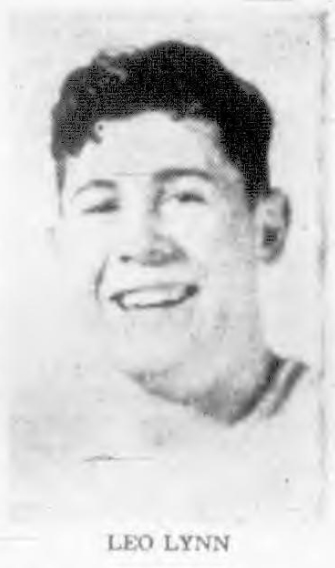
Leo Lynn (1938 – 2014).
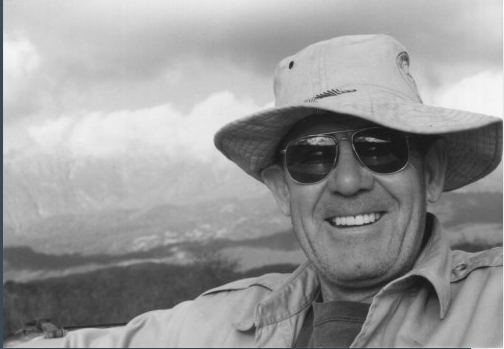
Leo Lynn (1938 – 2014).
Six Parties
In all, six parties had begun the arduous climb over ice, snow and slippery rocks by press time. They hoped to get Faulkner back to Port Alberni today. Last reports said they had managed to move Faulkner a few feet up the slope from the ledge. He was made secure and reasonably comfortable for the night. That was all the rescuers could do for him. Today they will attempt to haul him back up to the ridge from which he fell, or to lower him 200 feet to a plateau from which he could be carried out. Faulkner’s accident occurred about 2:30 p.m. Sunday when he and three other youths climbed to the scene of a recent RCAF plane crash near the peak of Mount Arrowsmith.
Loose Rocks
Faulkner apparently slipped on rain-loosened rock. The ledge which broke his leg saved his life. He might have slid straight down to the plateau. His companions, unable to retrieve him from the ledge, returned to Port Alberni for help. Veteran mountaineer Ulf Bitterlich and Leo Lynn, 16, of Alberni, immediately set out to aid the injured climber. Within a few feet of Faulkner, Lynn was struck on the head by a rock rolling down from above. Bitterlich spent the night tending the two youths. At dawn he called for help by portable radio. Five more rescue parties set out during the next 18 hours.
Two Days’ Food
The rescue operation was directed by Corporal T.C. Fraser of the Alberni RCMP detachment. The first team of eighteen men, including six RCAF men from Comox air base, was led by Constable Larry Condon of Alberni. They caried equipment and food for two days. Just before noon a second party set out. This group consisted of Joe Lynn, Leo’s father; Mrs. Lillah Rosseau, Leo’s aunt and widow of Port Alberni mountaineer Ralph Rosseau who died in an accident on Mount Septimus in July and one or two volunteers. They took 300 feet of badly needed rope. Another party led by Chris Holcombe and including Dr. N.H. Joes and four other men left Alberni at 1:15 p.m. The first group reached Faulkner, Lynn and Bitterlich at about 1 p.m. after an exhausting climb. Mr. Lynn and Mrs. Rosseau were climbing up by one trail while Leo Lynn was walking out another. It was not known whether they ever reached the accident scene. They returned to Alberni late last night. The third party, including the doctor, was unable to get to Faulkner before nightfall. Members of the 18-man party led by Constable Hall radioed for help when they found they were unable to move Faulkner more than a few feet. Two more parties were organized immediately. Seven men left Alberni just before midnight. Two others, both experienced climbers familiar with the mountain, were to follow them about 1:30 a.m.
No Helicopter
It was expected Faulkner would have to be carried out to hospital. Although the accident happened near a landing strip cleared for a helicopter which flew out the bodies of four men killed in the RCAF plane crash a month ago, the rescuers said the helicopter would be useless because of foul weather. Faulkner and three companions had been inspecting the site where the RCAF Expediter had crashed, just before Sunday’s accident. Two of the climbers, John and Carl Borge of Brentwood, stayed at the scene of the crash, while Faulkner and Brian Saunders of Metchosin attempted to climb a few hundred feet further to Arrowsmith’s peak. It was near the summit that Faulkner fell.
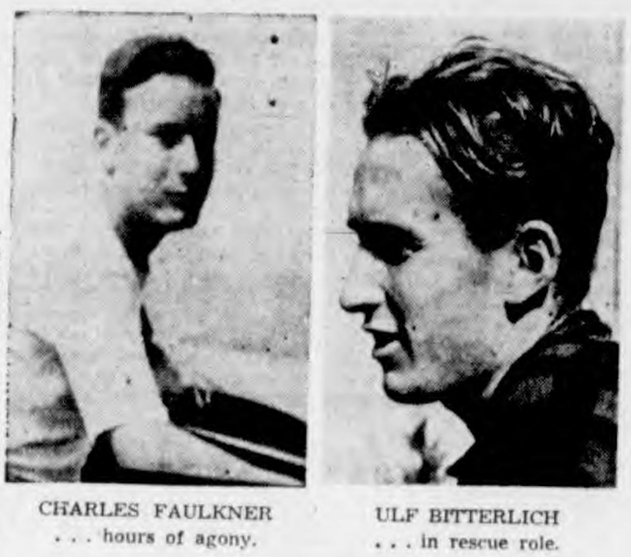
Charles Edward Faulkner (1932 – 2014), Ulf Bitterlich (1931 – 2021).
Night Of Agony Not a Whimper
‘Pretty Darned Brave Guy’
Reported in The Daily Colonist Tuesday November 9, 1954. p.1 & 6.
Charles E. Faulkner, young Victoria mountain climber, is “a pretty darned brave guy,” according to 16-year-old Leo Lynn of Alberni. Despite a 24-hour ordeal of cold, pain and constant danger, Faulkner “never let out a whimper,” Leo reported yesterday. Leo was one of the first two rescuers to reach Faulkner after he fell and broke his leg on Mount Arrowsmith Sunday. Leo himself was injured by a bouncing rock just as he reached Faulkner. Yesterday, after hiking back to Alberni for treatment, he told his story: “Ulf Bitterlich, who is a terrific climber, was at our house Sunday night when the RCMP phoned him and asked him to go out to Faulkner, Ulf and I got ready and took off from Cameron Lake at about 11. It was a tough climb in the dark, but we kept going. Ulf was pretty hard to keep up with, but it’s amazing what you can do when you know a man’s life may depend on you. We reached the accident scene at about 4 a.m. We were just about 11 feet below the victim when a rock came down from above. I stopped it with my head. I blacked out for a minute or two—actually I saw stars—but I came around pretty fast and we went to work on Faulkner. Faulkner had a compound fracture of the right leg. The bones were sticking out through the skin. He’d tried to straighten it out by pulling his foot down, but the bone slipped back out again. We did all we could. First we poured a bottle of mercurochrome on the wound and covered it with gauze. Then we put a blanket between his legs and wrapped a triangular bandage around him. Faulkner had fallen from a ridge about twelve feet above onto a narrow ledge that slanted down at about 45-degree angle. He landed with his feet hanging over the edge. If he’d slid another foot, he would have gone right over. On one side of him there was a steep drop of about 100 feet over jagged rocks. On the other side there was a drop of 200 feet. Faulkner was hanging onto this little ledge by a piece of quarter-inch nylon cord. The other fellow who was with him when he fell (Brian Saunders of Metchosin) couldn’t get him back onto the ridge by himself, so he tied him to a rock up above before he came down for help. There were rocks coming down all the time, all around Faulkner. It was raining and it was cold and there was a heck of a wind blowing. Faulkner had been on that ledge fourteen hours by the time we got to him, but there wasn’t a whimper out of him. I don’t think he even lost consciousness. He’s a pretty darn brave fellow. Faulkner yelled out as soon as he heard us coming. When we got to him, we told him how glad we were to find him. ‘You’re not half as glad as I am,’ he said. He was afraid the other fellow (Saunders) had been hit by a rock on his way down for help and that he’d be left there for keeps. After we took care of Faulkner, Ulf tied a piece of linen around my forehead. It was all he had left. We stayed with Faulkner until dawn, and then Ulf went down below to radio for help. There wasn’t enough room where we were to stretch out the aerial on our radio set. After the first rescue team arrived about 1 p.m. Monday, we ate and then I started down the trail with an air force man named Jerry. When we got to the hospital, they put four stitches in my head. I wasn’t hurt as bad as they made out at first.” Leo paid high tribute to Ulf Bitterlich, who has been a key figure in three mountain rescue attempts in recent months. “Ulf did a wonderful job,” said Leo. “I don’t think there’s anybody else in the valley who could have organized such a feat.” Leo is the son of Mr. and Mrs. Joe Lynn of Alberni. His mother is the sister of Ralph Rosseau, Port Alberni school principal and mountaineer who died in a snow slide on Mount Septimus in July. Bitterlich was instrumental in bringing out survivors of the Rosseau party. He also led the search for an RCAF Expediter which crashed on Mount Arrowsmith October 10, taking four lives.
Mountain Rescue Crew Risk Death
Ease Injured Climber Down Rain-Swept Slope
Reported in The Vancouver Sun Tuesday November 9, 1954. p.23.
Mountaineers gambled their lives on the treacherous slopes of Mount Arrowsmith today to rescue one of their number who fell victim to the Vancouver Island mountain’s deadly fascination. Handpicked teams of rescue workers fought a life-or-death battle passing down a stretcher bearing injured Charles Faulkner, 22, of Victoria, who fell and broke a leg Sunday [November 7] afternoon on a visit to the wreckage of an aircraft.
Widow Volunteers
One of the rescue volunteers was Mrs. Lillah Rosseau of Alberni, widow of climber Ralph Rosseau, who plunged to his death on Mt. Septimus last July, while she watched. The first team of rescuers was lashed by 70-mile-an-hour wind and pelting rain Monday night and one member was injured by a rolling rock. Reinforcements went up the mountain this morning to boost the total number of rescue workers to 28.
Schoolboy Helps
The dramatic rescue bid was led by German immigrant Ulf Bitterlich and schoolboy Leo Lynn, 16, both of Alberni, who set out immediately Sunday night after Faulkner’s three hiking companions came down and reported the mishap. The companions told police that Faulkner slipped and fell from a ledge while attempting to get a “better look” at the wreckage of a RCAF Expediter aircraft which crashed at the mountains 5,000-foot level last October 10 with a loss of four lives. Faulkner’s fall was broken by a narrow projection on the precipitous face of the 6,000-foot mountain, and Bitterlich and Lynn found him perched there in the pre-dawn hours Monday. Lynn suffered head injuries when struck by a falling rock just before reaching Faulkner. The courageous Bitterlich cared for both of them overnight. Lynn managed to walk down the mountain by himself Monday night.
Climbers Saved from Ledge, Rescuers Start Trek Down
Injured Victorian 40 Hours on Mountain
Reported in The Victoria Daily Times Tuesday November 9, 1954. p.1.
Seriously injured Victoria climber, Charles E. Faulkner, Jr., was removed by rescue workers early today from a rock ledge on the high windswept slopes of Mount Arrowsmith. It is expected he will be brought out to hospital by tonight, but much will depend on weather conditions which are hampering the speed of the rescue work. An exhausted rescue party is slowly bringing the 22-year-old mountaineer down the treacherous, icy, mountain slope to a “base camp” where he can receive medical treatment. Faulkner is reported to be in severe pain from a compound fracture of the right leg and suffering from exposure. He spent more than 40 hours alone on a narrow ledge, exposed to bitter cold, wind and rain. RCMP officers said Faulkner may be flown out from the base camp by helicopter if weather conditions at the mountain improve before the end of the day. Foul weather prevented a helicopter from taking off to the accident scene Monday. The base camp where Faulkner is being transported is near the scene of a recent RCAF crash in which four men died.
Injured Man Numb with Cold
Early this morning rescue workers, using ropes, managed to reach the helpless climber lying since Sunday afternoon on a narrow ledge overlooking a 250-foot precipice. He was numb with cold and could speak only faintly. Rescuers hauled Faulkner up to a ridge with great difficulty. He was tied to a stretcher and the rescue party began its descent to base camp where medical aid was waiting. Radio reports from base camp said the descent of the rescue party was slow due to the mountain slope being covered with slippery snow and ice. In some places it covered loose rock, easily dislodged. A slip could have meant death to the members of the party hundreds of feet below in a rocky chasm. The cold winds also hampered the party in its efforts. A rescue attempt Monday failed due to foggy weather and lack of adequate equipment. Today’s rescue was accomplished by having teams of volunteers bring food and equipment to the base camp to equip the rescue party. The volunteers included men from Alberni as well as RCAF personnel. The RCMP is in charge of the operation.
Like Nightmare, Says Saunders
The accident occurred Sunday afternoon. Faulkner, accompanied by Brian Saunders of Metchosin; Carl Borge, 23, of Brentwood and Borge’s younger brother John, began ascending the mountain early Sunday morning. The Borge brothers decided to return home when they neared the summit of the mountain because they were improperly shod and lacked necessary equipment to make the last leg to the peak. But Faulkner and Saunders decided they would make the attempt up the steep icy slope which was partly covered with snow. Saunders described the last climb as slow and dangerous. “I saw Faulkner working himself around a narrow ledge which was apparently covered with ice,” said Saunders. “Then he slipped and fell 20 feet below on a snow slope. I heard him yell ‘I’ve broken my leg.’ He began to slide slowly towards the edge of a 250-foot precipice. I thought he was going over for sure. It was like a nightmare. He was within about a foot of the edge when he stopped.” Saunders believes it was Faulkner’s broken leg which saved him. It was bent underneath him and caused enough friction on the snow to stop him from sliding further onto the rocks below. Saunders was unable to remove the injured man so tied him with a piece of nylon rope to the ledge and made him as comfortable as possible. He then left to get aid. Saunders got lost on the way down the mountain. He slipped twice and narrowly escaped serious injuries. He was completely exhausted when he informed RCMP headquarters at Alberni of the accident. His two other companions, the Borge brothers, were unaware of the accident when they reached the foot of the mountain. Ulf Bitterlich, a veteran mountaineer, and Leo Lynn, 16, of Alberni, were the first to set out to see if they could help the injured climber. Lynn got a few feet from Faulkner when he was struck on the head by a rock rolling down from above. Despite the serious cut, Lynn and Bitterlich stayed with the injured climber through the night, and did what they could to comfort him. The two men in the morning started down the mountain to get more help. However, rescue parties were already on their way. The first team was composed of 18 men, including six RCAF men from Comox. But the rescue party were unable to do much for the climber as they lacked sufficient rope. Rain made the mountain slope extremely slippery. Other rescue teams followed, which included a group consisting of Joe Lynn, Leo’s father, who had learned that his son was injured by a rock, and Mrs. Lillah Rosseau, widow of the Port Alberni mountaineer Ralph Rosseau, killed in a climbing accident last July. They took equipment to the base camp. Another party left this morning with Dr. N.H. Jones, of Alberni, with further equipment and food for the rescuers.
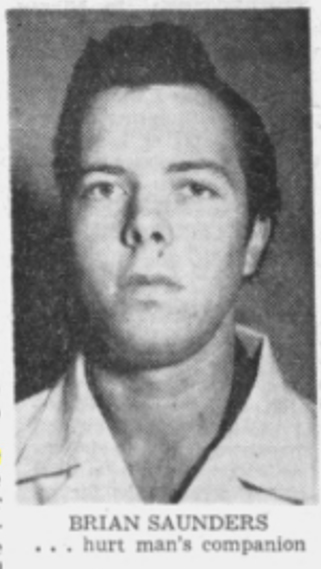
BRIAN SAUNDERS … hurt man’s companion
Injured Climber Clung to Tiny Ledge
40 Terrible Hours on Mountain
Reported in The Victoria Daily Times Tuesday November 9, 1954. p.13.
“I never met a braver man.” That is how 16-year-old Leo Lynn of Alberni described Charles E. Faulkner, 936 Fullerton Ave., Victoria, who spent over 40 hours on a narrow ledge overlooking a 250-foot precipice on Mount Arrowsmith, with a smashed bone in his leg sticking through the skin. Leo and Ulf Bitterlich were the first rescuers to reach Faulkner, who fell and broke his leg on the slopes of the mountain Sunday afternoon. The two men were unable to do anything for the injured climber due to lack of equipment. Leo was injured by a bouncing rock just as he reached Faulkner, but spent the night comforting the injured man. “The wind was howling and it was cold and lonely up there, but Faulkner never let out a whimper,” he said. “I looked at his leg and he just smiled and said it was all right. He was cold and shivering, and there was little we could do to help him. He was certainly glad to see us and we were just as glad to see him. The poor fellow had hardly enough room to move his leg. He was only a foot away from the precipice. During the night it rained and rocks came tumbling down from above but none hit us. It was weird up there, alone with a helpless man.” Lynn said Ulf Bitterlich poured a bottle of mercurochrome on the wounded man’s leg and covered it with gauze. Then he put a blanket between his legs and wrapped a triangular bandage around him. “I left in the morning because of the wound to my head,” Leo said. “It turned out it wasn’t nearly as bad as I thought. But I was lucky I didn’t fall down the cliff because I saw stars for a moment and didn’t know if I was going to fall.” Leo praised Ulf Bitterlich for his work. Bitterlich has taken part in several other alpine rescue parties and has a thorough knowledge of Mount Arrowsmith.
Mountain Rescue Nears End
Reported in The Vancouver Province Tuesday November 9, 1954. p.3.
ALBERNI—Rescuers today succeeded in lowering an injured mountain climber down a 200-foot ice-coated cliff near the summit of 6,000-foot Mt. Arrowsmith, where he had lain in agony since Sunday. Nearly 30 volunteers helped to get Charles Faulkner, 22, of Victoria, off the icy ledge to which he was tied for safety, and down to the campsite used by a party which found the wreck of an RCAF plane nearby on October 13. Weather foiled a plan to winch the injured victim into a helicopter, and the party began the long trek down the mountain on foot. They were expected to reach Alberni before dark. A few hours before Faulkner was rescued, Leo Lyn, 16, hit on the head by a falling rock Sunday when he went to help Faulkner, reached safety. Leo, nephew to Alberni mountaineer Ralph Rosseau, who was killed on Mt. Septimus last July, managed to make his own way down the mountain with an RCAF volunteer late Monday and went to hospital for stitches in a head wound. He was full of praise for Faulkner, tied to a narrow cliff ledge for 24 hours, and unable to move because of a badly broken leg.
‘O Canada’ Inspires Injured Climber
Youth Awaiting Rescue, Sings on Icy Peak to Drive Away pain
Reported in The Vancouver Sun Wednesday November 10, 1954. p.12.
The words of “O Canada,” flung into freezing night air high on the slopes of Mount Arrowsmith, gave new heart and the will to live to a young injured mountaineer, recovering today in a Port Alberni hospital. “I didn’t think I’d make it,” Charles Faulkner told rescuers as they carried him down the treacherous slopes of the mountain.
Like Candles
Faulkner, 22, of Victoria who fell and broke a leg on a visit to the wreckage of an aircraft at the 5,00-foot level of the mountain, was taken to hospital after his rescue. A courageous team of climbers, who gambled their lives on the steep slopes to rescue Faulkner, inched their way down the mountain to civilization late Tuesday with the injured man. “They were like candles in a church procession,” said Salvation Army Lieutenant Ed reed, as he watched the slow weaving of the rescuer’s torches down the slopes. The 30 rescuers who stayed on the mountain Monday night during a 70-mile-an-hour gale and driving rain, plus 18 additional volunteers who joined the team Tuesday, slogged back to civilization at 6 p.m., 11 hours after they started down from near the summit of the 6,000-foot mountain.
Youth Insured
Leo Lynn, 16, of Port Alberni, one of the first to reach the injured Faulkner, suffered a skull fracture when struck by a falling rock. The youth, who was able to walk down the mountainside Monday night will be flown to Vancouver for surgery. The team, led by German immigrant Ulf Bitterlich, spent six hours Monday lowering Faulkner down the rockface by ropes. They spent Monday night at the rim of an ice-field, and Tuesday started on the dangerous, inch-by-inch climb down to the Island highway, at the east end of Cameron Lake. Throughout the painful trip, rescuers said Faulkner talked and joked with the men. “He was a guy with guts,” said one.
Miss Disaster
During the descent, disaster almost overtook the party, when Sergeant Lloyd Bunce of the RCMP, slipped 30 feet off a cliff but managed to grab a rope, and escaped unharmed. The rescue party was met part-way down by Dr, N.H. Jones of Port Alberni, who administered morphine to Faulkner, and by Salvation Army officials at the base camp.
Injured Mountaineer Is Brought on Stretcher from Mountainside
Reported in the Twin City Times Wednesday November 10, 1954. p.1.
Another epic of Mount Arrowsmith was drawing to a close Tuesday afternoon as rescuers came down from the precipitous slopes with an injured man on a stretcher. Charles Faulkner, 22, Victoria, had lain on a ledge above the 5,000-foot level since late Sunday afternoon. With a compound fracture of his leg, he had been left on the narrow ledge while a companion, Brian Saunders, also of Victoria, rushed for aid. Ulf Bitterlich, playing his third role in mountain rescue attempts in this district since July, was first to reach the scene, a short distance above the spot where an RCAF plane crashed last month killing four men. Also playing a heroic part in the drama was 16-year-old Leo Lynn, son of Mr. and Mrs. Joe Lynn, Alberni. Leo accompanied Bitterlich in a night-time hike over the mountain trail, leaving Alberni at 11 p.m. Sunday. Just before reaching the spot where Faulkner lay, he was knocked unconscious by a rolling rock. The lucky youngster made a swift recovery and was able to proceed under his own power after another party reached the scene Monday afternoon. Early Monday morning, Bitterlich flashed a radio-telephone message to RCMP telling of Lynn’s injury. Later a stronger message came through in which Bitterlich asked for a doctor to be sent to the scene and called for an additional 400 feet of rope to be used in bringing out the injured man. At daybreak Monday morning a party under Constable Ian Hall, Parksville, and Constable Larry Condon, Port Alberni, set out on the trail. The group included six RCAF rescue squad members and local mountaineers. At approximately noon Chris Holcombe led another party carrying additional supplies and accompanied by Dr. N.H. Jones. Mrs. Lillah Rosseau, widow of Ralph Rosseau who lost his life in a slide on Mount Septimus last July, was one of another group of volunteers. She accompanied her brother-in-law, Leo Lynn’s father, setting out in the rain for the hike to bring help to her nephew. Leo, accompanied by a member of the RCAF party, had proceeded down the mountain by another trail. At 9:30 Tuesday morning, RCMP here received a message stating that the party carrying Faulkner on a stretcher was preparing to leave the spot of foot. At press time, there was no further news of the party although a message from Victoria stated that it was likely that an attempt would be made to fly the injured man from a site further down the mountain.
Rescued Climber in Good Condition
Treatment Began for Smashed Leg
Reported in The Daily Colonist Wednesday November 10, 1954. p.1.
By T.A. Myers
PORT ALBERNI—A youthful Victoria mountain climber was resting comfortably in hospital here last night after a terrible two-day ordeal on Mount Arrowsmith. Charles E. Faulkner Jr., was successfully carried out to civilization at 6:30 p.m. yesterday by a fifty-man rescue crew. He was immediately taken to West Coast General Hospital here for treatment of a badly smashed leg. He suffered a compound fracture Sunday afternoon when he tumbled from a ridge on 6,000-foot Mount Arrowsmith to a rock ledge twelve feet below. He lay on the ledge for twenty-eight hours until he was removed in a hazardous operation directed by veteran German mountaineer Ulf Bitterlich.
Wants to Talk
Settled in his hospital room last night, Faulkner’s first words were a plea to his nurses “for some company. It was mighty lonely on that ledge,” he told them. “Let’s talk. I want to hear some voices instead of the wind howling and rocks rolling near me.” The youth’s general condition was described as “excellent.” After he had rested a few hours, his leg was put in a cast and traction was applied to pull the shattered bone ends in place. The full story of the rescue, in which nine separate teams took part, was being pieced together last night by RCMP Corporal T.C. Fraser, who organized the operation from his Alberni base. Key figure in the drama was Ulf Bitterlich, who has also taken a leading part in two other rescue attempts in the same area this year. Bitterlich was the first man to reach Faulkner on his windswept ledge, at about 4 a.m. Sunday. Just behind Bitterlich was sixteen-year-old Leo Lynn of Alberni, who was knocked unconscious by a rolling rock as he neared the injured man. Lynn, who was at first considered not seriously hurt, was also taken to hospital yesterday with a depressed skull fracture—a dent in his head. He will be taken to Vancouver today for his treatment by a brain surgeon. His condition is good. Bitterlich, who learned first aid in Germany, did the best he could for both youths. He applied field dressings to the open wound on Faulkner’s leg where broken bones had cut through, then trussed his legs together, using the good leg as an emergency splint. “Then Leo and I tied him securely so he couldn’t fall off his ledge, put him in a sleeping bag and made him as comfortable as we could for the night,” he said. “Then I dressed Leo’s wound and we crouched together under our other sleeping bag. In the morning I radioed for help. By 11 a.m. (Monday) the first rescue party had arrived. Within two hours we had organized a base camp below the scene of the accident and got ready to move Faulkner. We had to get him down a sheer rock cliff 150 feet high. We then had to move him another 500 feet across a snowfield to get him to the gravel bank where he would be comfortable. This took us five hours,” Bitterlich said. Faulkner was lowered down the cliff in a stretcher. Two men above held the ropes. Bitterlich, also roped, “walked” down the cliff face, holding the stretcher to keep it from banging against the rocks.
Held by Darkness
Below the snowfield the party camped for the night. Other rescuers had come up in the meantime, but Bitterlich declined to move farther in the darkness for fear of other men being injured. About 10 a.m. Tuesday, more volunteers arrived on the scene and the pack-out began. The men carried the stretcher and Faulkner, a 200-pounder, in relays of eight. Part of the time their trail ran along a ledge so narrow that men on the outside of the stretcher were in danger of falling off. A brief period of good weather prompted hopes a helicopter could be used to carry Faulkner out, but the sky soon clouded over. At Cokely Ridge the stretcher party met Dr. N.H. Jones, who had been unable to make the climb up to the summit. Dr. Jones dressed Faulkner’s wound and the party pressed on. It didn’t stop again until it emerged at the foot of the trail near the east end of Cameron Lake. There an ambulance was waiting to take the injured climber to hospital. The young climber was met by his father, Charles E. Faulkner Sr., of 936 Fullerton Avenue, Victoria. “And the people up here have been absolutely wonderful,” he added. “They didn’t know my son, yet dozens of men went up that mountain in rain and ice and snow to help him. It’s just wonderful.” Mr. Faulkner said more than 100 Alberni Valley folk turned out to see the end of the drama, when the stretcher bearers walked out of the woods. Women had hot soup and coffee waiting for the men he said. Mr. Faulkner had high praise for Ulf Bitterlich, a “most amazing man.” Bitterlich, in turn, was impressed by young Faulkner’s courage. “He’s a very, very good one,” Bitterlich said. “He was very brave. All that time he never complained. If he asked me to do something for him and I couldn’t do it, that was the last he said about it. He behaved like a man should behave.” As for the rescue itself, Bitterlich summed up: “it was damned hard work.”
Injured Climber Now Safe
Reported in The Vancouver Province Wednesday November 10, 1954. p.25.
PORT ALBERNI—Charles E. Faulkner, a young Victoria mountain climber, sat precariously on a ledge on 6,000-foot Mount Arrowsmith for 40 painful hours with a broken leg was brought out late Tuesday. Weary rescue workers staggered into base camp about 14 miles from here at about 6 p.m., 11 hours after they started down from near the summit. Faulkner was rushed to West Coast General Hospital here, where he was reported in good condition. Faulkner fell from a ridge to the sloping ledge overlooking a 200-foot cliff about 2:30 p.m. Sunday [November 7] while he and another climber were inspecting the site of a recent RCAF plane crash.
Lowered to Plateau
It was early Tuesday before 30 rescue workers who stayed on the mountainside overnight were able to lift Faulkner back onto the ridge. He was then lowered to the plateau 200 feet below down a treacherous, icy slope. Police here say the rescue party, reinforced by 13 more who started out from Alberni at noon, plodded through 70-mile-an-hour winds, rain and sleet down a narrow trail. They were met part way by Dr. N.H. Jones of Port Alberni, who administered morphine to the pain-racked Faulkner. Dr. Jones said Tuesday night the climber took the tortuous trip down the mountain in “good spirits.”
Rescuer Injured
Meanwhile, Leo Lynn of Port Alberni, 16-year-old rescuer who was struck on the head by a falling rock when he and Ulf Bitterlich of Port Alberni first arrived on the scene Monday, is to be flown to Vancouver for an operation.
Rescuers Near Hurt Climber
Reported in The Vancouver Sun Wednesday November 10, 1954. p.12.
PORT ALBERNI—Rescue squads of nearly 30 men were on their way from here today, trying to bring down two injured climbers, one a would-be rescuer, lying on the vertical, ice-covered peak of 6,000-foot Mt. Arrowsmith. A bid Sunday night to rescue Charles Faulkner, 22, of Victoria, almost ended in tragedy when Leo Lynn, 16, of Alberni, was hit on the head and seriously injured by falling rock.
Hero on Guard
Alberni mountaineer Ulf Bitterlich, a hero of two recent Vancouver Island mountain rescue bids, stood guard over the injured pair. Bitterlich and Lynn reached Faulkner when Lynn was hurt. It was bitterly cold, and the party had no tent. The rescue parties, first of which started the long hike from Cameron Lake at dawn, expected to take at least two days. Leading them were Constable Ian Hall of Parksville RCMP, and W.O. Robert Gribbling of RCAF Station Comox.
Turned Back
Faulkner was climbing with Brian Saunders, also of Victoria, when the first mishap occurred Sunday. Saunders said; “Four of us planned to climb to the scene of the recent plane crash, but Carl and John Borge turned back because of bad footwear. We were only a few feet from the top, and were practically over the dangerous part when Charles slipped on icy rock. He dropped about 12 feet to a snow slope, then fell another 160 feet, stopping just above a vertical cliff. His right leg was broken. I gave him my clothing, tied him to a rock in case he moved nearer the cliff, then went for help.”
Brave Alberni Lad Goes to Vancouver Hospital; May Require Operation
Leo Lynn Injured on Head by Bouncing Rock During Faulkner Rescue Operation Taken to Mainland by Order of Doctor
Reported in the West Coast Advocate Thursday November 11, 1954. p.1.
Following x-ray examination which showed a depressed fracture of the skull, sustained by Leo Lynn just as he reached the side of Charles E. Faulkner, Jr., 22, of Victoria, injured mountain climber, who fractured his leg on Mount Arrowsmith last Sunday, Leo Lynn, son of Mr. and Mrs. Joe Lynn of Alberni has been ordered to the Vancouver General Hospital by Dr. R.W. Garner. Accompanied by his mother and father, Leo left Wednesday morning for the Vancouver hospital where he will be examined by a specialist, with the possibility that he will have to undergo an operation to relieve pressure on the brain. Leo Lynn, just 16 years of age was one of the first to reach the side of Faulkner after he fell and broke his leg, and just as he arrived, he was hit on the head by a bouncing rock. On Monday he made his way back to Alberni and had an interesting story to tell. “Ulf Bitterlich, who was a terrific climber, was at our house on Sunday night when the RCMP phoned him and asked him to go after Faulkner. Ulf and I got ready and took off from Cameron Lake about 11 o’clock. It was a tough climb in the dark, but we kept going. Ulf is pretty hard to keep up with but it’s amazing what you can do when a man’s life may depend on you. We reached the accident scene about 4 a.m.”
Stopped Rock with Head
“We were about 10 feet below the victim when a rock came down from above. I stopped it with my head. I blacked out for a minute or two – I actually saw stars – but I came around pretty fast and we went to work on Faulkner. Faulkner had a compound fracture of the right leg. The bones were sticking out through the skin. He tried to straighten it out by pulling his foot down, but the bones slipped back out again. We did all we could. First we poured a bottle of mercurochrome on the wound and covered it with gauze. Then we put a blanket between his legs and wrapped a triangular bandage around him. Faulkner had fallen from a ridge about 12 feet onto a narrow ledge that slanted down at about a 45-degree angle. He landed with his feet over the edge. If he had slid another foot, he would have gone right over. On one side of him there was a steep drop of about 100 feet over jagged rocks. On the other side there was a drop of 200 feet.”
Tied Him to Rock
“Faulkner was hanging on to his little ledge by a piece of quarter-inch nylon cord. The other fellow who was with him when he fell (Brian Saunders of Metchosin) couldn’t get him back onto the ridge by himself, so he tied him to a rock up above before he came down for help. There were rocks coming down all the time, all around Faulkner. It was raining and it was cold and there was a heck of a wind blowing. Faulkner had been on the ledge 14 hours by the time we got to him but there wasn’t a whimper out of him. I don’t think he even lost consciousness. He’s a pretty darn brave guy. Faulkner yelled out as soon as he heard us coming. When we got to him we told him how glad we were to find him. ‘You’re not half as glad as I am,’ he said. He was afraid the other fellow (Saunders) had been hit by a rock on his way down for help and that he’d be left there for keeps. After we took care of Faulkner, Ulf tied a piece of linen around my forehead. It was all he had left. We stayed with Faulkner until dawn, and then Ulf went down below to radio for help. There wasn’t enough room where we were to stretch out the aerial on our radio set. After the first rescue team arrived about 1 p.m. Monday, we ate then I started down the trail with an air force man named Jerry. When I got to the hospital, they put four stitches in my head.” Leo paid high tribute to Ulf Bitterlich, who has been a key figure in three mountain rescue attempts in recent months.
Did a Wonderful Job
“Ulf did a wonderful job,” said Leo. “I don’t think there’s anybody else in the valley who could have organized such a feat.” Leo Lynn’s mother is the sister of Ralph Rosseau, school principal and mountaineer who died in a snow slide on Mount Septimus in July. Bitterlich was instrumental in bringing out survivors of the Rosseau party. He also led the search for an RCAF Expediter plane which crashed on Mount Arrowsmith on October 10, taking four lives.
Hayo Huisman Describes Conditions on Mountain
Member of Rescue Group Tells Advocate Alberni’s Lucky to Have Services of Experience, Competent Mountaineers
Reported in the West Coast Advocate Thursday November 11, 1954. p.1 & 8.
Conditions on Mount Arrowsmith during Monday and Tuesday’s dramatic rescue of Victoria climber Charles Faulkner. Hayo Huisman climbed the mountain Monday with one of the rescue groups carrying ropes and supplies, but was unable to help with the later stages of the operation because of having injured his ankle. The Alberni’s are very lucky to have the services of skilled climbers such as Ulf Bitterlich, who led this week’s rescue operation on Mount Arrowsmith. Without his experience and skill, the task would have been much more difficult under the extremely hazardous conditions existing at the time. The injured man, Charles Faulkner, showed a great deal of courage and patience as he waited through two nights while the rescue parties worked their way up to his position and started the long job of bringing him into Port Alberni for hospitalization. “I have heard it asked by people around town why it was necessary to have as many as 50 men on the mountain to carry out the operation. It must be remembered that the rescue party was working under the same extremely dangerous conditions of terrain and weather which prevailed when Faulkner suffered his injury. His position on a foot-wide ledge not many hundred feet below the peak of the mountain, or a nearly vertical slope, with the rocks badly iced by a nearly freezing rain, meant that only a few could work at a time and still maintain a very minimum of safety. Trying to work Faulkner down to where he could be carried out was very tiring work, especially for these men who had climbed the mountain under very tough conditions. It was necessary for the men to work in relays while they roped the basket stretcher down the first few hundred feet, a few inches at a time. This phase of the operation took about six hours. The work had to be stopped at dark owing to wind and rain. After the injured man had been lowered to a point from which he could be carried, the men again worked in relays. Carrying the stretcher down the mountain required fresh men as often as possible, to bring Faulkner out quickly. This phase of the work was where the large number of men was most needed. Especially the stretch up the West ridge, a slope of about 45 to 60 degrees. The first group of men were very tired by early Tuesday morning, when they brought Faulkner up over the ridge and down the west slope, having had almost no rest since Sunday night. Very strong winds and a cold rain Monday night cancelled sleep for most of the early party. After resting for a while, the first party continued down the trail and relieved the Monday night group in carrying the stretcher. The last group, which started out Tuesday, met them on the trail and took over the stretcher bearing. Each time a call was sent for men, more turned out than had been asked for, which was very gratifying to those leading the parties. When it is remembered that most of the civilian volunteers lost time from their jobs for the period they spent on the mountain, the response can be better appreciated. Even before Sunday’s accident, plans had been sketched out for the formation of a rescue organization. The biggest obstacle to the formation of such a group is the money needed for the equipment which would be necessary. Cost of equipping a climber will run to about $200 for such items as boots, crampons, pitons, rope, ice axe, skis if necessary and miscellaneous equipment for the party.”
Mountain Climber Brought to Hospital After Two-Day Ordeal on Arrowsmith Peak
Remarkable Rescue Operation Carried Out by Volunteers Following Accident in Which Charles Faulkner of Victoria Breaks Leg
Reported in the West Coast Advocate Thursday November 11, 1954. p.1.
Following his terrible two-day ordeal on the summit of Mount Arrowsmith, Charles E. Faulkner Jr., 22, of Victoria, was brought into West Coast General Hospital at 6:50 o’clock Tuesday night, and although suffering from a compound fracture of his right leg, he is resting fairly comfortable in his hospital bed. A 50-man rescue team brought the injured youth down the mountain after he had been rescued from a ledge, and subsequent journey down the mountain on a stretcher was a real hazardous operation which left every man on the rescue squad physically exhausted. Removal of Faulkner was carried out under the directions of veteran mountaineer Ulf Bitterlich of Alberni. Details of the operation pieced together from numerous sources tell a story of courage, hardship and bravery by many people. Nine separate rescue teams took part in the rescue and … Corporal T.C. Fraser, who organized the operation from RCMP headquarters in Alberni had high praise for everyone involved with the affair. As usual in episodes of this kind which appear in the mountains hereabouts Ulf Bitterlich was the key man in the rescue efforts. He, with Leo Lynn, 16-year-old Alberni youth were the first to reach the injured man, arriving about 4 a.m. Monday after starting out from Cameron Lake about 11 o’clock Sunday night. Just as the two reached Faulkner, Leo Lynn was hit on the head by a bouncing rock, and first aid had to be rendered by Bitterlich to both Faulkner and Lynn. The injured man was tied to the ledge as securely as possible so that he would not fall off and then Bitterlich and Lynn crashed in their sleeping bags until daybreak when Bitterlich had to go further down the mountain to radio for help. It was about 11 a.m. Monday when the first rescue party reached the scene. A base camp was organized below the scene of the accident. It was found that it would be necessary to get Faulkner down a sheer rock cliff 100 feet high. Then he had to be carried another 600 feet across a snowfield to get him to a grassed bank where he would be made comfortable. This took five hours. Faulkner was lowered down this cliff in a stretcher, two men above handling the ropes. Bitterlich also roped “walked” down the cliff face holding the stretcher to keep it from banging against the rock. Another rescue party reached the scene
At 10:30 a.m. Tuesday, the packers began following the arrival of more volunteers. Faulkner, who weighs 200 pounds, was carried in relays of eight. At times the men walked along a ledge so narrow that at times the outside men were in danger of falling off. Dr. N.H. Jones, of Port Alberni, who had gone in on Monday, but whose party had been unable to make the climb to the summit, met the rescue squad at Cokely Ridge. Here first aid was rendered. Faulkner and the rescuers pressed on, finally emerging at the foot of the trail near the east end of Cameron Lake, where an ambulance was waiting to take the injured man to West Coast General Hospital. The accident occurred about 2:40 p.m. Sunday when Faulkner and three other youths climbed to the scene of the RCAF Expediter plane crash near the peak of Arrowsmith. Faulkner apparently slipped on rain-loosened rocks. The ledge which broke his leg saved his life. He might have slid straight down to the plateau. His companions, unable to retrieve him from the ledge, returned to Port Alberni for help. Two of the climbers, John and Carl Borge of Brentwood, stayed at the scene of the plane crash while Faulkner and Brian Saunders of Metchosin attempted to climb a few hundred feet further to Arrowsmith’s peak. Besides Bitterlich many experienced mountaineers took part in the rescue operation including men from the Comox RCAF base, Constable Ian Hall of Parksville, Larry Condon, Joe Lynn, Mrs. Lillah Rosseau, Chris Holcombe, Art Skipsey, Dan Jones, William “Bill” Reith, Hayo Huisman and many others. Ulf Bitterlich’s laconic comment on the operation: “It was damned hard work.”
Alberni’s to Raise Fund to Aid Hurt Volunteer
Rescue Setup Likely
Reported in The Daily Colonist Thursday November 11, 1954. p.13.
A fund will be raised in the Alberni’s to help pay the medical expenses of an Alberni youth hurt in an attempt to rescue a helpless Victoria climber from Mount Arrowsmith. Stand-by rescue organizations may be set up in the Alberni’s and in Victoria to help in future mountain rescue operations. These were two developments as the story of the rescue of Charles Faulkner came to a close. Faulkner, a 22-year-old Victorian, was removed from a narrow ledge near Arrowsmith peak and carried to hospital Tuesday in one of the most arduous rescue jobs of recent years. More than fifty men and one woman helped. Leo Lynn, a 16-year-old Alberni High School student who was one of the first to reach Faulkner, suffered a depressed skull fracture when he was hit by a rolling rock. Lyn was flown to Vancouver yesterday for treatment. His condition last night was good and he is scheduled for surgery today.
$300 Expenses
Surgical and other expenses are expected to amount to at least $300. Since Leo Lynn, like all the rescuers, volunteered for the mission, he will get no government aid. “It’s too much to ask a volunteer to stand that kind of expense, so we are organizing a public-subscription fund for Leo,” said Arthur Skipsey, a member of one of the first rescue squads. Service clubs have been asked to help, he said, and the public generally will be invited to contribute. The fund will have an immediate goal of $300. If it is oversubscribed, the surplus will be used to purchase radio equipment and mountain-climbing gear for use in future emergencies.
Could Save Hours
“Time is critical in these rescues,” said Mr. Skipsey, who has taken part in previous rescue jobs. “If we had a stock of equipment, particularly a radio, we could save hours in getting rescue teams into operation.” He said climbers in the Alberni’s were considering organizing a stand-by squad of about twenty-five trained men, who would be available at a moment’s notice in emergencies. A similar organization may be set up in Victoria. Alfred W. “Bill” Lash, chairman of the Victoria section of the Alpine Club of Canada, said the question would be raised at the group’s annual meeting on November 27.
Discourage Them
He said his group probably could supply ropes and equipment and, in some cases, volunteers to help in Island rescues. Major Rex Gibson, national president of the Alpine Club of Canada, said people should be discouraged from climbing especially in the dangerous October-November period, unless they were properly trained and well equipped. He said the Alpine Club was ready to provide leadership and training for anyone interested in climbing. The club holds summer and winter training camps in the mountains.
Rush Operation Saves Climber
Alberni Youth Injured in Rescue Operation in ‘Good Condition’
Reported in The Victoria Daily Times Friday November 12, 1954. p.2.
An emergency skull operation Thursday saved the life of a young volunteer rescue worker struck on the head by a falling rock during the rescue of a Victoria climber injured on Mount Arrowsmith Sunday, it was learned today. Leo Lynn, 16-year-old Alberni high school student, suffered a depressed skull fracture when hit by a rock attempting to reach Charles Faulkner, 22, of Victoria, who smashed his leg near the summit of the windswept peak. Lynn was flown to Vancouver General Hospital Wednesday. Surgeons operated on the youth yesterday. His condition is reported to be “good” today. Hospital officials reported that if Lynn had been hit a little higher on the head, he would have been killed instantly. The operation was serious and timely, they said.
Fund Campaign
Art Skipsey, a member of the rescue squad, said today a fund was being raised in Alberni to help pay the medical expenses of the youth. The expenses are expected to amount to over $300. Meanwhile, Faulkner, who spent two nights on a narrow ledge overlooking a 250-foot precipice near the summit of the mountain, is reported to be doing well in the West Coast General Hospital. Faulkner is suffering from a compound fracture of the right leg and underwent an operation Wednesday, shortly after a team of 50 rescue workers brought him down from the mountain. He will have to undergo another operation in 10 days’ time, hospital officials said. The alpine accident has resulted in a movement in Alberni to organize a stand-by rescue organization to help in future rescue operations in the area. The plan includes the purchase of radio equipment and mountain climbing gear for use in emergencies.
Bird Man’s Best Friend
Reported in The Vancouver Sun Friday November 12, 1954. p.9.
PORT ALBERNI—A white, fluffy ptarmigan befriended 22-year-old Charles Faulkner of Victoria as he clung to his precarious ledge on Mount Arrowsmith. Faulkner broke his leg in a fall to a mountain ledge Sunday [November 7] and remained there until rescued Tuesday. He said the ptarmigan nestled close to him during the cold, windy nights. It stuck to him as the storm howled through the mountain passes and sent showers of rock tumbling down the gorges.
Fund for Injured Rescuer $125
Reported in The Daily Colonist Sunday November 21, 1954. p.6.
PORT ALBERNI—Funds for youthful mountaineer Leo Lynn, who suffered a skull fracture while rescuing a Victoria climber Charles Faulkner on the slopes of Mt. Arrowsmith recently, has now reached $125. Lynn. a 16-year-old lad from Port Alberni is now recovering from an operation, the piece of bone having been lifted successfully. A fund is being raised in the Alberni Valley to help defray expenses. To date (November 17), the total stands at $125.00. Chairman for the fund is Art Skipsey of Alberni. Any donations from Island residents, including citizens of Victoria, should be sent to fund treasurer, Mrs. G.B. Helem, 815 Fourth Avenue, Port Alberni.
West Coast Couple in Victoria to Discuss Gift of Park Site
Reported in The Daily Colonist Sunday November 21, 1954. p.6.
By Major George Nicholson
A Victoria-born couple who established a thriving fishing community on the West Coast of Vancouver Island are back in town to discuss with government officials the handing over of a 30-acre park for the people of British Columbia. A year ago, Ivan H. Clarke of Hot Springs Cove, 20 miles north of Tofino, offered to give the land for park purposes. Minister of Lands R.E. Somers tentatively accepted the gift. The land straddles a small peninsula which separates Hot Springs Cove, formerly known as Refuge Cove and Sidney Inlet. It has sea frontages on both sides. Mr. and Mrs. Clarke were married aboard the Princess Maquinna at Ahousat in 1935. Theirs is a remarkable example of a young city couple pioneering on the rugged West Coast. When they landed at Hot Springs Cove they were the only white people there. They had a few groceries and two dogs, one of which was killed by a cougar the next day. Hot Springs Cove is now a thriving little community and Mr. Clarke owns every building and installation ashore. The hot springs stem from a six-inch hole in the ground about 200 feet from the sea. At near boiling point, its flow rate of 60 gallons a minute forms a small creek in which the fisherman and Indians do their washing. It then forms a 10-foot waterfall at the base of which is a natural pool in the rocks large enough for several people to bathe at one time. At highwater during the spring tides the sea reaches this pool and bathers enjoy the novelty of a warm mixed fresh and salt water bath. So far as is known this phenomenon does not exist in any other hot spring in the world.
Leo Lynn Fund is Closed With $386 to Pay Expenses
Goodly Sum Provided for Medical Expenses of Boy Hurt in Arrowsmith Rescue
Reported in the West Coast Advocate Thursday November 25, 1954. p.4.
The sum of $386.65 has been collected to help pay the medical expenses of Leo Lynn, 16-year-old Alberni youth injured in an attempt to rescue Charles Faulkner of Victoria, who received a fractured leg while climbing Mount Arrowsmith some time ago. The Leo Lynn fund was officially closed at the end of last week and a final accounting made Tuesday night showed $386.65 had been donated to the fund. Lynn received a depressed fracture of the skull from a falling rock just as he reached the side of Faulkner. He required an operation by a skilled surgeon in a Vancouver hospital, and is now well on the way to recovery. One of the highlights of the campaign was a donation from the local high school students amounting to $80. The Fife Band of Washington played a concert at the school on a recent afternoon. A silver collection at the concert showed $80 collected by the students, who gave quite cheerfully to aid a fellow student. Art Skipsey, in charge of the fund expressed his appreciation to everyone who donated and also to those who aided him in carrying out this effort. While all bills are not yet in, it is expected that the sum collected will be sufficient to take care of all expenses.
City Alpinists Re-Elect Lash
Reported in The Daily Colonist Sunday November 28, 1954. p.18.
Alfred W. [Bill] Lash was re-elected chairman of the Victoria section of the Alpine Club of Canada last night at the annual meeting. Other officers are Miss Margery Thomas, secretary, and Miss Connie Bonner, Patrick Guilbride, Cyril Jones Noel Lax and Mabel Duggan. The meeting saw slides of the section’s summer camp in the Elk River Valley and pictures of peaks in the Rockies, shown by Ted Goodall.
Re-elected Chairman
Reported in The Victoria Daily Times Monday November 29, 1954. p.28.
Re-elected chairman of the Victoria section of the Alpine Club of Canada at an annual meeting Saturday. A.W. [Bill] Lash will lead local mountaineers on expeditions to several main peaks on Vancouver Island next year. Other officers elected were Miss Margery Thomas, secretary; Miss Connie Bonner, Patrick Guilbride, Cyril Jones, Noel Lax and Mable Duggan.
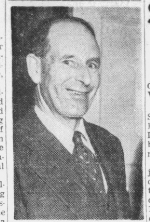
Bill Lash
Alpine Mishaps
Reported in The Daily Colonist Friday December 31, 1954. p.10.
The Alberni’s made front-page news across the country with three mountain accidents during the year. Land and air rescue crews brought out survivors of an expedition on Mount Septimus where Ralph Rosseau lost his life in a snow slide. A protracted search located the wreckage of an RCAF plane and the bodies of four air force men on Mount Arrowsmith. And in November volunteer rescue squads brought Charles Faulkner of Victoria down the steep slopes of Mount Arrowsmith after he broke his leg at the 5,000-foot level.
Mountain Rescue on The West Coast
Reported in The Canadian Alpine Journal Volume 38, 1955, p.77-79.
By Paddy Sherman
. . . The next trip was more spectacular, and just what the group exists for. On October 10, 1954 and RCAF Expediter with four men aboard vanished near Mt. Arrowsmith while on a routine flight. The German climbers, Ulf and Adolf Bitterlich, of Port Alberni, had been climbing on the mountain in thick weather, and pinpointed the spot where they thought the crash occurred. But all-out air search had revealed no trace. The RCAF decided it would not be safe to put their own untrained men into the ice-slicked rocky cirque where the Bitterlich’s thought the plane lay. So Flight-Sergeant John W. (Red) Jameson, head of the RCAF ‘s para-rescue section in Vancouver, asked for squad men. This time the group was: Jack Atkinson, Dave Blair, Peter Thomas, Keith Ingold and Paddy Sherman. They arrived at the airport in the dark within two hours of the call on October 12, and landed at RCAF station Comox on Vancouver Island just after midnight. The Bitterlich’s and Jameson briefed them. Next morning at daylight they took off in the big Sikorski S-55 helicopter. At Parksville, at the foot of the mountain, the party split, and was flown in pairs in ‘copters of the RCAF and U.S. Coastguard. These first made a detailed search of the peak—including a thorough look at the spot where the wreckage was eventually found. Then as the helicopters hovered in a stiff breeze about 10 feet above a rocky col about 5,000 feet high, the party leaped out. Luck and a very fine piece of work by Ulf Bitterlich led to success within an hour. He and Atkinson were first to land, and when Ingold and Sherman joined them, Bitterlich showed, through binoculars, a thin wavy line in snow about 400 yards away. All four looked, and used two rocks in a diamond-shaped cluster as a guide line. There was time to spare while waiting for the third group, so Bitterlich and Ingold moved off for a closer look at the line. As they crossed fairly steep, ice-coated “rocks” in the diamond were in fact pieces of wreckage coated with ice-feathers. The line was a half-buried propeller. The whole party went over, and found the main wreckage in a small bergschrund. All aboard had died instantly when the plane slammed into a cliff. The party retrieved log books and numbered the equipment, then returned. By early afternoon all except the Bitterlich’s were back in Parksville, after some hectic struggle to pull themselves into the helicopters. The Bitterlich’s stayed with the RCAF, and cut steps in the ice for an RCAF party to reach the wreck and remove the bodies. More trouble was still to come, however. On November 7 two Victoria climbers went to see the scene. One broke his leg on the cliffs above. His companion tied him to a rock, then dashed down for aid. Luckless Ulf Bitterlich again went to the rescue, with Leo Lynn, 16, also of Port Alberni. They climbed through the darkness to reach the injured man, then, as they were within a few feet of him, the wind blew down a rock onto the youngster’s head. So Bitterlich spent the night close to the summit with two injured on his hands. Lynn managed to make his way out with an RCAF escort next day. Bitterlich stayed to supervise the difficult rescue, helped by RCAF, RCMP and other volunteers. His fellow-townsfolk were so impressed with his conduct on these occasions, and in a previous fatal accident on Mt. Septimus, that they had recommended, at the time of writing this, that the Royal Humane Society should honor him with an award.
